|
Meinem Lehrer und Freund Prof. Dr. Heinrich von Stietencron ist die gesamte Amarakośa-Übersetzung in Dankbarkeit gewidmet. |
Zitierweise | cite as: Amarasiṃha <6./8. Jhdt. n. Chr.>: Nāmaliṅgānuśāsana (Amarakośa) / übersetzt von Alois Payer <1944 - >. -- 2. Dvitīyaṃ kāṇḍam. -- 15. vaiśyavargaḥ (Über Vaiśyas). -- 5. Vers 34c - 44c (Kochen II: Gemüse, Gewürze). -- Fassung vom 2012-07-13. -- URL: http://www.payer.de/amarakosa7/amara215e.htm
Erstmals hier publiziert: 2011-07-13
Überarbeitungen:
©opyright: Creative Commons Lizenz (Namensnennung, keine kommerzielle Nutzung, share alike)
Dieser Text ist Teil der Abteilung Sanskrit von Tüpfli's Global Village Library
|
Meinem Lehrer und Freund Prof. Dr. Heinrich von Stietencron ist die gesamte Amarakośa-Übersetzung in Dankbarkeit gewidmet. |
Falls Sie die diakritischen Zeichen nicht dargestellt bekommen, installieren Sie eine Schrift mit Diakritika wie z.B. Tahoma.
Die Devanāgarī-Zeichen sind in Unicode kodiert. Sie benötigen also eine Unicode-Devanāgarī-Schrift.
Bei der Identifikation der lateinischen Pflanzennamen folge ich, wenn immer es möglich ist:
Bhāvamiśra <16. Jhdt.>: Bhāvaprakāśa of Bhāvamiśra : (text, English translation, notes, appendences and index) / translated by K. R. (Kalale Rangaswamaiah) Srikantha Murthy. -- Chowkhamba Varanasi : Krishnadas Academy, 1998 - 2000. -- (Krishnadas ayurveda series ; 45). -- 2 Bde. -- Enthält in Bd. 1 das SEHR nützliche Lexikon (nigaṇṭhu) Bhāvamiśras.
Pandey, Gyanendra: Dravyaguṇa vijñāna : materia medica-vegetable drugs : English-Sanskrit. -- 3. ed. -- Varanasi : Chowkhamba Krishnadas Academy, 2005. -- 3 Bde. ; 23 cm. -- ISBN: 81-218-0088-9 (set)
Wo möglich, erfolgt die aktuelle Benennung von Pflanzen nach:
Zander, Robert <1892 - 1969> [Begründer]: Der große Zander : Enzyklopädie der Pflanzennamen / Walter Erhardt ... -- Stuttgart : Ulmer, ©2008. -- 2 Bde ; 2103 S. -- ISBN 978-3-8001-5406-7.
 WARNUNG: dies
ist der Versuch einer Übersetzung und Interpretation eines altindischen
Textes. Es ist keine medizinische Anleitung. Vor dem Gebrauch aller hier
genannten Pflanzen wird darum ausdrücklich gewarnt. Nur ein erfahrener, gut
ausgebildeter ayurvedischer Arzt kann Verschreibungen und Behandlungen
machen! Die Bestimmung der Pflanzennamen beruht weitgehend auf Vermutungen
kompetenter Āyurvedaspezialisten.
WARNUNG: dies
ist der Versuch einer Übersetzung und Interpretation eines altindischen
Textes. Es ist keine medizinische Anleitung. Vor dem Gebrauch aller hier
genannten Pflanzen wird darum ausdrücklich gewarnt. Nur ein erfahrener, gut
ausgebildeter ayurvedischer Arzt kann Verschreibungen und Behandlungen
machen! Die Bestimmung der Pflanzennamen beruht weitgehend auf Vermutungen
kompetenter Āyurvedaspezialisten.

Abb.: Zubereitung von Chapatis (चपाती)
an den heißen Quellen von Manikarna, Mandi - मंडी, Himachal Pradesh
[Bildquelle: Asian Curator at The San Diego Museum of
Art. --
http://www.flickr.com/photos/asianartsandiego/4837863117/. -- Zugriff am
2011-06-24. --
Creative Commons Lizenz (Namensnennung, keine kommerzielle Nutzung,
keine Bearbeitung)]
| 34c./d. astrī śākaṃ haritakaṃ śigrur asya tu nāḍikā अस्त्री शाकं हरितकं शिग्रुर् अस्य तु नाडिका ।३४ ख। [Bezeichnungen für Gemüse:]
|
Colebrooke (1807): "A potherb."
Der Bhāvaprakāśa (I, 6) nennt folgende śāka:
patra-śāka n. -
Blätter-Gemüse
vāstuka n.: Chenopodium album L. 1753 - Gewöhnlicher Weißer Gänsefuß
potakī f.: Basella alba L. 1753 - Indischer Spinat - Malabar Nightshade
māriṣa m.: Amaranthus blitum L. 1753 - Fuchsschwanz - Amaranth
taṇḍulīyaka m.: Amaranthus spinosus L. - Dorniger Fuchsschwanz - Thorny Amaranth
pālakyā f.: Spinacia oleracea L. 1753 - Spinat - Spinach
kāla-śāka n.: Corchorus capsularis L. 1753 - Rundkapsel-Jute - White Jute
paṭṭa-śāka m.: Corchorus olitorius L. 1753 - Langkapsel-Jute - Nalta Jute
kalambī f.: Ipomoea aquatica Forssk. 1775 - Wasserspinat - Water Spinach
loṇī f.: Portulaca quadrifida L. 1767 - Chickenweed
ghoṭikā f.: Portulaca oleracea L. 1753 - Portulak - Garden Purslane
cāṅgerī f.: Oxalis corniculata L. 1753 - Hornfrüchtiger Sauerklee - Yellow Sorrel
cukrikā f.: Rumex vesicarius L. 1753 - Indischer Sauerampfer - Bladder Dock
cañcukī f.: Corchorus fascicularis Lam. 1786 - Grubweed
hilamocikā f.: Enhydra fluctuans Lour. - Water Cress
śitivāra m.: Marsilea minuta L. - Dwarf Waterclover
mūlaka-patra n.: Blätter von Raphanus sativus L. 1753 - Rettich - Radish
droṇapuṣpī f.: Leucas cephalotes (Roth) Spreng. 1825
yavāni-śāka n.: Blätter von Trachyspermum ammi (L.) Sprague 1929 - Indischer Kümmel - Kummel
dadrughna-patra n.: Blätter von Cassia tora L. 1753
sehuṇḍa-dala n.: Blätter von Euphorbia sp. - Wolfsmilch - Spurge
parpaṭa m.: Fumaria indica (Hausskn.) Pugsley 1919
gojihvā f.: Onosma bracteatum Wall. 1824
paṭola-patra n.: Blätter von Trichosanthes dioica Roxb. 1832
guḍūcī-patra n.: Blätter von Tinospora malabarica Miers 1851
kāsamarda m.: Cassia occidentalis L. 1753 - Negro Coffee
caṇaka-śāka n.: Blätter von Cicer arietinum L. 1753 - Kichererbse - Chick Pea
kalāya-śāka n.: Blätter von Lathyrus sativus L. 1840 - Saat-Platterbse - Chickling Pea
sārṣapa-śāka n.:
Blätter von Brassica rapa subsp. rapa L. -
Stoppel-Rübe - Turnip
puṣpa-śāka n.:
Blüten-Gemüse
agasti-puṣpa n.: Blüten von Sesbania grandiflora (L.) Pers. 1807 - Großblütige Sesbanie - Wisteria Tree
kadalī-puṣpa n.: Blüten von Musa x paradisiaca L. 1753 - Ess-Banane - Plantain
śigru-puṣpa n.: Blüten von Moringa oleifera Lam. 1783 - Meerrettichbaum - Horseradish Tree
śālmalī-puṣpa n.:
Blüten von Bombax ceiba L. 1753 - Roter Seidenwollbaum -
Bombax
phala-śāka n.:
Frucht-Gemüse
kūṣmāṇḍa n.: Benincasa hispida (Thunb. ex Murray) Cogn. 1881 - Wachs-Kürbis - Wax Gourd
kūṣmāṇḍī f.: Cucurbita pepo L. 1753 - Zucchini
alābū f.: Lagenaria siceraria (Molina) Standl. 1930 - Flaschenkürbis - Calabash Gourd
kaṭutumbī f.: Lagenaria siceraria (Molina) Standl. 1930 - Flaschenkürbis - Bitter Gourd
karkaṭī f.: Cucumis melo L. 1753 Conomon Grp. - Gemüse-Melone - Oriental Pickling Melon
ciciṇḍā f.: Trichosanthes cucumerina var. anguina (L.) Haines 1922 - Weiße Schlangenhaargurke - Snake Gourd
kāravella n.: Momordica charantia L. 1753 - Balsambirne - Bitter Melon
mahākośātakī f.: Luffa aegyptiaca Mill. 1768 - Schwammgurke - Loofah
rājakośātakī f.: Luffa acutangula (L.) Roxb. 1832 - Gerippte Schwammgurke - Angled Loofah
paṭola m.: Trichosanthes dioica Roxb. 1832
bimbī f.: Coccinia grandis (L.) Voigt 1845 - Große Scharlachranke - Ivy Gourd
pustaśimbī f., śimbī f.: Lablab purpureus (L.) Sweet 1826 - Faselbohne - Lablab
kolaśimbī f.: ?
śobhāñjana-phala n.: Früchte von Moringa oleifera Lam. 1783 - Meerrettichbaum - Horseradish Tree
vṛntāka n.: Solanum melongena L. 1753 - Aubergine - Eggplant
ḍiṇḍiśa m.: Praecitrullus fistulosus (Stocks) Pangalo 1944
piṇḍāra n.: Tamilnadia uliginosa (Retz.) Tirveng. & Sastre 1979
karkoṭī f.: Momordica dioica Roxb. 1805
ḍoḍikā f.: "not correctly identified"
kaṇakārī-phala n.:
Früchte von Solanum surattense Burm. 1768
nāla-śāka n.:
Stängel-Gemüse
sārṣapa-nāla n.:
Stängel von Blätter von Brassica rapa subsp. rapa L. -
Stoppel-Rübe - Turnip
kanda-śāka n.:
Wurzel-Gemüse
sūraṇa n.: Amorphophallus paeoniifolius (Dennst.) Nicolson 1977 - Elefantenkartoffel - Telingo Potato
āluka n.: Dioscorea sp. L. 1753 - Yamswurzel - Yam
mūlaka n.: Raphanus sativus L. 1753 - Rettich - Radish
gṛñjana n.: Daucus carota subsp. sativus (Hoffm.) Schübl. et G. Martens - Karotte - Carrot
kadalī-kanda m.: Wurzeln von Musa x paradisiaca L. 1753 - Ess-Banane - Plantain
māna-kanda m.: Alocasia macrorrhizos (L.) G. Don 1839 - Riesenblättriges Pfeilblatt - Giant Taro
vārāhī-kanda m.: Dioscorea bulbifera L. 1753 - Yamswurzel - Air Potato
hastikarṇā f.: Leea macrophylla Roxb. ex Hornem. 1813
kemuka n.: Costus speciosus (J. König) Sm. 1791 - Prächtige Kostwurz - Malay Ginger
kaseru n.: Actinoscirpus grossus (L. f.) Goetgh. & D. A. Simpson var. kysoor (Roxb.) Noltie 1994
śāluka n.:
Wurzeln von Nelumbo nucifera Gaertn. 1788 - Indischer Lotus -
Lotus
saṃsvedaja-śāka n.: aus
(Boden-)Schweiß entstandenes Gemüse = Pilze
bhūmicchatra n. / śikīndhraka n.: Agaricus campestris L. 1753 - Wiesenchampignon - Field Mushroom
शाक - śāka m., n.: Gemüse
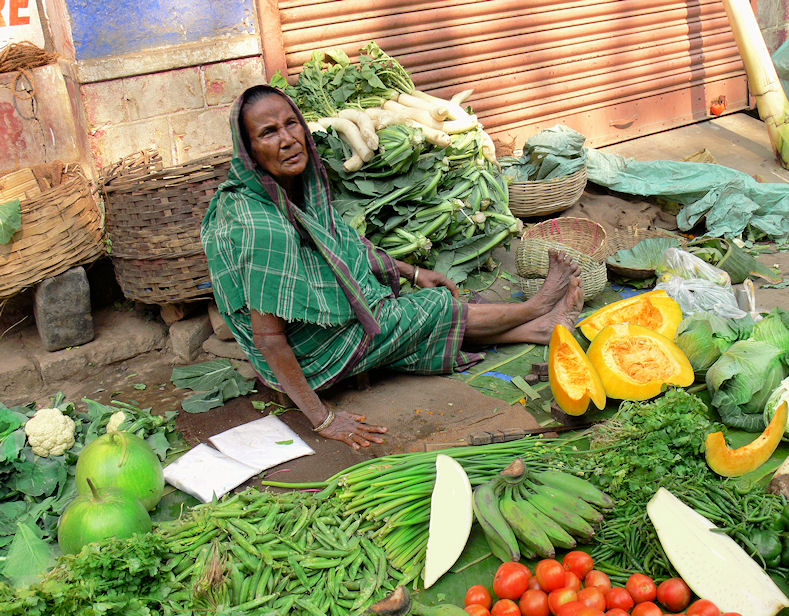
Abb.: शाकाः । Kolkata - কলকাতা,
West Bengal
[Bildquelle: Donna Winton. --
http://www.flickr.com/photos/dwinton/396094294/. -- Zugriff am
2011-07-10. --
Creative Commons Lizenz (Namensnennung, keine kommerzielle Nutzung)]
हरितक - haritaka n.: Grünzeug, Gras, Gemüse
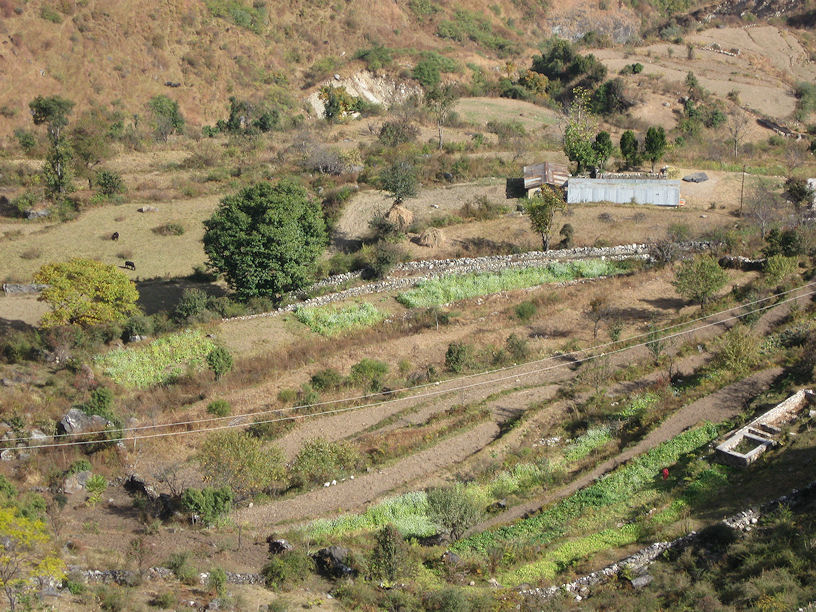
Abb.: हरितकम् । Gemüsefelder, Raithal - रैथल, Uttarakhand
[Bildquelle: Trees for the Future. --
http://www.flickr.com/photos/plant-trees/4478895427/. -- Zugriff am
2011-07-10. --
Creative Commons Lizenz (Namensnennung)]
शिग्रु - śigru m.:
Moringa oleifera Lam. 1783 - Meerrettichbaum - Horse radish Tree (Blätter und Blüten davon dienen als Gemüse), GemüseMoringa: Moringaceae - Bennussgewächse

Abb.: शिग्रुः । Moringa oleifera Lam. 1783 - Meerrettichbaum -
Horseradish Tree
[Bildquelle: Icones plantarum rariorum / editae Nicolao Josepho Jacquin. --
Vol. 3. -- 1786 - 1793. -- Tab. 461]
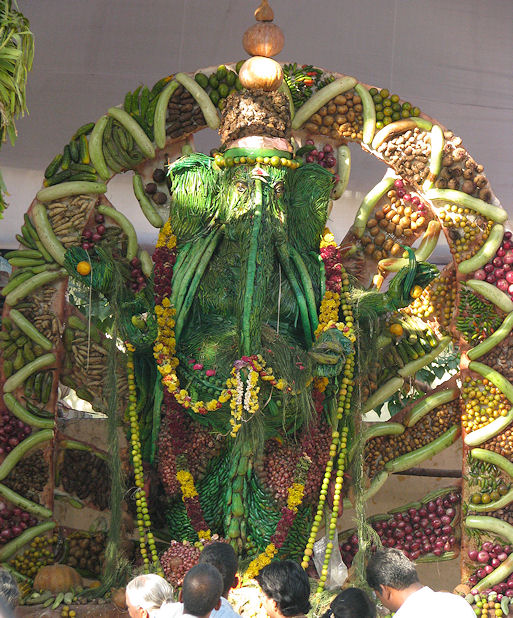
Abb.: शिग्रवः । Gaṇeśa-Statue aus Gemüse, Gaṇeśa Caturthī - गणेशचतुर्थी -
விநாயக சதுர்த்தி, Chennai - சென்னை,
Tamil Nadu
[Bildquelle: McKay Savage. --
http://www.flickr.com/photos/mckaysavage/3058676351/. -- Zugriff am
2011-07-10. --
Creative Commons Lizenz (Namensnennung)]
| 34c./d. astrī śākaṃ haritakaṃ śigrur asya tu nāḍikā 35a./b. kalambaś ca kaḍambaś ca veṣavāra upaskaraḥ
अस्त्री शाकं हरितकं शिग्रुर् अस्य तु नाडिका
।३४ ख। Der Stängel (nāḍikā f.: Röhre) von Gemüse heißt:
|
Colebrooke (1807): "Its stalk."
कलम्ब - kalamba m.: Stängel einer Gemüsepflanze
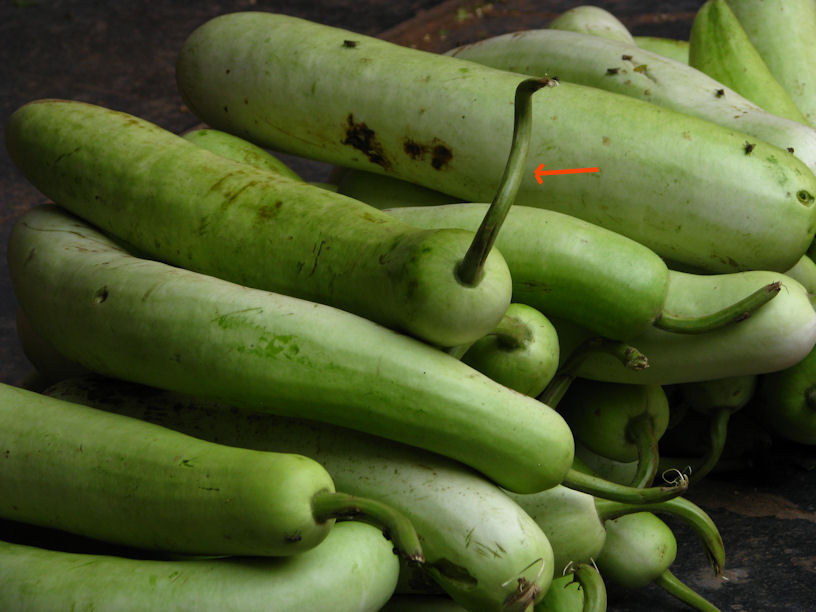
Abb.: कलम्बाः । Chennai - சென்னை,
Tamil Nadu
[Bildquelle: McKay Savage. --
http://www.flickr.com/photos/mckaysavage/3986989108/. -- Zugriff am
2011-07-10. --
Creative Commons Lizenz (Namensnennung)]
कडम्ब - kaḍamba m.: Stängel einer Gemüsepflanze
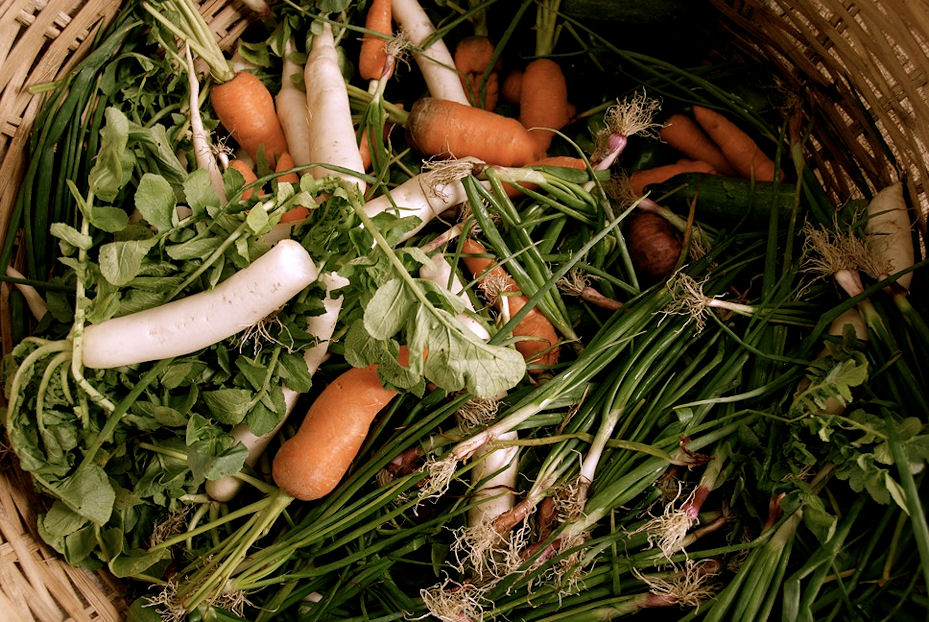
Abb.: कडम्बाः । Guwahati -
গুৱাহাটী, Assam
[Bildquelle: nalin a. --
http://www.flickr.com/photos/nalinandworld/2602469146/. -- Zugriff am
2011-07-10. --
Creative Commons Lizenz (Namensnennung, keine kommerzielle Nutzung,
keine Bearbeitung)]
| 35a./b. kalambaś ca kaḍambaś ca veṣavāra upaskaraḥ कलम्बश् च कडम्बश् च वेषवार उपस्करः ।३५ क। [Bezeichnungen für Zutat, Gewürz:]
|
Colebrooke (1807): "A condiment."
उपस्कर - upaskara m.: Zutat, Zubehör, Gerät, Gewürz
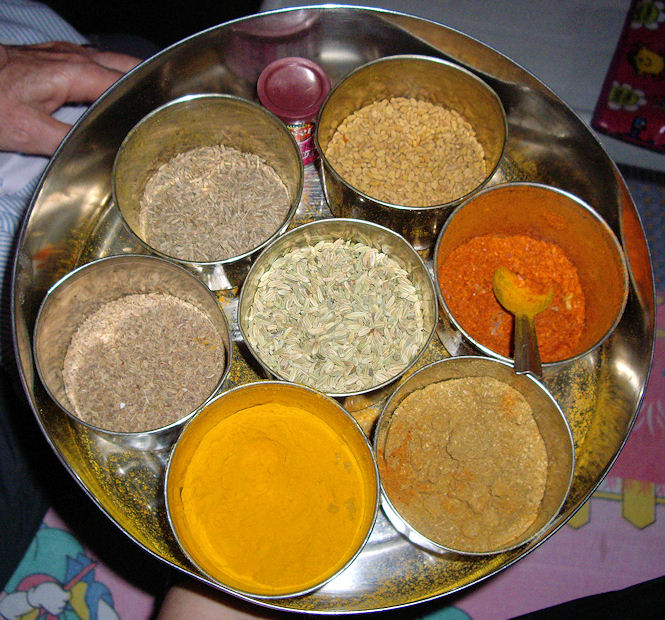
Abb.: उपस्कराः । Orcha - ओरछा, Madhya Pradesh
[Bildquelle: krebsmaus07. --
http://www.flickr.com/photos/koadla/5105341568/. -- Zugriff am
2011-07-11. --
Creative Commons Lizenz (Namensnennung)]
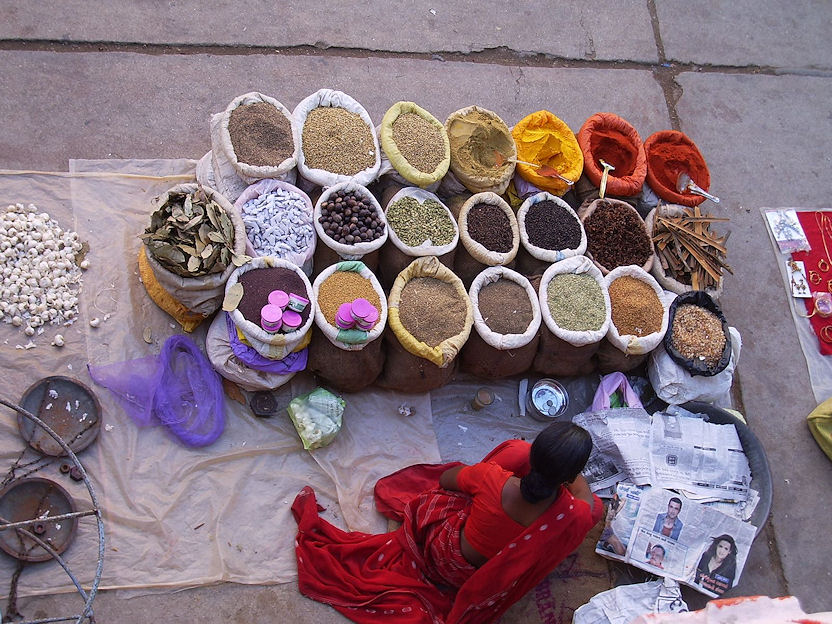
Abb.: उपस्कराः । Diu - दीव, Daman & Diu
[Bildquelle: Gerardo Diego
Ontiveros. --
http://www.flickr.com/photos/germeister/297636465/. -- Zugriff am
2011-07-11. --
Creative Commons Lizenz (Namensnennung, keine kommerzielle Nutzung,
keine Bearbeitung)]
Tamarindus: Caesalpiniaceae - Johannisbrotgewächse
Garcinia: Clusiaceae
| 35c./d. tintiḍīkaṃ ca cukraṃ ca vṛkṣāmlam atha vellajam तिन्तिडीकं च चुक्रं च वृक्षाम्लम् अथ वेल्लजम् ।३५ ख। [Bezeichnungen für eine saure Brühe, insbes. Brühe von Tamarindus indica L. 1753 - Tamarinde - Tamarind bzw. von Garcinia indica (Thouars) Choisy 1824 - Mangostane - Mangosteen:]
|
Colebrooke (1807): "Acid seasoning."
तिन्तिडीक - tintiḍīka n.: Frucht von Tamarindus indica L. 1753 - Tamarinde - Tamarind, eine saure Brühe, insbes. von Tamarindenfrucht
चुक्र - cukra n.: Fruchtessig, eine saure Brühe, insbes. aus der Frucht von Tamarindus indica L. 1753 - Tamarinde - Tamarind
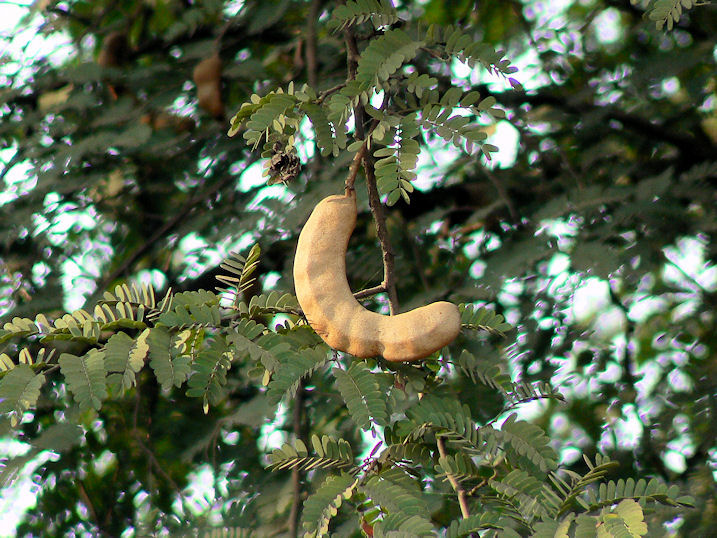
Abb.: तिन्तिडीकम् । Frucht
von Tamarindus indica L. 1753 - Tamarinde - Tamarind
[Bildquelle: dinesh_valke. --
http://www.flickr.com/photos/dinesh_valke/2174726661/. -- Zugriff am
2010-10-13. --
Creative
Commons Lizenz (Namensnennung, keine kommerzielle Nutzung, keine
Bearbeitung)]
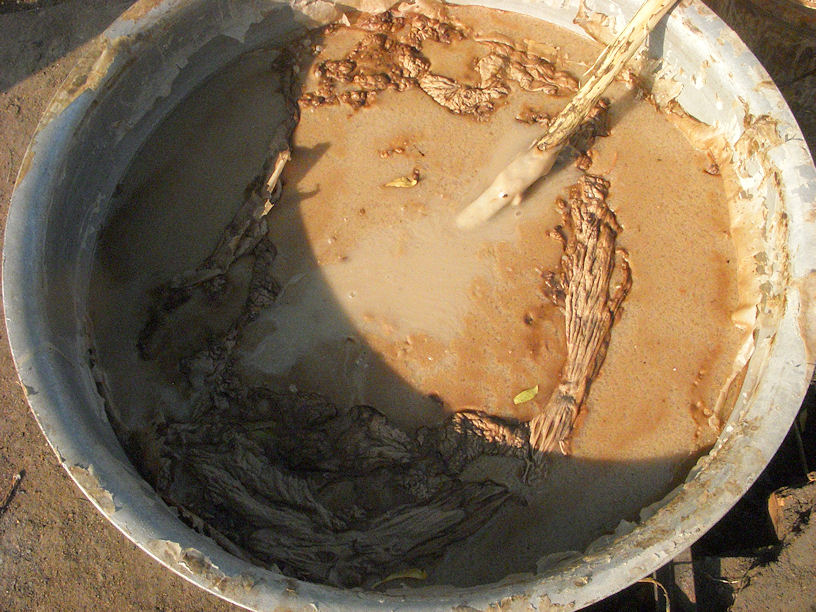
Abb.: तिन्तिडीकम् । Mus von
Tamarindus indica L. 1753 - Tamarinde - Tamarind, Indien
[Bildquelle: Rick Bradley. --
http://www.flickr.com/photos/rickbradley/4271306325/. -- Zugriff am
2011-07-11. --
Creative Commons Lizenz (Namensnennung)]
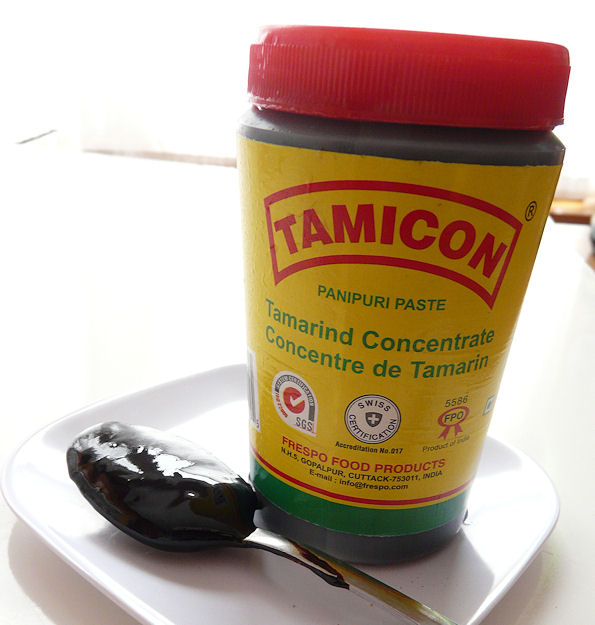
Abb.: चुक्रम् । Tamarinden-Konzentrat, Cuttack - କଟକ, Orissa
[Bildquelle: Emily Barney. --
http://www.flickr.com/photos/ebarney/5502513817/. -- Zugriff am
2011-07-11. --
Creative Commons Lizenz (Namensnennung, keine kommerzielle Nutzung)]
"Tamarindus Indica (Linn.) N. O. Leguminosae. Tamarind or Indian Date
Description.--Tree, 80 feet; [...]
Fl. May-June.
W. & A. Prod. i. 285.--Roxb. Fl. Ind. iii. 215. -- Rheede i. 23.
Peninsula. Bengal.
Medical Uses.—The pulp of the pods is used both in food and in medicine. It has a pleasant juice, which contains a larger proportion of acid with the saccharine matter than is usually found in acid fruit. Tamarinds are preserved in two ways : first, by throwing hot sugar from the boiler on the ripe pulp; but a better way is to put alternate layers of tamarinds and powdered sugar into a stone jar. By this means they preserve their colour, and taste better. They contain sugar, mucilage, citric acid, tartaric and malic acids. In medicine, the pulp taken in quantity of half an ounce or more proves gently laxative and stomachic, and at the same time quenches the thirst. It increases the action of the sweet purgatives cassia and manna, and weakens that of resinous cathartics. The seed is sometimes given by the Yytians in cases of dysentery, and also as a tonic, and in the form of an electuary. In times of scarcity the poor eat the tamarind-stones. After being roasted and soaked for a few hours in water, the dark outer skin comes off, and they are thon boiled or fried. In Ceylon, a confection prepared with the flowers is supposed to have virtues in obstructions of the liver and spleen. A decoction of the acid leaves of the tree is employed externally in cases requiring repellent fomentation. They are also used for preparing collyria, and taken internally are supposed a remedy in jaundice. The natives have a prejudice against sleeping under the tree, and the acid damp does certainly affect the cloth of tents if they are pitched under them for any length of time. Many plants do not grow under its shade, but it is a mistake to suppose that this applies to all herbs and shrubs. In sore-throat the pulp has been found beneficial as a powerful cleanser. The gum reduced to fine powder is applied to ulcers; the leaves in infusion to country sore eyes and foul ulcers. The stones, pulverised and made into thick paste with water, have the property when applied to the skin of promoting suppuration in indolent boils.—A indie. Thornton. Don,
Economic Uses.—The timber is heavy, firm, and hard, and is converted to many useful purposes in building. An infusion of the leaves is used in Bengal in preparing a fine fixed yellow dye, to give those silks a green colour which have been previously dyed with indigo. Used also simply as a red dye for woolen stuffs. In S. India a strong infusion of the fruit mixed with sea-salt is used by silversmiths in preparing a mixture for cleaning and brightening silver. The pulverised seeds boiled into a paste with thin glue form one of the strongest wood-cements. The tree is one of those preferred for making charcoal for gunpowder—(Lindley. Roxb.). The tree is of slow growth, but is longer-lived than most trees. The timber is used for mills and the teeth of wheels, and whenever very hard timber is requisite. It is much prized as fuel for bricks. Its seeds should be sown where it is to remain, and it may be planted in avenues alternately with short-lived trees of quicker growth. From the liability of this tree to become hollow in the centre, it is extremely difficult to get a tamarind-plank of any width.—(Best's Report to Bomb. Govt., 1863.) There is a considerable export trade of tamarinds from Bombay and Madras. In 1869-70 were exported from the latter Presidency 10,071 cwt., valued at Es. 33,009 ; and from the former 6232 cwt., valued at Rs. 26,209.—Trade Reports."
[Quelle: Drury, Heber <1819 - 1872>: The useful plants of India : with notices of their chief value in commerce, medicine, and the arts. -- 2d ed. with additions and corrections. London : Allen, 1873. -- xvi, 512 p. ; 22 cm. -- s.v.]
"TAMARINDUS INDICA, Linn. [...]
History, Uses, &C—There would appear to be little doubt that the Tamarind tree is a native of some part of India, probably the South. It is found in a cultivated or semi-cultivated state almost everywhere, and the fruit, besides being an important article of diet, is valued by the Hindus as a refrigerant, digestive, carminative and laxative, useful in febrile states of the system, costiveness, &c. The ashes of the burnt suber are used as an alkaline medicine in acidity of the urine and gonorrhoea, the pulp and also the leaves (puliyam-gali, Tam.), are applied externally in the form of a poultice to inflammatory swellings.
The Sanskrit names of the Tamarind are Tintidi and Amlika. The word 'Tamarind' appears to be derived from the Arabic Tamar-Hindi (Indian date), and it was doubtless through the Arabians that a knowledge of the fruit passed during the Middle Ages into Europe, where, until correctly described by Garcia d'Orta, it was supposed to be produced by a kind of Indian palm.
The author of the Makhzan-el-Adwiya describes two kinds, viz., the red, small-seeded Guzerat variety, and the common reddish brown. The first is by far the best. Mahometan physicians consider the pulp to be cardiacal, astringent and aperient, useful for checking bilious vomiting, and for purging the system of bile and adust humours; when used as an aperient it should be given with a very small quantity of fluid. A gargle of Tamarind water is recommended in sore throat. The seeds are said to be a good astringent, boiled they are used as a poultice to boils, pounded with water they are applied to the crown of the head in cough and relaxation of the uvula. The leaves crushed with water and expressed yield an acid fluid, which is said to be useful in bilious fever, and scalding of the urine; made into a poultice they are applied to reduce inflammatory swellings and to relieve pain. A poultice of the flowers is used in inflammatory affections of the conjunctiva; their juice is given internally for bleeding piles. The bark is considered to have astringent and tonic properties. (Makhzan-el-Adwiya.)
The natives consider the acid exhalations of the Tamarind tree to be injurious to health, and it is stated that the cloth of tents allowed to remain long under the trees becomes rotten. Plants also are said not to grow under them, but this is not universally the case, as we have often seen fine crops of Andrographis paniculata and other shade loving plants growing under Tamarind trees. Mr. J. G. Prebble has brought to our notice a peculiar exudation from an old tamarind tree. It consists almost entirely of oxalate of calcium, and flows from the tree in a liquid or syrupy state, but afterwards dries into white crystalline masses."
[Quelle: Pharmacographia indica : a history of the principal drugs of vegetable origin met with in British India / by William Dymock [1834-1892], C. J. H. Warden and David Hooper [1858-1947]. -- Bd. 1. -- London, 1890. -- S. 532f.]
वृक्षाम्ल - vṛkṣāmla n.: Frucht von Garcinia indica (Thouars) Choisy 1824 - Mangostane - Mangosteen
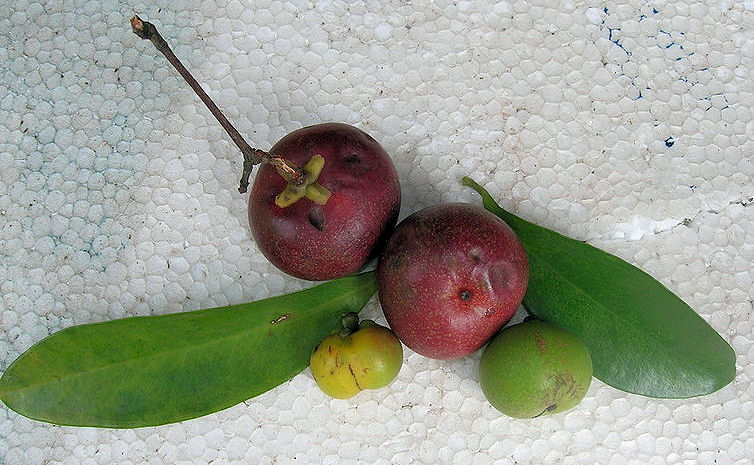
Abb.: वृक्षामानि । Garcinia indica (Thouars) Choisy 1824 - Mangostane
- Mangosteen
[Bildquelle: Subray Hegde / Wikimedia. --
Creative
Commons Lizenz (Namensnennung)]
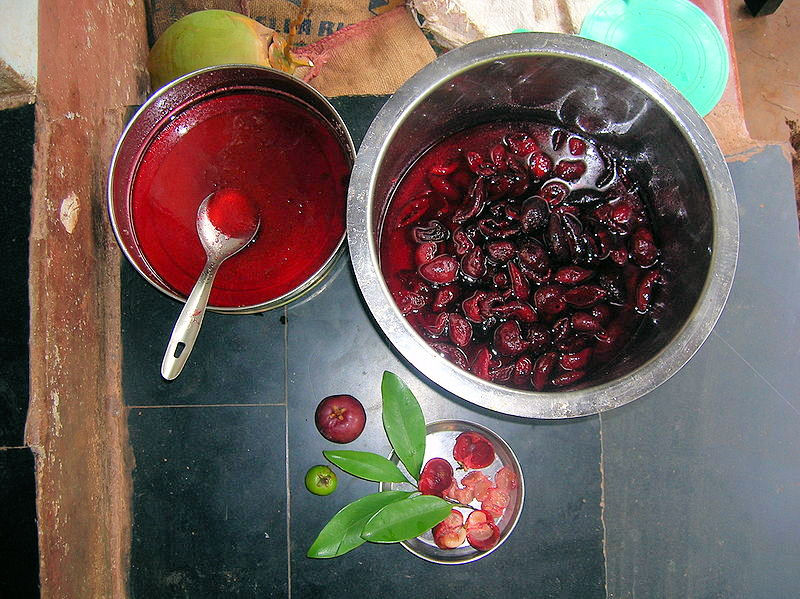
Abb.: वृक्षाम्लम् । Garcinia indica (Thouars) Choisy 1824 -
Mangostane - Mangosteen
[Bildquelle: Subray Hegde / Wikimedia. --
Creative
Commons Lizenz (Namensnennung)]
"GARCINIA INDICA, Chois.
Fig.—Bent, and Trim., t. 32; Wight Ill. I, 125, Red Mango (Eng.), Garcinia a fruit acide (Fr.).
Hab.—Western Peninsula, Amboyna.
The fruit, seeds, and bark.
[...]
History, Uses, &c.—The tree is common on the Western coast between Damaun and Goa ; it grows wild upon the hills of the Concan, but is often to be seen in gardens close to the sea. It flowers about Christmas, and ripens its fruit in April and May. The fruit is largely used all along the Western coast as an acid ingredient in curries, and is an article of commerce in the dry state. It is generally prepared by removing the seeds and drying the pulp in the sun: the latter is then slightly salted and is ready for the market. It is known as Amsul or Kokam, and was in use in the Bombay Army as an antiscorbutic in 1799. (Dr. White. ) In Goa the pulp is sometimes made into large globular or elongated masses. The seeds are pounded and boiled to extract the oil, which, on cooling, becomes gradually solid and is roughly moulded by hand into egg-shaped balls or concave-convex cakes. This is the substance known to Europeans as Kokam butter. The natives occasionally use it for cooking, but it is mostly valued on account of its soothing properties when used medicinally. The juice of the fruit is sometimes used as a mordant in dyeing, and the apothecaries of Goa prepare a very fine red syrup from it, which is used in bilious affections. Nothing seems to be known of the history of the Kokam fruit before the time of Garcia d'Orta (1568), who found it in use at Goa, under the name of Brindao (A corruption of the Marathi name भिरंड Bhirand), when he visited that city; the same name is still used by the native Christians. As it was an article of export in Garcia's time, there can be little doubt that it was used in Western India long before the Portuguese visited the country, just in the same manner as it is at the present day. The tree was known to Rumphius, who calls it Folium acidum majus or Groot Saurblad. He says the young leaves are acid like sorrel, and are used in cooking fish in Amboyna. Kokam butter appears to have first attracted the notice of Europeans about 1880 as a remedy for excoriations and chaps of the skin; in order to apply it, a piece is partially melted and rubbed upon the affected part. It is also of great value for the preparation of Nitrate of Mercury ointment, which if made in the usual manner is too fluid for hot climates ; Indian lard being very fluid, equal parts of it and Kokam oil will be found to make an ointment of good consistence and colour which keeps well. The bark is astringent, and the young leaves after having been tied up in a plantain leaf and stewed in hot ashes, are rubbed in cold milk and given as a remedy for dysentery."
[Quelle: Pharmacographia indica : a history of the principal drugs of vegetable origin met with in British India / by William Dymock [1834-1892], C. J. H. Warden and David Hooper [1858-1947]. -- Bd. 1. -- London, 1890. -- S. 163ff.]
Piperaceae - Pfeffergewächse
| 35c./d. tintiḍīkaṃ ca cukraṃ ca vṛkṣāmlam atha vellajam 36a./b. marīcaṃ kolakaṃ kṛṣṇam ūṣaṇaṃ dharmapattanam [Bezeichnungen für Piper nigrum L. 1753 - Echter Pfeffer - Black Pepper:] तिन्तिडीकं च चुक्रं च वृक्षाम्लम् अथ
वेल्लजम् ।३५ ख। [Bezeichnungen für Piper nigrum L. 1753 - Echter Pfeffer - Black Pepper bzw. Piper cubeba L. f. 1782 - Kubebenpfeffer - Tailed Pepper:]
|
Colebrooke (1807): "Pepper."
वेल्लज - vellaja n.: "aus einer Woge geboren" (wohl für valli-ja: "von einer Ranke entstanden"), Piper nigrum L. 1753 - Echter Pfeffer - Black Pepper
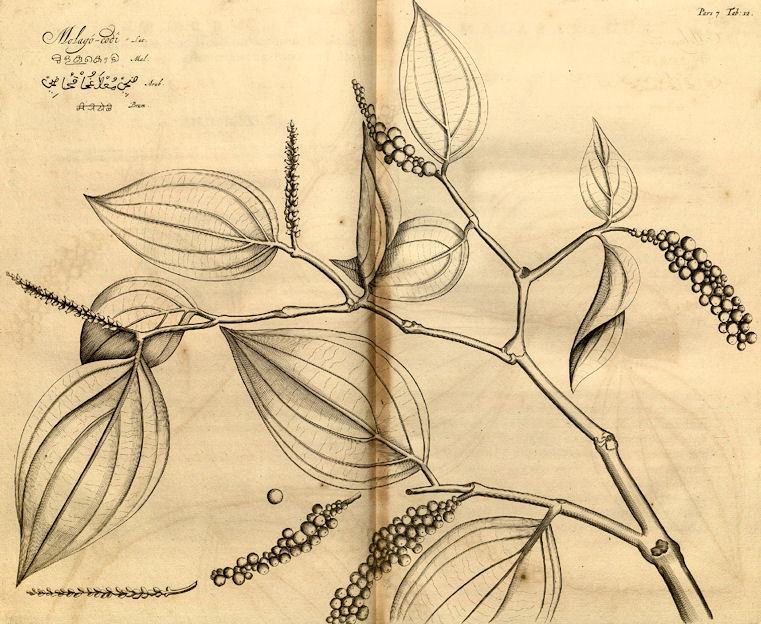
Abb.: वेल्लजम् । Piper nigrum L. 1753 - Echter Pfeffer - Black Pepper
[Bildquelle: Hortus malabaricus VII. Fig. 12,
1686]
मरीच - marīca n.: "Lichtstrahl", Piper nigrum L. 1753 - Echter Pfeffer - Black Pepper
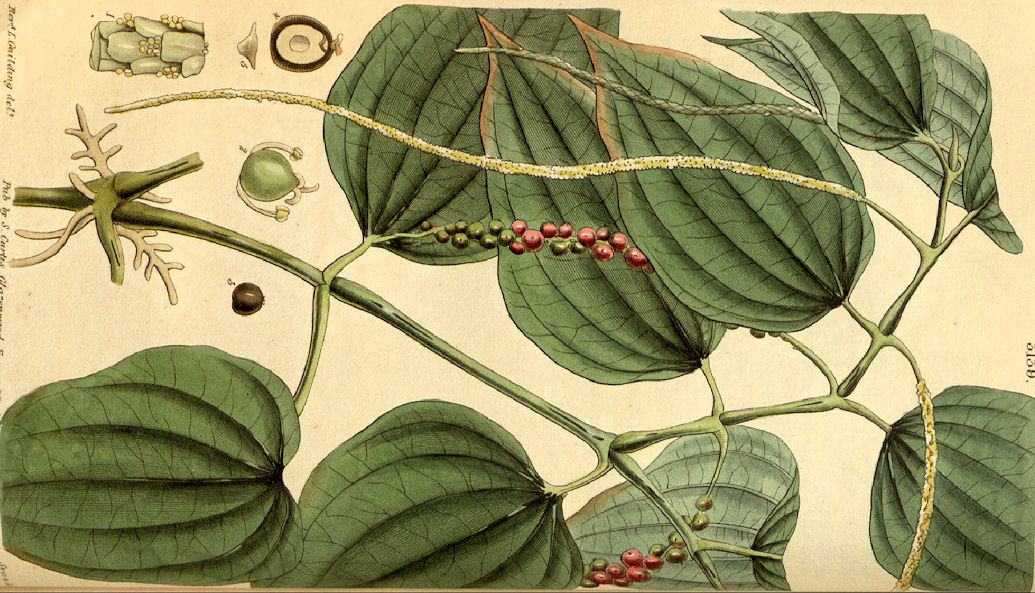
Abb.: मरीचम् । Piper nigrum L. 1753 - Echter Pfeffer - Black Pepper
[Bildquelle: Curtis's Botanical Magazine, v. 59 (1832), Tab. 3139]
कृष्ण - kṛṣṇa n.: Schwarzes, Piper nigrum L. 1753 - Echter Pfeffer - Black Pepper
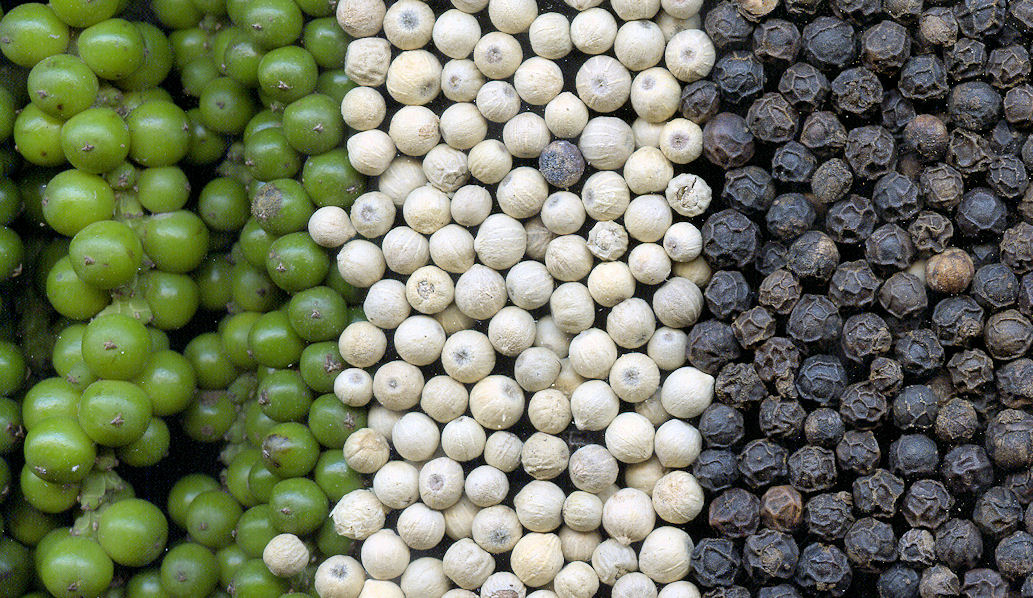
Abb.: कृष्णम् । Piper nigrum L. 1753 - Echter Pfeffer - Black Pepper
[Bildquelle: Rainer Zenz / Wikipedia. -- GNU FDLicense]
ऊषण - ūṣaṇa n.: Piper nigrum L. 1753 - Echter Pfeffer - Black Pepper
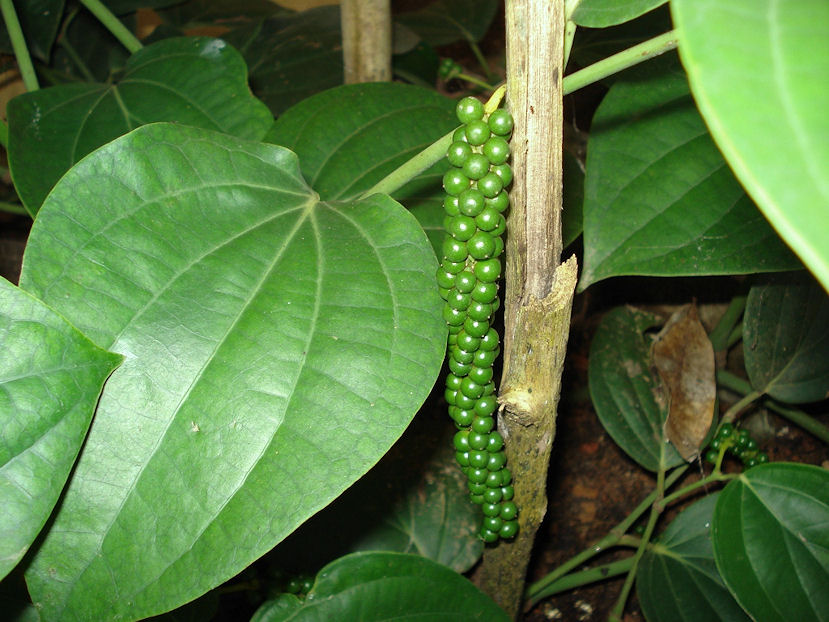
Abb.: ऊषणम् । Piper nigrum L. 1753 - Echter Pfeffer - Black Pepper,
Kerala
[Bildquelle: Aruna / Wikipedia. --
Creative
Commons Lizenz (Namensnennung, share alike)]
धर्मपत्तन - dharmapattana n.: "Stadt der buddhistischen Lehre" (= Śrāvastī) ; Piper nigrum L. 1753 - Echter Pfeffer - Black Pepper

Abb.: धर्मपत्तनम् ।
Lage von Śrāvasti
[Bildquelle: JIJITH NR / Wikimedia. -- GNU FDLicense]
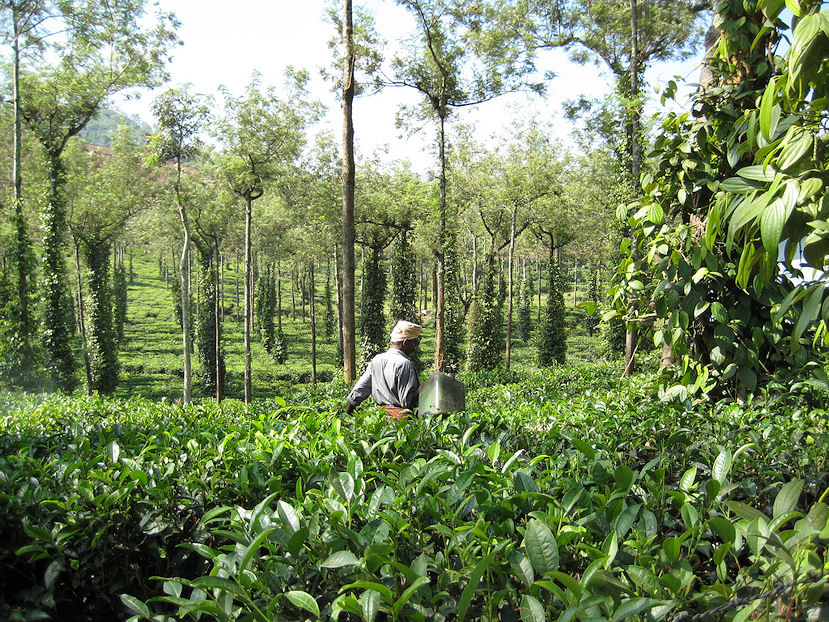
Abb.: धर्मपत्तनम् ।
Teeplantage mit Pfeffer (Piper nigrum L. 1753 - Echter Pfeffer -
Black Pepper) auf die Bäume rankend, Cardamom Hills - കാര്ടമോം ഹില്ല്സ്,
Kerala
[Bildquelle: mutaminx. --
http://www.flickr.com/photos/mutaminx/3219984319/. -- Zugriff am
2011-07-11. --
Creative Commons Lizenz (Namensnennung, keine kommerzielle Nutzung,
keine Bearbeitung)]
"Piper nigrum (Linn.) N. O. Piperaceae. Black-pepper vine
Description.—Stem shrubby, climbing, rooting, round; [...9
Wight Icon. 1934.—Roxb. Fl. Ind. I, 150.—Rheede, VII, t. 12.
Malabar forests. N. Circars.
Medical Uses.—Pepper contains an acrid soft resin, volatile oil, piperin, gum, bassorine, malic and tartaric acids, &c. ; the odour being probably due to the volatile oil, and the pungent taste to the resin. The berries medicinally used are given as stimulant and stomachic, and when toasted have been employed successfully in stopping vomiting in cases of cholera. The root is used as a tonic, stimulant, and cordial. A liniment is also prepared with them of use in chronic rheumatism. The watery infusion has been of use as a gargle in relaxation of the uvula. As a seasoner of food, pepper is well known for its excellent stomachic qualities. An infusion of the seeds is given as an antidote to arsenic, and the juice of the leaves boiled in oil externally in scabies. Pepper in over-doses acts as a poison, by over-exerting the inflammation of the stomach, and its acting powerfully on the nervous system. It is known to be a poison to hogs. The distilled oil has very little acrimony. A tincture made in rectified spirit is extremely hot and fiery. Pepper has been successfully used in vertigo, and paralytic and arthritic disorders.—Lindley. Ainslie.
Economic Uses.—The black-pepper vine is indigenous to the forests of Malabar and Travancore. For centuries pepper has been an article of exportation to European countries from the western coast of India. It was an article of the greatest luxury to the Romans during the Empire, and is frequently alluded to by historians. Pliny states its price in the Roman market as being 4s. 9d. a-lb. in English money. Persius gives it the epithet sacrum, as it were a thing to set a store by, so much was it esteemed. Even in later ages, so valuable an article of commerce was it considered, that when Attila was besieging Rome in the fifth century, he particularly named among other things in the ransom for the city about 3000 lb. of pepper. Although a product of many countries in the East, that which comes from Malabar is acknowledged to be the best.
Its cultivation is very simple, and is effected by cuttings or suckers put down before the commencement of the rains in June. The soil should be rich, but if too much moisture be allowed to accumulate near the roots, the young plants are apt to rot. In three years the vine begins to bear. They are planted chiefly in hilly districts, but thrive well enough in the low country in the moist climate of Malabar. They are usually planted at the base of trees which have rough or prickly bark, such as the jack, the erythrina, cashewnut, mango-tree, and others of similar description. They will climb about 20 or 30 feet, but are purposely kept lower than that. During their growth it is requisite to remove all suckers, and the vine should be pruned, thinned, and kept clean of weeds. After the berries have been gathered they are dried on mats in the sun, turning from red to black. They must be plucked before they are quite ripe, and if too early they will spoil. White-pepper is the same fruit freed from its outer skin, the ripe berries being macerated in water for the purpose. In this latter state they are smaller, of greyish-white colour, and have a less aromatic or pungent taste. The pepper-vine is very common in the hilly districts of Travancore, especially in the Cottayam, Meenachel, and Chenganacherry districts, where at an average calculation about 5000 candies are produced annually. It is one of the Sircar monopolies.
The greatest quantity of pepper comes from Sumatra. The duty on pepper in England is 6d. per lb., the wholesale price being 4d. per lb. White-pepper varies from ninepence to one shilling per lb. It may not be irrelevant here to notice the P. trioicum (Roxb.) which both Dr Wight and Miquel consider to be the original type of the P. nigrum, and from which it is scarcely distinct as a species. The question will be set at rest by future botanists. The species in question was first discovered by Dr. Roxburgh growing wild in the hills north of Samulcottah, where it is called in Teloogoo the Murial-tiga. It was growing plentifully about every valley among the hills, delighting in a moist rich soil, and well shaded by trees; the flowers appearing in September and October, and the berries ripening in March. Dr. R. commenced a large plantation, and in 1789 it contained about 40,000 or 50,000 pepper-vines, occupying about 50 acres of land. The produce was great, about 1000 vines yielding from 500 to 1000 lb. of berries. He discovered that the pepper of the female vines did not ripen properly, but dropped while green, and that when dried it had not the pungency of the common pepper; whereas the pepper of those plants which had the hermaphrodite and female flowers mixed on the same ament was exceedingly pungent, and was reckoned by the merchants equal to the best Malabar pepper.—Roxb. Simmonds. Wight Ainslie."
[Quelle: Drury, Heber <1819 - 1872>: The useful plants of India : with notices of their chief value in commerce, medicine, and the arts. -- 2d ed. with additions and corrections. London : Allen, 1873. -- xvi, 512 p. ; 22 cm. -- s.v.]
PIPER NIGRUM, Linn. Fig.—Miq. Ill. Pip. 50, t. 50; Bot. Mag., t. 3139; Bentl. and. Trim., t. 245;
Black Pepper
Hab.—Travancore and Malabar. Cultivated elsewhere. The fruit.
[...]
History, Uses, &c.—The earliest travellers from the West who visited India, found the pepper vine in cultivation on the Malabar Coast. Theophrastus (H. P. ix., 22) mentions two kinds of pepper (πιπερι or πεπερι) in the fourth century B. C., and Dioscorides (ii., 148) mentions λεθκον πεπερι, white pepper, μακρον πεπερι, long pepper, and μελαν πεπερι, black pepper. Pliny says:— "It is quite surprising that the use of pepper has come so much into fashion, seeing that in other substances which we use, it is sometimes their sweetness, and sometimes their appearance, that has attracted our notice; whereas, pepper has nothing in it that can plead as a recommendation to either fruit or berry, its only desirable quality being a certain pungency; and yet it is for this that we import it all the way from India! Who was the first to make trial of it as an article of food ? and who, I wonder, was the man that was not content to prepare himself, by hunger only, for the satisfying of a greedy appetite ?'' (12, 14.)
In the Periplus of the Erythrean Sea, written about A.D. 64, it is stated that pepper is exported from Baraké, the shipping place of Nelkunda. in which region, and there only, it grows in great quantity. These have been identified with places on the Malabar Coast between Mangalore and Calicut.
Long pepper and Black pepper are among the Indian spices on which the Romans levied duty at Alexandria about A.D.176.
Cosmas Indicopleustes, a merchant, and in later life a monk, who wrote about A.D. 540, appears to have visited the Malabar Coast, or at all events had some information about the pepper-plant from an eye-witness. It is he who furnishes the first particulars about it, stating that it is a climbing plant, sticking close to high trees like a vine. Its native country he calls Male. The Arabian authors of the Middle Ages, as Ibn Khurdadbah (circa A.D. 869-885), Edrisi in the middle of the 12th, and Ibn Batuta in the 14th century, furnished nearly similar accounts.
Among Europeans who described the pepper-plant with some exactness, one of the first was Benjamin of Tudela, who visited the Malabar Coast in A.D. 1166. Another was the Catalan friar, Jordanus, about 1330 ; he described the plant as something like ivy, climbing trees and forming fruit, like that of the wild vine. "This fruit," he says, "is at first green, then, when it comes to maturity, black." Nearly the same statements are repeated by Nicolo Conti, a Venetian, who, at the beginning of the 15th century, spent twenty-five years in the East. He observed the plant in Sumatra, and also described it as resembling ivy. (Pharmacographia.)
The high cost of pepper contributed to incite the Portuguese to seek for a sea passage to India, and the trade in this spice continued to be a monopoly of the Crown of Portugal as late as the 18th century.
In January 1793, an agreement was made between the Rajah of Travancore and the English, by which he was to supply a large quantity of pepper to the Bombay Government in return for arms, ammunition and European goods; this was known as the "Pepper Contract."
It is worthy of remark that all the foreign names for black pepper are derived from Pippali, the Sanskrit name for long pepper, which leads one to suppose that the latter spice was the first kind of pepper known to the ancient Persians and Arabs, through whose hands it first reached Europe. Their earlier writers describe the plant as a shrub like the Pomegranate (P. chaba ?). The moderns apply the name Filfil (Pilpil, Pers.) to all kinds of pepper. Black pepper is called in Sanskrit Maricha, which means a "pungent berry." The word is derived from Marichi, "a particle of light or fire," and appears to have been first applied to the aromatic berries known as Kakkola; it now signifies black and red pepper, and in the vernacular forms of Mirach or Mirchai, is a household word in India.
Maricha is described in the Nighantas as bitter, pungent, digestive, hot and dry; synonyms for it are Valli-ja "creeper grown," Ushana, Tikshna "pungent,'' Malina, Syama "black," &c. It is said to be useful in intermittent fever, haemorrhoids, dyspepsia, cough, gonorrhoea and flatulence, and to promote the secretion of bile. Together with long pepper and ginger it forms the much-used compound known as Trikatu, "the three acrids," or " Ushana-chatu-rushana." Externally, pepper is used as a rubefacient and stimulant of the skin. In obstinate intermittent fever and flatulent dyspepsia, the Hindus administer white or black pepper in the following manner:—A tablespoon-ful is boiled overnight in one seer of' water, until the water is reduced to one-fourth of its bulk, the decoction is allowed to cool during the night, and is taken in the morning. The pepper is then again boiled in the same manner and the decoction taken at night. This treatment is continued for seven successive days. A compound confection of pepper (Pranada gudikd) is given as a remedy for piles ; it is made in the following manner :—Take of black pepper 32 tolas, ginger 24 tolas, long pepper 16 tolas, Piper chaba (chavya) 8 tolas, leaves of Taxus baccata (tālisa) 8 tolas, flowers of Mesua ferrea (nāgkesar) 4 tolas, long pepper root 16 tolas, cinnamon leaves and cinnamon one tola each, cardamoms and the root of Andropogon muricatum (usira) 2 tolas each, old treacle 240 tolas; rub them together. Dose about 2 drachms. When there is costiveness, chebulic myrobalans are substituted for ginger in the above prescription. (Chakradatta.)
The use of pepper for the cure of intermittents is strongly recommended by Stephanus in his commentary on Galen, and recently some cases of refractory intermittent fever, in which, after the failure of quinine, piperine has been administered with advantage, are reported by Dr. C. S. Taylor (Brit. Med. Journ., Sept., 1886). In one case, immediately on the accession of an attack, three grains of piperine were given every hour, until eighteen grains had been taken, and on the following day, when the intermission was complete, the same dose was given every three hours.
Mahometan physicians describe black pepper as deobstruent, resolvent, and alexipharmic; as a nervine tonic it is given internally, and applied externally in paralytic affections; in toothache it is used as a mouth-wash. As a tonic and digestive, it is given in dyspepsia. With vinegar it forms a good stimulating poultice. With honey it is useful in coughs and colds. Moreover, it is diuretic and emmenagogue, and a good stimulant in cases of bites by venomous reptiles. Strong friction with pepper, onions, and salt is said to make the hair grow again upon the bald patches left by ringworm of the scalp. They notice the use of the unripe fruit, preserved in salt and water as a pickle, by the natives of Malabar.
De Gubernatis draws attention to the following passage from the travels of Vincenzo Maria da Santa Caterina (iv., 3) with reference to white pepper being offered by the Hindus to their gods in Malabar:—"Da Malavari è tenuto in stima grandissima, eli Gentili d'ordinario l'offrono a loro Dei, si per la rarità come per la virtù salutifera e medicinale, che da quello sperimentano, riportandolo poi alli infermi." For the early history of pepper in Europe, the Pharmacographia may be consulted.
Cultivation.—Its cultivation is very simple, and is effected by cuttings or suckers put down before the commencement of the rains in June. The soil should be rich, but if too much moisture be allowed to accumulate near the roots, the young plants are apt to rot. In three years the vine begins to bear. They are planted chiefly in hilly districts, but thrive well enough in the low country in the moist climate of Malabar. They are usually planted at the base of trees which have rough or prickly bark, such as the jack, the erythrina, cashewnut, mango-tree, and others of similar description. They will climb about 20 or 30 feet, but are purposely kept lower than that. During their growth it is requisite to remove all suckers, and the vine should be pruned, thinned, and kept clean of weeds. After the berries have been gathered, they are dried on mats in the sun, turning from red to black. They must be plucked before they are quite ripe, and if too early they will spoil. White pepper is the same fruit freed from its outer skin, the ripe berries being macerated in water for the purpose. In this latter state they are smaller, of greyish-white colour, and have a less aromatic or pungent taste. The pepper-vine is very common in the hilly districts of Travancore, especially in the Cottayam, Meenachel, and Chenganacherry districts, where, at an average calculation, about 5,000 candies are produced annually. It is a Government monopoly. (Drury.)"
[Quelle: Pharmacographia indica : a history of the principal drugs of vegetable origin met with in British India / by William Dymock [1834-1892], C. J. H. Warden and David Hooper [1858-1947]. -- Bd. 3. -- London, 1893. -- S. 166 - 171.]
कोलक - kolaka n.: Piper cubeba L. f. 1782 - Kubebenpfeffer - Tailed Pepper
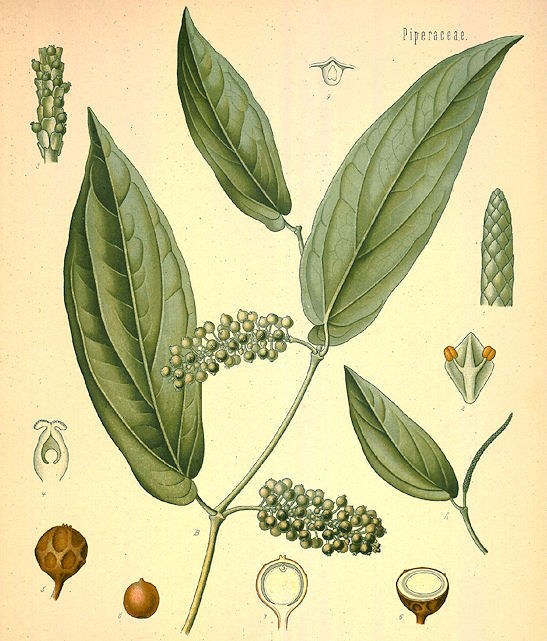
Abb.: कोलकम् । Piper cubeba L. f. 1782 - Kubeben-Pfeffer - Tailed
Pepper
[Bildquelle: Köhler, 1883]
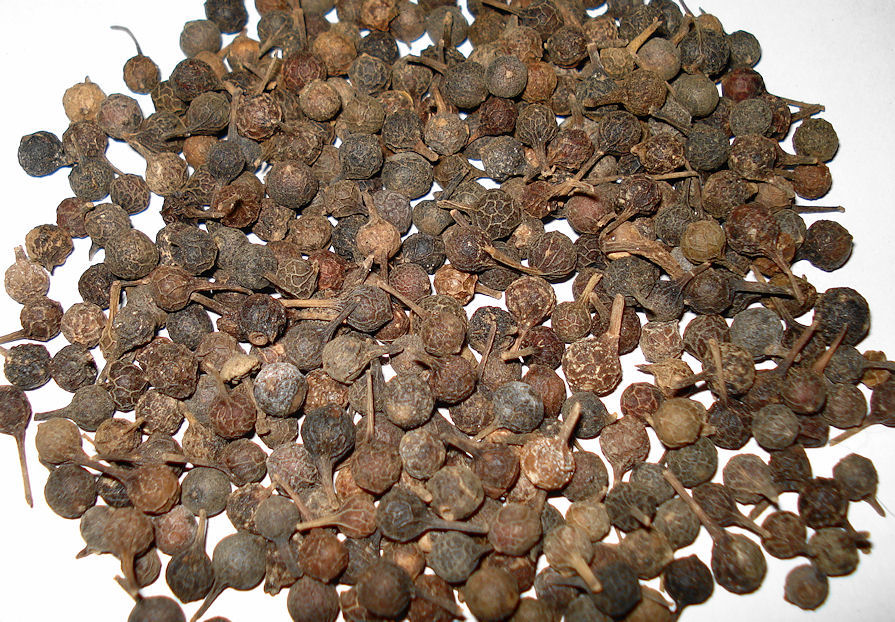
Abb.: कोलकम् । Piper cubeba L. f. 1782 - Kubeben-Pfeffer - Tailed
Pepper
[Bildquelle: Miansari66 / Wikimedia. -- Public domain]
"PIPER CUBEBA, Linn. f. Fig — Bentl. and Trim., t. 243.
Cubebs
Hab.—Java.
[...]
History, Uses, &C.—Cubebs were introduced into medicine by the Arabian physicians of the Middle Ages. Masudi in the 10th century stated them to be a production of Java. The author of the Sihah, who died in 1006, describes Kababeh as a certain medicine of China. Ibn Sina, about the same time, notices it as having the properties of madder, but a more agreeable taste, and states that it is said to possess hot and cold properties, but is really hot and dry in the third degree, a good deobstruent, and useful as an application to putrid sores and pustules in the mouth ; it is also good for the voice and for hepatic obstructions ; a valuable diuretic, expelling gravel and stone from the kidneys and bladder. He concludes by stating that the application of the saliva, after chewing it, increases the sexual orgasm. Later Mahometan writers have similar accounts of Kababeh, and say that it is called Hab-el-arus, "bridegroom's berry," and that Greek names for it are Mahilyun and Karfiyun, evidently a corruption of καρπεσιον, the name of an aromatic wood mentioned by Paulus Aegineta. It appears that cubebs were at one time known as Fructus carpesiorum in Europe. In the Raja Nirghanta, which was written about 600 years ago, cubebs appear under the name of Kankola, and the same name appears in the Hindi and Marathi Nighantas. Madanpal gives Katuka-kola, "pungent pepper," as a synonym for it. All the Sanskrit names appear to be of comparatively recent origin. The authors of the Pharmacographia draw attention to the fact that the action of cubebs upon the urino-genital organs, though known to the old Arabian physicians, was unknown to modern European writers on Materia Medica at the commencement of the present century. According to Crawfurd, its importation into Europe, which had long been discontinued, recommenced in 1815, in consequence of its medicinal virtues having been brought to the knowledge of the English medical officers serving in Java, by their Hindu servants. (Op. cit., 2nd Ed., p. 585.) In earlier times cubeb pepper was used in Europe as a spice, as it still is, to some extent, in the East."
[Quelle: Pharmacographia indica : a history of the principal drugs of vegetable origin met with in British India / by William Dymock [1834-1892], C. J. H. Warden and David Hooper [1858-1947]. -- Bd. 3. -- London, 1893. -- S. 180f.]
Apiaceae - Doldenblütler
| 36c./d. jīrako jaraṇo 'jājī kaṇāḥ kṛṣṇe tu jīrake जीरको जरणो ऽजाजी कणाः कृष्णे तु जीरके ।३६ ख। [Bezeichnungen für Cuminum cyminum L. 1753 - Kreuzkümmel - Cumin:]
|
Colebrooke (1807): "Cumin."
जीरक - jīraṇa m.: verdauend, Cuminum cyminum L. 1753 - Kreuzkümmel - Cumin
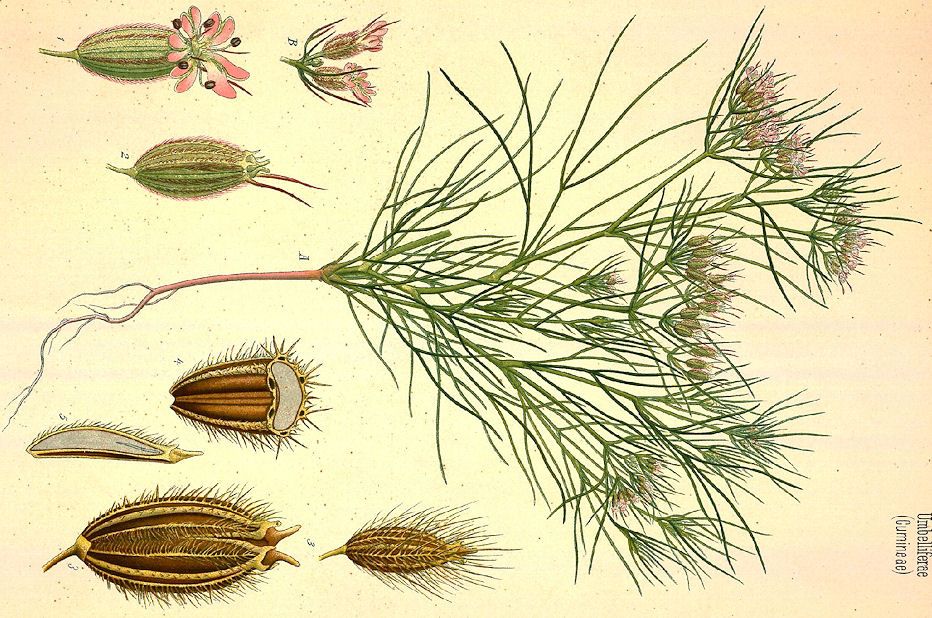
Abb.: जीरणः । Cuminum cyminum L. 1753 - Kreuzkümmel - Cumin
[Bildquelle: Köhler, 1883-1914]
जरण - jaraṇa m.: verdauend, Cuminum cyminum L. 1753 - Kreuzkümmel - Cumin
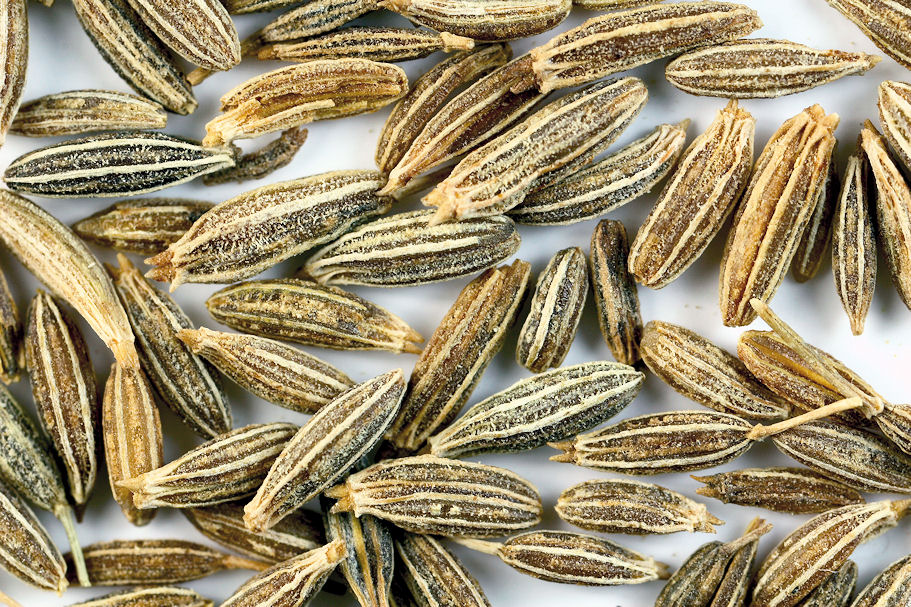
Abb.: जरणः । Cuminum cyminum L. 1753 - Kreuzkümmel - Cumin
[Bildquelle: Sanjay Acharya / Wikimedia. -- GNU FDLicense]
अजाजी - ajājī f.: "Ziegen herantreibend", Cuminum cyminum L. 1753 - Kreuzkümmel - Cumin
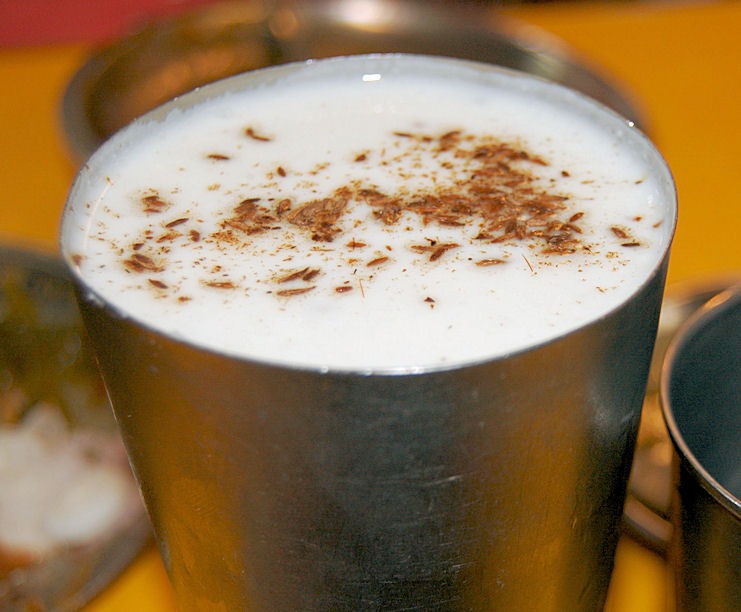
Abb.: अजाजी । Namkeen Chach (नमकीन) mit Kümmel und anderen Gewürzen, Delhi
[Bildquelle: Scott Dexter. --
http://www.flickr.com/photos/ampersandyslexia/3245069577/. -- Zugriff am
2011-07-11. --
Creative
Commons Lizenz (Namensnennung, keine kommerzielle Nutzung)]
कणा - kaṇā f.: Cuminum cyminum L. 1753 - Kreuzkümmel - Cumin
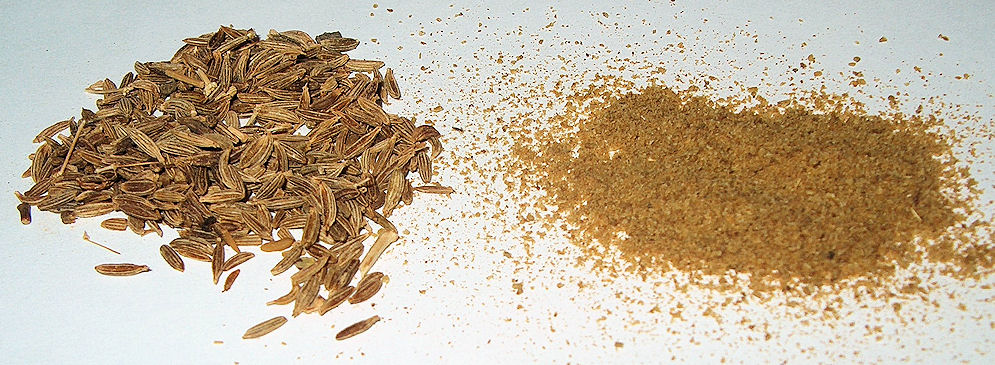
Abb.: कणाः । Cuminum cyminum L. 1753 - Kreuzkümmel - Cumin
[Bildquelle: Henna / Wikimedia. --
Creative
Commons Lizenz (Namensnennung, share alike)]
"Cuminum Cyminum (Linn.) N. O. Umbelliferae. Cummin
Description.—Herbaceous; [...] flowers white.
W. & A. Prod, i. 373.—Dec. Prod. iv. 201.—Roxb. Fl. Ind. ii. 92.
Cultivated
Medical Uses.—The seeds are met with in the bazaars throughout India, being much in use as a condiment. Their warm bitterish taste and aromatic odour reside in a volatile oil. Both seeds and oil possess carminative properties analogous to Coriander and Dill, and on this account are much valued by the natives.—Pharm of India."
[Quelle: Drury, Heber <1819 - 1872>: The useful plants of India : with notices of their chief value in commerce, medicine, and the arts. -- 2d ed. with additions and corrections. London : Allen, 1873. -- xvi, 512 p. ; 22 cm. -- s.v.]
"CUMINUM CYMINUM, Linn. Fig.—Bentl. and Trim., t. 134.
Cumin (Eng., Fr.).
Hab.—Africa. Cultivated in India. The fruit.
[...9
History, Uses, &e.—The use of cumin as a spice and medicine is of the highest antiquity, and appears to have spread from the cradle of civilization in Egypt to Arabia, Persia, India and China. Cumin is mentioned in the Hebrew Bible, it is the
κυμινον of the Greeks, and Theophrastus (H. P. IX.) tells us that it was the custom to utter curses when sowing it (probably to avert the evil eye). Dioscorides (iii., 61,) calls it κυμινον ημερον, and notices its medicinal properties; in the same chapter he mentions another kind of cumin, "the king's cumin of Hippocrates," which the Arabians identify with ajowan, and in the next chapter two kinds of wild cumin. Popular allusions to cumin are common in the writings of the Greeks and Romans, cumin and salt was a symbol of friendship (Plut. Symp. 5, 10, 1). Pliny tells us that students eat it to make themselves look pale and interesting. Greek writers mention a κυμινο-δοκον or cumin-box which was placed on the table like a salt-cellar. Flückiger and Hanbury trace its use during the Middle Ages, when it appears to have been much valued in Europe. Mannhardt (Baumkultus der Germanen) says that bread was spiced with cumin to protect it from the demons, and De Gubernatis (Myth. des Plant.) states that it is used for the same purpose in Italy, and on account of its supposed retentive powers is given to domestic animals to keep them from straying, and by girls to their sweethearts for the same reason.Jira and Jirana, the Sanskrit names for cumin, as well as the Persian Zhireh or Zireh, and all the Indian vernacular names appear to be derived from the root Jri, and to allude to the digestive properties of the seeds; other Sanskrit names are Ajāji " that overcomes goats, "ajamoda "goat's delight" and Kunchicka. The Arabic name Kamūn is doubtless derived from the Greek. Ibn Sina and the Eastern Arabs, and also the Persians follow Dioscorides in describing four kinds of cumin, which they name Kirmāni or black, Farsi or yellow, Shāmī (Syrian) and Nabti (Egyptian). They also mention along with them Karawya or caraway as a seed like anise. In the absence of accurate descriptions it is impossible to say what these four kinds were, but it seems probable that the Kirmāni or black cumin is correctly identified by the Indian Mahometans with the seeds known in India as Siyah-Jira, a species of caraway peculiar to Central Asia. The Nabti or Egyptian kind is probably true cumin.
Cumin is much used as a condiment in India, and is an essential ingredient in all the mixed spices and curry powders of the natives. Medicinally they regard it as stomachic, carminative and astringent, and prescribe it in chronic diarrhoea and dyspepsia. A medicinal oil is expressed from the seeds. Cumin is applied in the form of a plaster to allay pain and irritation. It is thought to be very cooling, and on this account it is an ingredient in moat antaphrodisiac prescriptions, and is administered in gonorrhoea."
[Quelle: Pharmacographia indica : a history of the principal drugs of vegetable origin met with in British India / by William Dymock [1834-1892], C. J. H. Warden and David Hooper [1858-1947]. -- Bd. 2. -- London, 1891. -- S. 113ff.]
Ranunculaceae - Hahnenfußgewächse
| 36c./d. jīrako jaraṇo 'jājī kaṇāḥ kṛṣṇe tu jīrake 37a./b. suṣavī kāravī pṛthvī pṛthuḥ kālopakuñcikā
जीरको जरणो
ऽजाजी कणाः कृष्णे तु जीरके
।३६ ख। Der Schwarze Kümmel (jīraka m.) heißt:
|
Colebrooke (1807): "Kalonjī. Nigella Indica, Roxb."
सुषवी - suṣavī f.: Nigella sativa L. 1753 - Schwarzkümmel - Black Cumin

Abb.: सुषवी । Nigella sativa L. 1753 - Schwarzkümmel - Black Cumin
[Bildquelle: Köhler, 1883-1914]
कारवी - karavī f.: "Krähin", Nigella sativa L. 1753 - Schwarzkümmel - Black Cumin
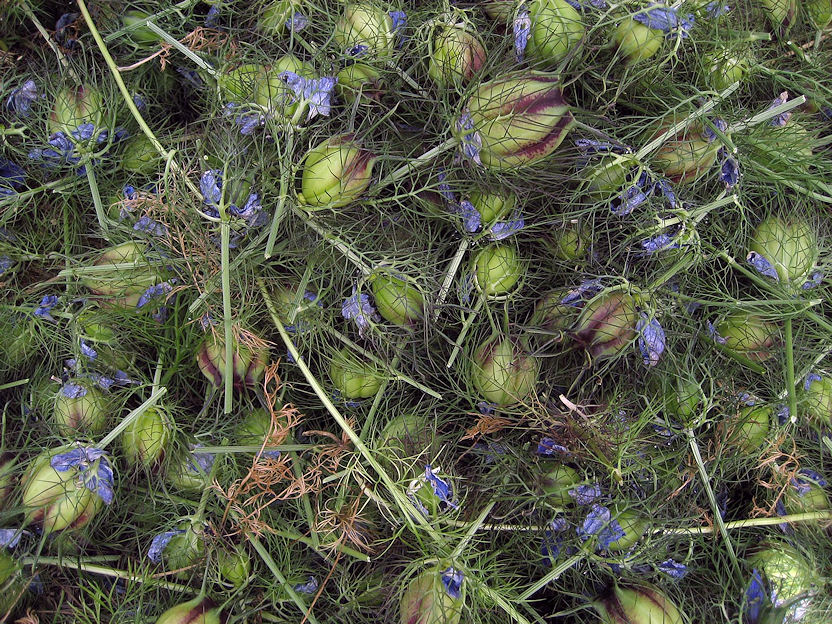
Abb.: कारवी । Früchte von Nigella sativa L. 1753 - Schwarzkümmel -
Black Cumin
[Bildquelle: badthings. --
http://www.flickr.com/photos/badthings/529989544/. -- Zugriff am
2011-07-11. --
Creative Commons Lizenz (Namensnennung, keine kommerzielle Nutzung,
keine Bearbeitung)]
पृथ्वी - pṛthvī f.: weit, Erde, Nigella sativa L. 1753 - Schwarzkümmel - Black Cumin
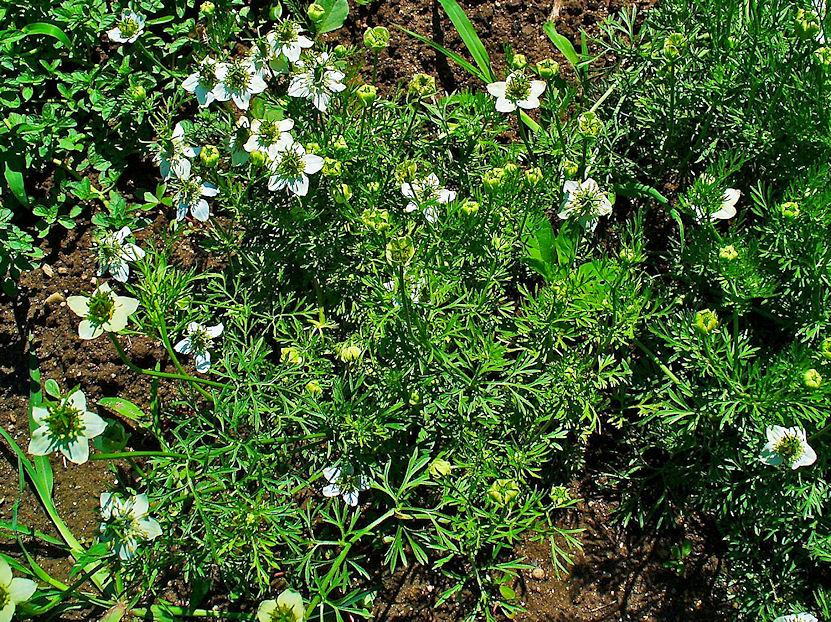
Abb.: पृथ्वी । Nigella sativa L. 1753 - Schwarzkümmel - Black Cumin
[Bildquelle: H. Zell / Wikimedia. -- GNU FDLicense]
पृथु - pṛthu f.: weit, Nigella sativa L. 1753 - Schwarzkümmel - Black Cumin
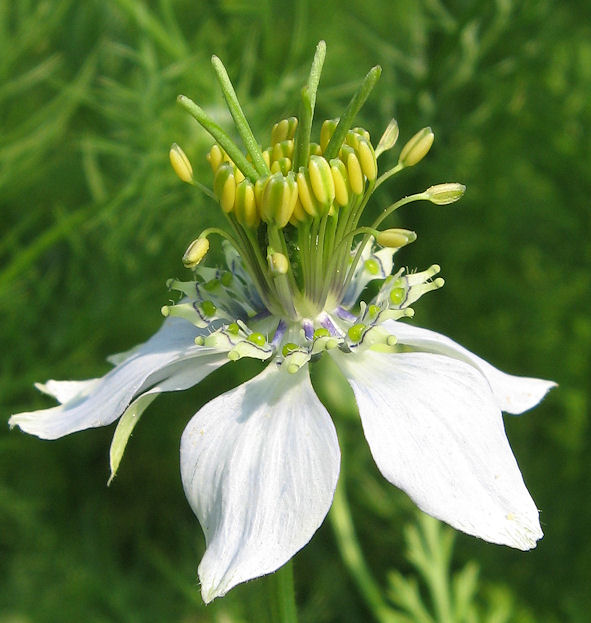
Abb.: पृथुः । Nigella sativa L. 1753 - Schwarzkümmel - Black Cumin,
Wien, Österreich
[Bildquelle: AndreHolz / Wikipedia. --
Creative
Commons Lizenz (Namensnennung, share alike)]
काला - kālā f.: schwarz, Nigella sativa L. 1753 - Schwarzkümmel - Black Cumin
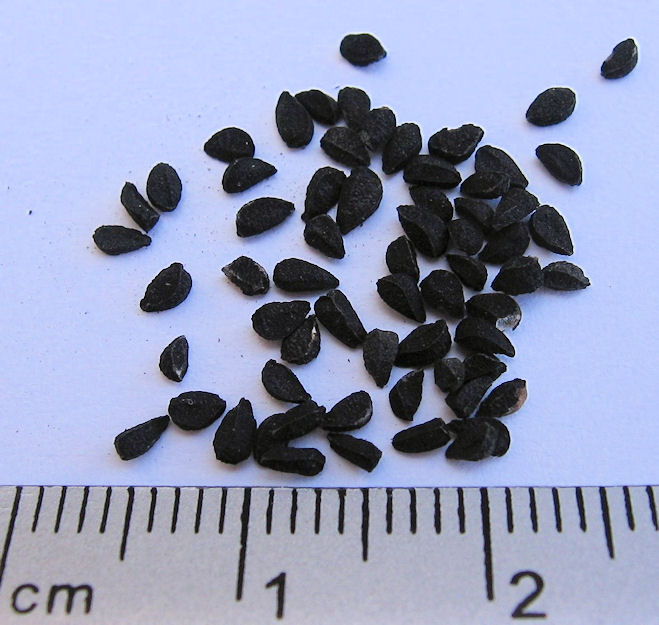
Abb.: कालाः । Nigella sativa L. 1753 - Schwarzkümmel - Black Cumin
[Bildquelle: TheGoblin / Wikimedia. -- GNU FDLicense]
उपकुञ्चिका - upakuñcikā f.: "sich darauf krümmend", Nigella sativa L. 1753 - Schwarzkümmel - Black Cumin
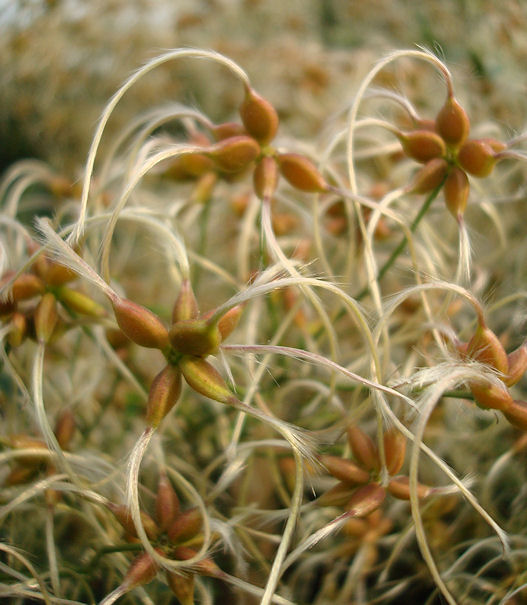
Abb.: उपकुञ्चिका । Nigella sativa L. 1753 - Schwarzkümmel - Black
Cumin, Deutschland
[Bildquelle: ༺Stadtkatze༻. --
http://www.flickr.com/photos/stadtkatze/3842787530/. -- Zugriff am
2011-07-11. --
Creative
Commons Lizenz (Namensnennung, keine kommerzielle Nutzung, share alike)]
"NIGELLA SATIVA, Sibthorp. Fig.—Zorn. Ic. 119.
Small Fennel-flower
Hab .—The Mediterranean countries. Cultivated in India.
[...]
History, Uses, &c.—According to Birdwood, it is the Black Cummin of the Bible, the Melanthion of Hippocrates and Dioscorides, and the Gith of Pliny. Ainslie mentions its' use as a carminative, also as an external application mixed with sesamum oil in skin eruptions, as a seasoning for food, and as a protection for linen against insects. Forskahl, in his Medicine Kaharina, says that it is a native of Egypt, where it is called Hab-es-souda. Roxburgh believes it to be a native of Hindostan. Anyhow, it must have been long known in India, as it has a Sanskrit name, Krishnajiraka. Nigella seed is extensively used as a spice, and as a medicine; it is prescribed by the Hindus with other aromatics and plumbago root in dyspepsia. The Hakeems describe it as heating, attenuant, suppurative, detergent and diuretic, and consider that it increases the menstrual flow and the secretion of milk ; also that it stimulates uterine action. They give it, too, as a stimulant in a variety of disorders which are ascribed to cold humours, and credit it with anthelmintic properties. It is sprinkled over the surface of the bread made by Mahometan bakers along with Sesamum seed. (See Cuminum Cyminum.) M. Canolle has recently published (De I'avortement criminel a Karikal. Thèse de Paris, 1881,) the results of clinical investigations undertaken in the hospital at Karikal with black cummin seed. He has observed that after doses of 10 to 40 grams of the powdered seed the temperature of the body is raised, the pulse accelerated, and all the secretions stimulated, especially those of the kidneys and skin; in doses of 10 to 20 grams, they possess a well marked emmenagogue action in dysmenorrhea, and in larger doses cause abortion."
[Quelle: Pharmacographia indica : a history of the principal drugs of vegetable origin met with in British India / by William Dymock [1834-1892], C. J. H. Warden and David Hooper [1858-1947]. -- Bd. 1. -- London, 1890. -- S. 28f.]
Zingiberaceae - Ingwergewächse
| 37c./d. ārdrakaṃ śṛṅgaveraṃ syād atha chatrā vitunnakam आर्द्रकं शृङ्गवेरं स्याद् अथ छत्रा वितुन्नकम् ।३७ ख। [Bezeichnungen für frischen Zingiber officinale Roscoe 1807 - Gewöhnlicher Ingwer - Ginger:]
|
Colebrooke (1807): "Ginger."
आर्द्रक - ārdraka n.: frisch, feucht, frischer Zingiber officinale Roscoe 1807 - Gewöhnlicher Ingwer - Ginger
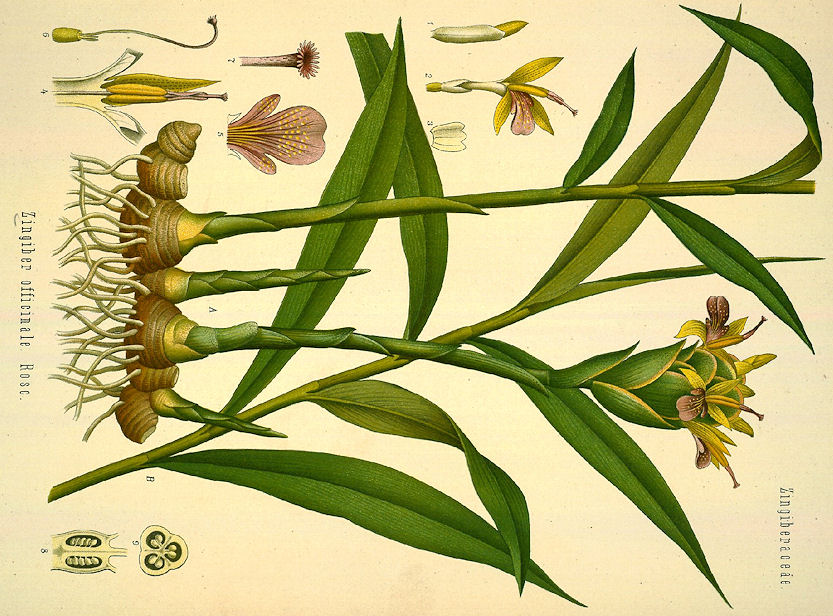
Abb.: आर्द्रकम् । Zingiber officinale Roscoe 1807 - Gewöhnlicher
Ingwer - Ginger
[Bildquelle: Köhler, 1883-1914]
शृङ्गवेर - śṛṅgavera n.: "mit einem Horn als Körper", frischer Zingiber officinale Roscoe 1807 - Gewöhnlicher Ingwer - Ginger
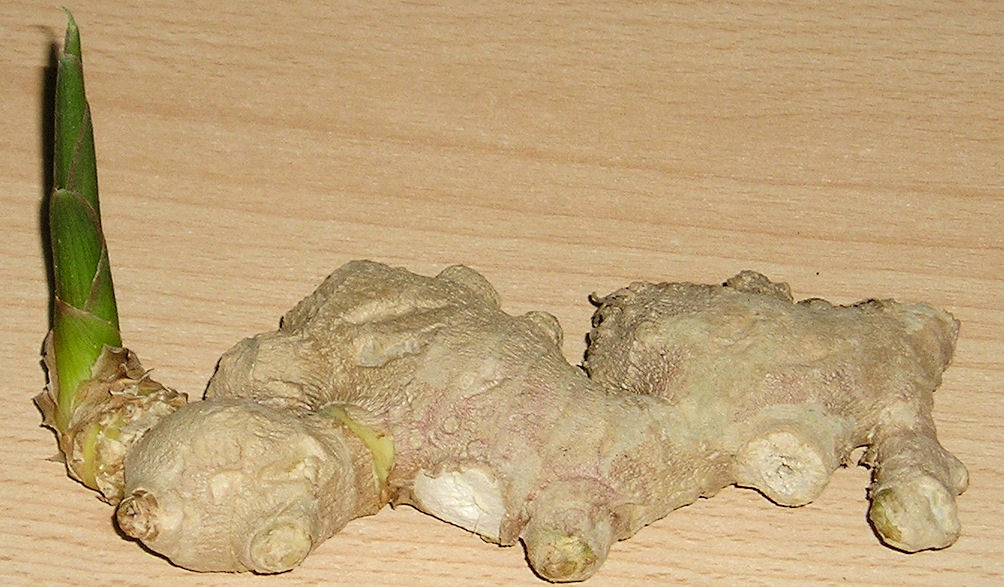
Abb.: शृङ्गवेरम् । Frisches Rhizom von Zingiber officinale Roscoe
1807 - Gewöhnlicher Ingwer - Ginger
[Bildquelle: Maja Dumat. --
http://www.flickr.com/photos/blumenbiene/4801304738/. -- Zugriff am
2011-07-11. --
Creative Commons Lizenz (Namensnennung)]
"Zingiber officinale (Roscoe.) N. O. Zingiberaceae. Common Ginger, Eng. Ingie, Tam. Inchi, Mal. Ullum, Tel. Sonth, Hind. Udruck, Ada, Beng.
Description.—Rhizome tuberous, biennial; stems erect and oblique, invested by the smooth sheaths of the leaves, generally 3 or 4 feet high, and annual; leaves sub-sessile on their long sheaths, bifarious, linear-lanceolate, very smooth above and nearly so underneath; sheaths smooth, crowned with a bifid ligula; scapes radical, solitary, a little removed from the stems, 6-12 inches high, enveloped in a few obtuse sheaths, the uppermost of which sometimes end in tolerably long leaves; spikes oblong, the size of a man's thumb; exterior bracts imbricated, 1-flowered, obovate, smooth, membranous at the edge, faintly striated lengthwise; interior enveloping the ovary, calyx, and the greater part of the tube of the corolla; flowers small; calyx tubular opening on one side, 3-toothed; corolla with a double limb; outer of 3, nearly equal, oblong segments, inner a 8-lobed lip, of a dark-purple colour; ovary oval, 3-celled, with many ovules in each; style filiform. Fl. Aug.—Oct.—Roxb. Fl. Ind. i. 47.—
Amomum Zingiber, Linn.—Rheede, xi. t. 12.------Cultivated over all the warmer parts of Asia.
Medical Uses.—The Ginger plant is extensively cultivated in India from the Himalaya to Cape Comorin. In the former mountains it is successfully reared at elevations of 4000 or 6000 feet, requiring a moist soil. The seeds are seldom perfected, on account of the great increase of the roots. These roots or rhizomes have a pleasant aromatic odour. When old they are scalded, scraped, and dried, and are then the white ginger of the shops; if scalded without being scraped, the black ginger. It is not exactly known to what country the ginger plant is indigenous, though Ainslie states it to be a native of China, while Joebel asserts that it is a native of Guinea.
It is still considered doubtful whether the black and white ginger are not produced by different varieties of the plant. Rumphius asserts positively that there are two distinct plants, the white and the red ; and Dr Wright has stated in the London Medical Journal, that two. sorts—namely, the white and black—are Cultivated in Jamaica. The following account of its cultivation is given in Simmond's Commercial Products: The Malabar ginger exported from Calicut is the produce of the district of Shernaad, situated to the south of Calicut; a place chiefly inhabited by Moplas, who look upon the ginger cultivation as a most valuable and profitable trade, which in fact it is. The soil of Shernaad is so very luxuriant, and so well suited for the cultivation of ginger, that it is reckoned the best, and in fact the only place in Malabar where ginger grows and thrives to perfection. Gravelly grounds are considered unfit; the same may be said of swampy ones ; and whilst the former check the growth of the ginger, the latter tend in a great measure to rot the root. Thus the only suitable kind of soil- is that which, being red earth, is yet free from gravel, and the soil good and heavy. The cultivation generally commences about the middle of May, after the ground has undergone a thorough process of ploughing and harrowing.
At the commencement of the monsoon, beds of 10 or 12 feet long by 3 or 4 feet wide are formed, and in these beds small holes are dug at 3/4 to 1 foot apart, which are filled with manure. The roots, hitherto carefully buried under sheds, are dug out, the good ones picked from those which are affected by the moisture, or any other concomitant of a half-year's exclusion from the atmosphere, and the process of clipping them into suitable sizes for planting performed by cutting the ginger into pieces of 1 1/2 to 2 inches long. These are then buried in the holes, which have been previously manured, and the whole of the beds are then covered with a good thick layer of green leaves, which whilst they serve as manure, also contribute to Keep the beds from unnecessary dampness, which might otherwise be occasioned by the heavy falls of rain during the months of June and July. Rain is essentially requisite for the growth of the ginger; it is also, however, necessary that the beds be constantly kept from inundation, which, if not carefully attended to, the crop is entirely ruined; great precaution is therefore taken in forming drains between, the beds, letting water out, thus preventing a superfluity. On account of the great tendency some kinds of leaves have to breed worms and insects, strict care is observed in the choosing of them, and none But the particular kinds used in manuring ginger are taken in, lest the wrong ones might fetch in worms, which, if once in the beds, no remedy can be resorted to successfully to destroy them; thus they in a very short time ruin the crop. Worms bred from the leaves laid on the soil, though highly destructive, are not So pernicious to ginger cultivation as those which proceed from the effect of the soil. The former kind, whilst they destroy the beds in which they once appear, do not spread themselves to the other beds, be they ever so close; but the latter kind must of course be found in almost all the beds, as they do not proceed from accidental causes, but from the nature of the soil. In cases like these, the whole crop is oftentimes ruined, and the cultivators are thereby subjected to heavy losses.
The rhizomes when first dug up are red internally, and when procured fresh and young are preserved in sugar, constituting the preserved ginger of the shops. Essence of ginger is made by steeping ginger in alcohol. With regard to its medical uses, ginger, from its stimulant and carminative properties, is used in toothaches, gout, rheumatism of the jaws, and relaxed uvula, with good effect, and the essence of ginger is said to promote digestion. Ginger is said to act powerfully on the mucous membrane, though its effects are not always so decided on the remoter organs as on those which it comes into immediate contact with. Beneficial results hove been arrived at when it has been administered in pulmonary and catarrhal affections. Headaches have also been frequently relieved by the application of ginger - poultices to the forehead. The native doctors recommend it in a variety of ways externally in paralysis and rheumatism, and internally with other ingredients in intermittent fevers. Dry or white ginger is called Sookhoo in Tamil, and South in Dukhanie ; and the green ginger is Injee in Tamil, and Udruck in Dukhanie. The ginger from Malabar is reckoned superior to any other.—Ainslie, Simmonds."
[Quelle: Drury, Heber <1819 - 1872>: The useful plants of India : with notices of their chief value in commerce, medicine, and the arts. -- 2d ed. with additions and corrections. London : Allen, 1873. -- xvi, 512 p. ; 22 cm. -- s.v.]
"ZINGIBER OFFICINALE, Rosc. Fig.—Bentl. and Trim., t. 270; Rosc. Monand. Pl., 83 ; Woodville, t. 250; Steph. and Ch., t. 96.
Hab.— Cultivated throughout the East.
The rhizome.
[...]
History, Uses, &c.—Ginger has been cultivated in India from prehistoric times ; it is a native of the East, but is not now known in a wild state. In Sanskrit it bears many names, such as Mahaushadha " great remedy," Visva "pervader," Visva-bheshaja "panacea," Sringavera "antlered," Katu badra "the good acrid," &c. When dried it is known as Sunthi and Nagara in distinction from Ardraka "fresh ginger." In the Nighantas it is described as acrid and digestive, useful for the removal of cold humors, costiveness, nausea, asthma, cough, colic, palpitation of the heart, tympanitis, swellings, piles, &c. Ginger is one of the three acrids (trikatu) of the Hindu physicians, the other two being black pepper and long pepper; combined with other spices and sugar, as in the preparations known as Samasarkara churna and Saubhagya sunthi, it is given in dyspepsia and loss of appetite. In rheumatism preparations of ginger and other spices with butter are given internally, and it is an ingredient in oils used for external application. The juice of the fresh tubers, with or without the juice of garlic, mixed with honey, is a favourite domestic remedy for cough and asthma, with lime juice it is used in bilious dyspepsia, and a paste of dry ginger and warm water is applied to the forehead to relieve headache. In Western India, ginger juice, with a little honey and a pinch of burnt peacock's feathers, is the popular remedy for vomiting. In old Persian we find the names Shingabir or Shangabir and Adrak applied to ginger, and it was probably through the Persians that the Greeks first became acquainted with it, as their
ζιγγιβερι is evidently derived from the Sanskrit Sringavera through the Persian form of the word. The Arabic name Zanjabil is of similar origin, the chief difference being the substitution of the letter J for G, which is not in the Arabian alphabet.Ginger is described by Dioscorides as hot, digestive, gently laxative, stomachic and having all the properties of pepper; it was an ingredient in collyria and antidotes to poison. Pliny notices it in his chapter on peppers, but very briefly, and it does not appear to have been regarded as an article of much importance in his time.
In the second century of our era, ginger is mentioned as liable to duty (vectigal) at Alexandria along with other Indian spices. (Vincent Com. and Nav. of the Ancients, III, 695). Galen recommends it in paralysis and all complaints arising from cold humors ; Paulus in neuralgia and gout, Ibn Sina and other Arabian and Persian physicians closely follow the Greeks, but enlarge upon its aphrodisiacal properties. In modern medicine the value of ginger as a carminative in atonic dyspepsia and flatulent colic, and as a masticatory in relaxed conditions of the throat is generally admitted.
The manufacture of ginger beer and ginger ale forms a large portion of the mineral water trade in En gland ; indeed, some makers have acquired a special reputation for their production. Besides the large number of fermented and aerated ginger beers consumed at home, a good deal of ginger ale is shipped in glass bottles from Belfast, especially to the United States. About 16,000 packages or casks are so exported annually, for it has become a fashionable beverage in America among all classes.
[...]
The number of uses to which ginger is applied besides as a spice, confection and medicine are many ; for instance, we have gingerade, ginger ale, ginger beer, ginger brandy, ginger bread, ginger champagne, ginger cordial, ginger essence, ginger lozenges and ginger wine.
On the Continent of Europe, ginger is less used and appreciated than in England.
Soluble essences of ginger are required for making good ginger beer, and Belfast and American ginger ales. There are aerated and fermented ginger beers; the best unbleached Jamaica ginger, well bruised, being used for the latter. Ginger is also used for a kind of cordial and champagne.
Lastly, young ginger is candied and preserved to a considerable extent in the East, and comes into commerce under the section of "succades." The quantity imported into England from India and China ranges from 300,000 to 600,000 pounds, of the value of £11,000 to £25,000. The mode of preserving it is to steep the rhizomes in vats of water for several days, changing the water once. When taken out it is spread on tables and well pricked or pierced with bodkins. The rhizomes are then boiled in a copper caldron, then steeped for two days and nights in a vat with a mixture of water and rice flour. After this they are washed with a solution of lime, then boiled with an equal weight of sugar and a little white of egg is added to clarify.
After the ginger has been boiled a second time it is put in glazed jars of pottery, holding 1 pound, 3 pounds or 6 pounds, and covered with syrup. The syrup is changed two or three times, and then they are shipped in cases holding six jars.
The quality called "Mandarin" is put up in barrels. (P. L. Simmonds, Amer. Jn. Pharm. 1891.)"
[Quelle: Pharmacographia indica : a history of the principal drugs of vegetable origin met with in British India / by William Dymock [1834-1892], C. J. H. Warden and David Hooper [1858-1947]. -- Bd. 3. -- London, 1893. -- S. 420 - 423.]
Apiaceae - Doldenblütler
| 37c./d. ārdrakaṃ śṛṅgaberaṃ syād atha chatrā vitunnakam 38a./b. kustumburu ca dhānyākam atha śuṇṭhī mahauṣadham
आर्द्रकं शृङ्गबेरं स्याद् अथ छत्रा
वितुन्नकम् ।३७ ख। [Bezeichnungen für Coriandrum sativum L. 1753 - Koriander - Coriander:]
|
Colebrooke (1807): "Coriander."
छत्रा - chatrā f.: Sonnenschirm, Coriandrum sativum L. 1753 - Koriander - Coriander
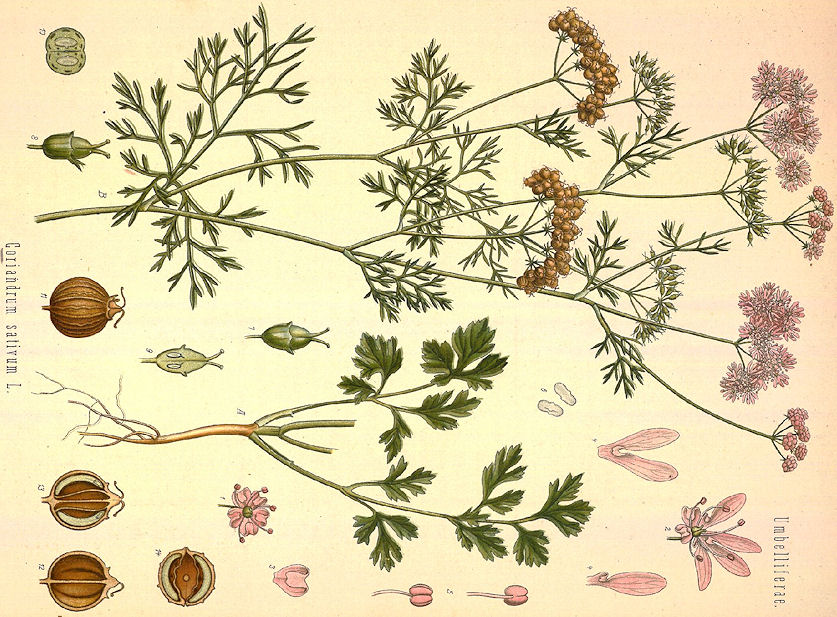
Abb.: छत्रा । Coriandrum sativum L. 1753 - Koriander - Coriander
[Bildquelle: Köhler, 1883-1914]
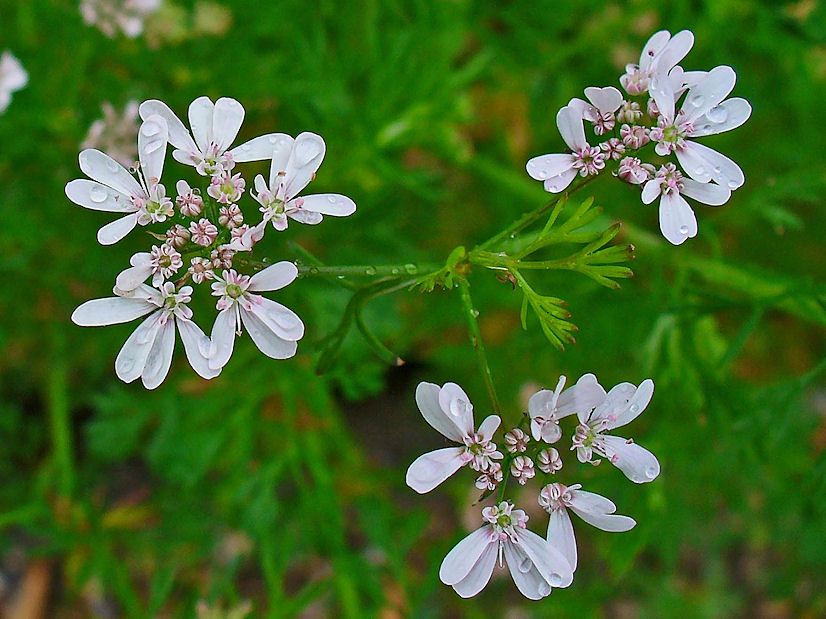
Abb.: छत्रा । Coriandrum sativum L. 1753 - Koriander - Coriander,
Deutschland
[Bildquelle: H. Zell / Wikimedia. -- GNU FDLicense]
वितुन्नक - vitunnaka n.: zerstochen, zerstechend, Coriandrum sativum L. 1753 - Koriander - Coriander
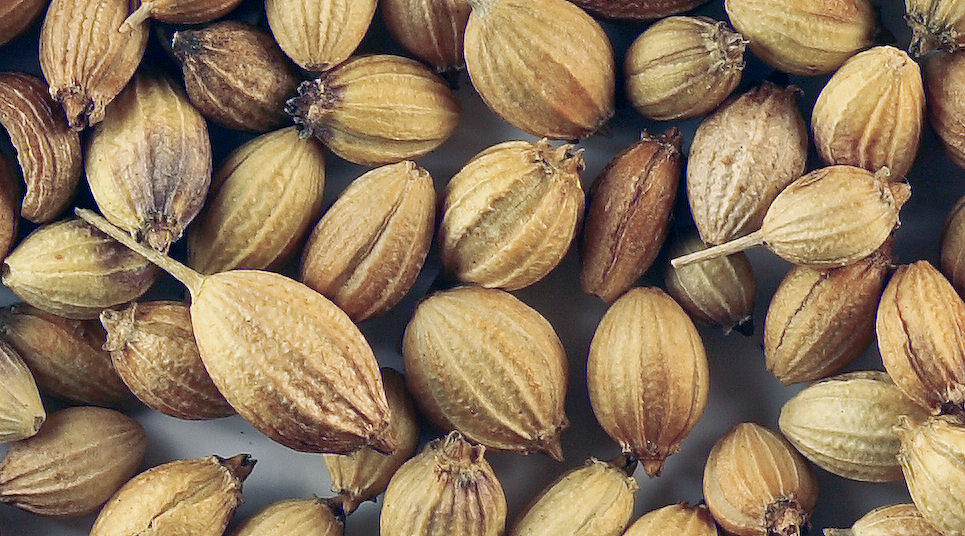
Abb.: वितुन्नकम् । Coriandrum sativum L. 1753 - Koriander - Coriander
[Bildquelle: Sanjay Acharya / Wikimedia. -- GNU FDLicense]
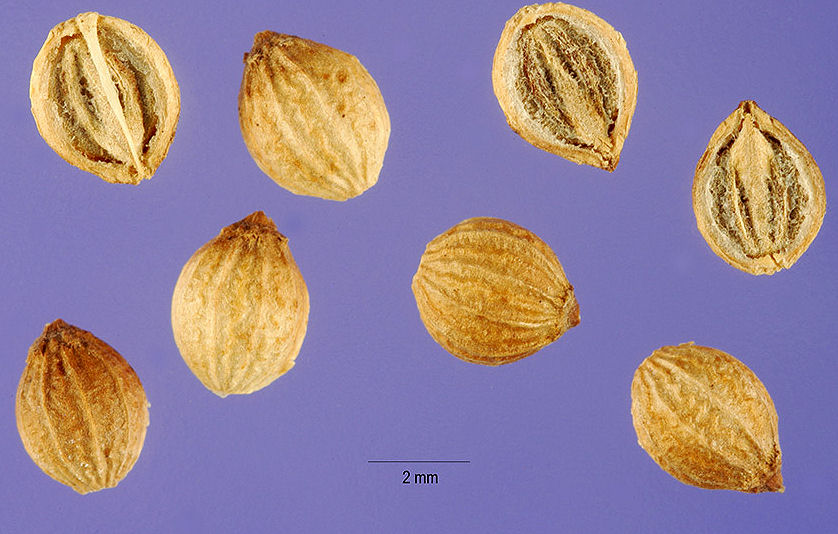
Abb.: वितुन्नकम् । Coriandrum sativum L. 1753 - Koriander - Coriander
[Bildquelle: Steve Hurst @ USDA-NRCS PLANTS Database. -- Public domain]
कुस्तुम्बुरु - kustumburu n.: Körner von Coriandrum sativum L. 1753 - Koriander - Coriander
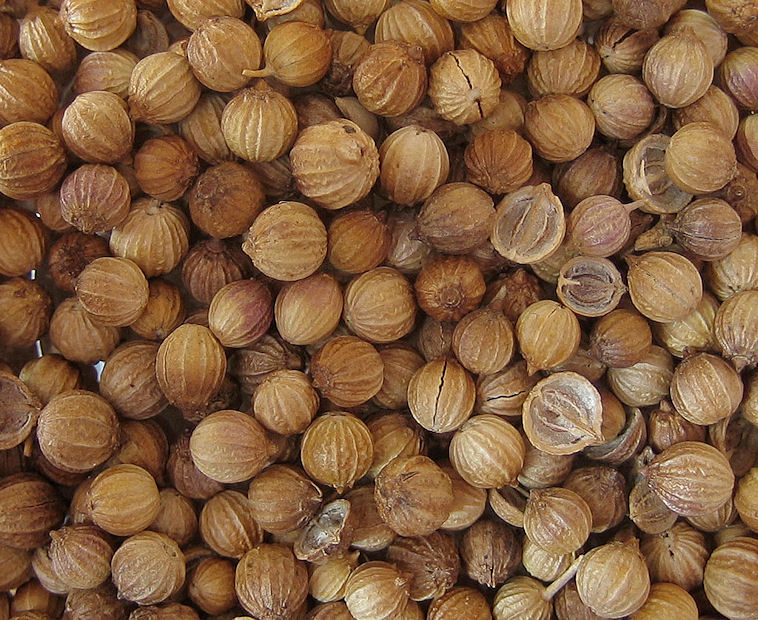
Abb.:
कुस्तुम्बुरूणि ।
Körner von Coriandrum sativum L. 1753 - Koriander - Coriander
[Bildquelle: Ombrosoparacloucycle. --
http://www.flickr.com/photos/30063276@N02/3410427890/. -- Zugriff am
2011-07-12. --
Creative
Commons Lizenz (Namensnennung, keine kommerzielle Nutzung, share alike)]
धान्याक - dhānyaka n.: "Getreidchen", Coriandrum sativum L. 1753 - Koriander - Coriander
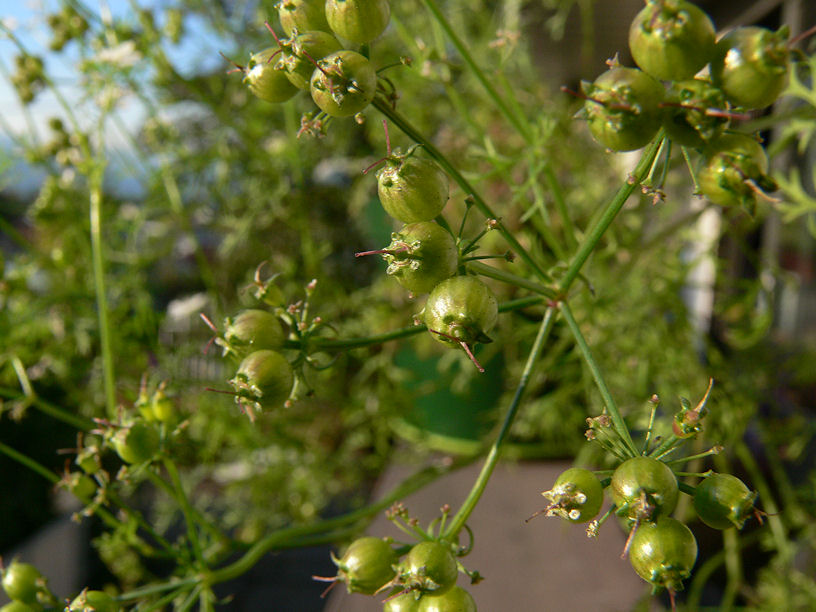
Abb.: धान्यकम् । Coriandrum sativum L. 1753 - Koriander - Coriander
[Bildquelle: zzzeroX
Productions. --
http://www.flickr.com/photos/0x/3054721148/. -- Zugriff am 2011-07-12.
--
Creative Commons Lizenz (Namensnennung, keine kommerzielle Nutzung,
share alike)]
"CORIANDRUM SATIVUM, Linn. Fig.—Bentl. and Trim., 1.133.
Coriander
Hab.—Cultivated in India. The fruit.
[...]
History, Uses, &C.-—The Coriander plant is called Kothmir, a name derived from the Sanskrit Kusthumbari; when young it is much used in preparing chutneys and sauces. The fruits are largely used by natives as a condiment; as a medicine they are considered carminative, diuretic, tonic, and aphrodisiac, and are often prescribed in dyspepsia. A cooling drink is prepared from them pounded with fennel fruit, poppy seeds, Kanchan flowers, rosebuds, cardamoms, cubebs, almonds and a little black pepper; it is sweetened with sugar. Mahometan writers describe them as sedative, pectoral and carminative; they prepare an eyewash from them which is supposed to prevent small-pox from destroying the eight, and to be useful in chronic conjunctivitis. Coriander is also thought to lessen the intoxicating effects of spirituous preparations, and with Barley meal to form a useful poultice for indolent swellings. It is the Kuzbura of the Arabs and Kishnīz of the Persians, who identify it with the Koriyun of the Greeks. The opinion that it has great cooling properties prevailed amongst Western physicians, "coriandrum siccum frangit coi tum, et erectionem virgae impedit." Apuleius says it assists women in child-birth and protects them from fever."
[Quelle: Pharmacographia indica : a history of the principal drugs of vegetable origin met with in British India / by William Dymock [1834-1892], C. J. H. Warden and David Hooper [1858-1947]. -- Bd. 2. -- London, 1891. -- S. 129f.]
Zingiberaceae - Ingwergewächse
| 38a./b. kustumburu ca dhānyākam atha śuṇṭhī mahauṣadham 38c./d. strī-napuṃsakayor viśvaṃ nāgaraṃ viśvabheṣajam
कुस्तुम्बुरु च धान्याकम् अथ शुण्ठी महौषधम्
।३८ क। [Bezeichnungen für getrockneten Zingiber officinale Roscoe 1807 - Gewöhnlicher Ingwer - Ginger:]
|
Colebrooke (1807): "Dry ginger."
Siehe oben zu Vers 37c./d.
शुण्ठी - śuṇṭhī f.: weiß, Getrockneter Zingiber officinale Roscoe 1807 - Gewöhnlicher Ingwer - Ginger
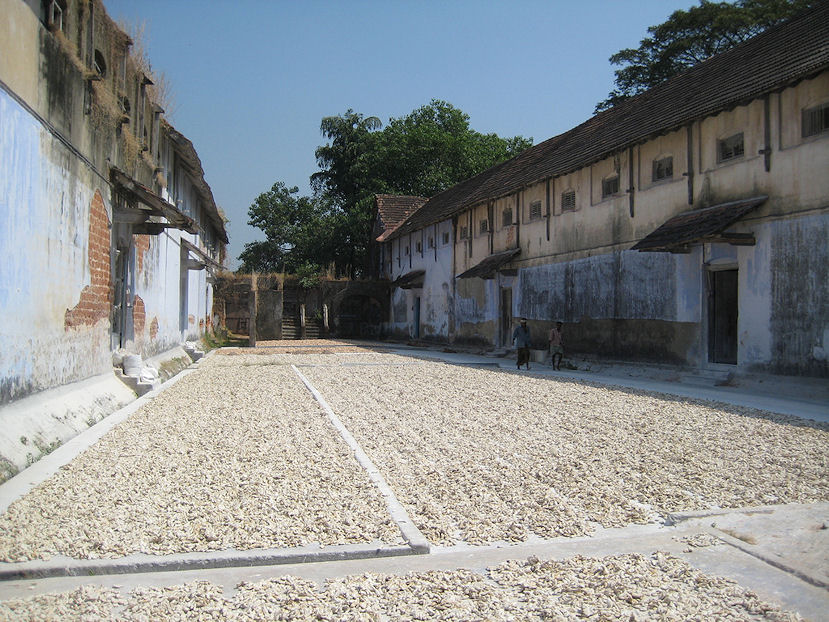
Abb.: Trocknen von Zingiber officinale Roscoe 1807 - Gewöhnlicher
Ingwer - Ginger, Kochi - കൊച്ചി,
Kerala
[Bildquelle: mutaminx. --
http://www.flickr.com/photos/mutaminx/3219988991/. -- Zugriff am
2011-07-12. --
Creative Commons Lizenz (Namensnennung, keine kommerzielle Nutzung,
keine Bearbeitung)]
महौषध - mahauṣadha n., f.: große Arzneipflanze, Getrockneter Zingiber officinale Roscoe 1807 - Gewöhnlicher Ingwer - Ginger
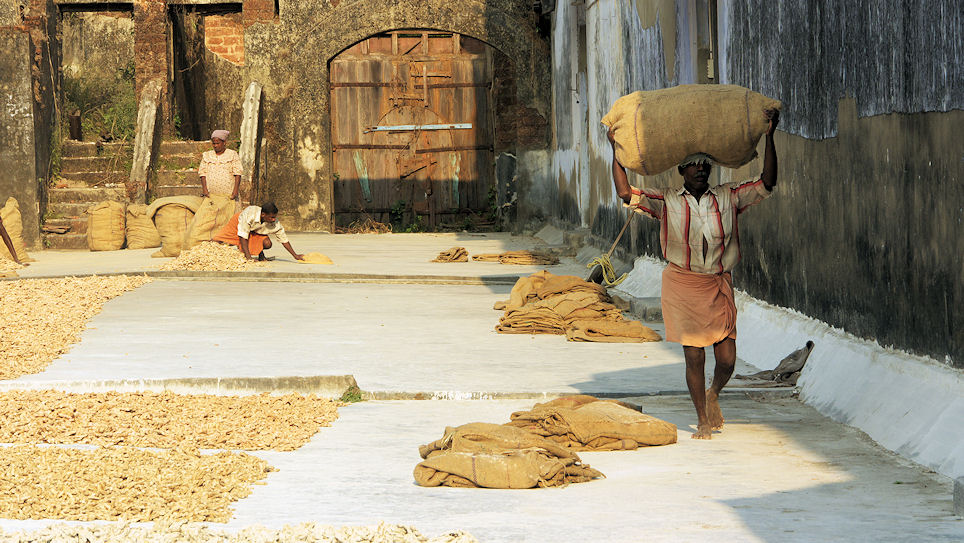
Abb.: Trocknen von Zingiber officinale Roscoe 1807 - Gewöhnlicher
Ingwer - Ginger, Kochi - കൊച്ചി,
Kerala
[Bildquelle: choubb. --
http://www.flickr.com/photos/choubb/5359778226/. -- Zugriff am
2011-07-12. --
Creative Commons Lizenz (Namensnennung, keine kommerzielle Nutzung,
keine Bearbeitung)]
विश्व - viśva f., n.: alles, Getrockneter Zingiber officinale Roscoe 1807 - Gewöhnlicher Ingwer - Ginger
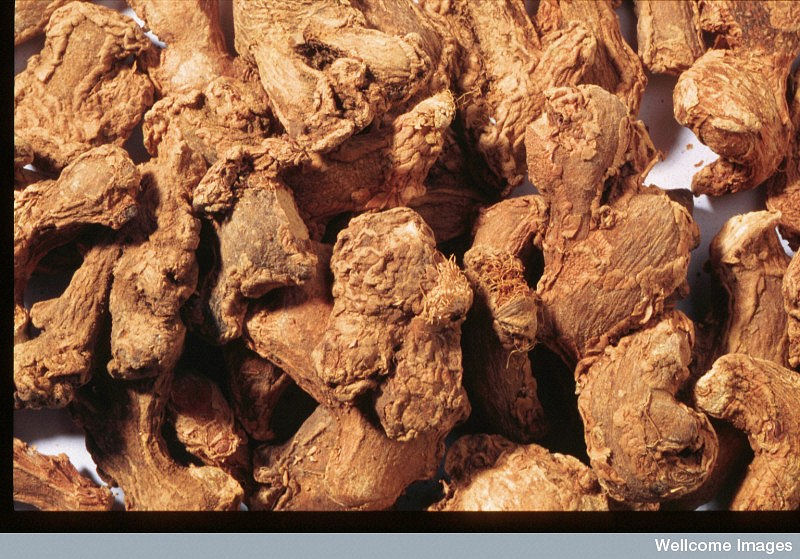
Abb.: विश्वम् । Getrockneter Zingiber officinale Roscoe 1807 - Gewöhnlicher
Ingwer - Ginger
[Bildquelle: Efraim Lev and Zohar Amar / Wellcome Images. --
Creative Commons
Lizenz (Namensnennung, keine kommerzielle Nutzung, keine Bearbeitung)]
नागर - nāgara n.: städtisch, Getrockneter Zingiber officinale Roscoe 1807 - Gewöhnlicher Ingwer - Ginger
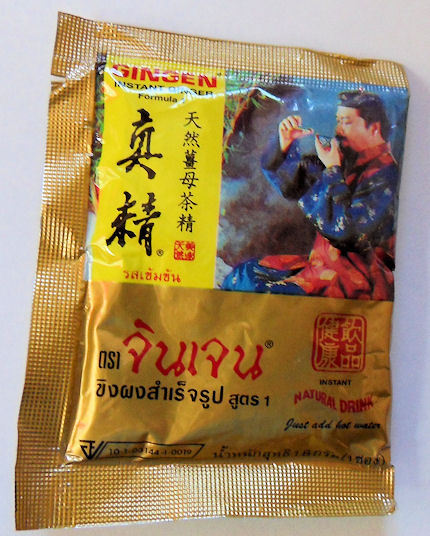
Abb.: नागरम् । Instant-Ingwer, Thailand
[Bildquelle: A. Payer. -- Public domain]
विश्वभेषज - viśvabheṣaja n.: Allheilmittel, Getrockneter Zingiber officinale Roscoe 1807 - Gewöhnlicher Ingwer - Ginger
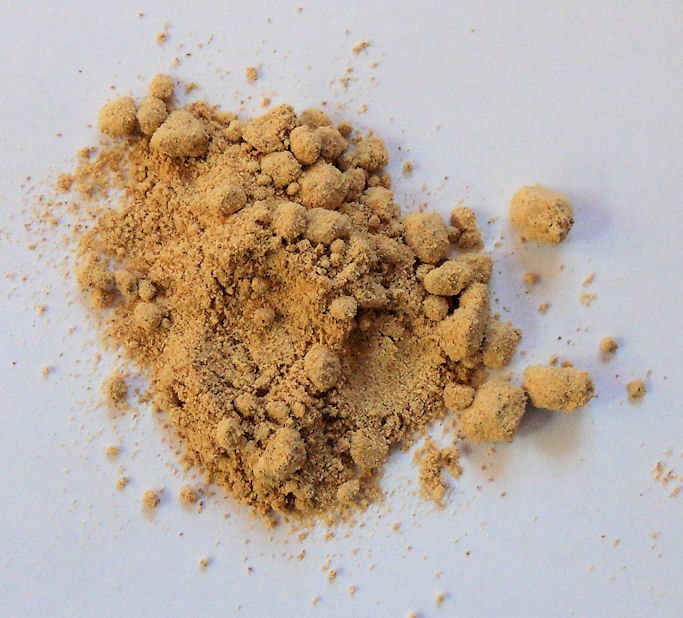
Abb.: विश्वभेषजम् । Getrockneter Zingiber officinale Roscoe 1807 - Gewöhnlicher
Ingwer - Ginger
[Bildquelle: A. Payer. -- Public domain]
| 39a./b. āranālaka-sauvīra-kulmāṣābhiṣutāni ca 39c./d. avantisoma-dhānyāmla-kuñjalāni ca kāñjike
आरनालक-सौवीर-कुल्माषाभिषुतानि च ।३९ क। Bezeichnungen für Sauerschleim (काञ्जिक n.1):
|
Colebrooke (1807): "Sour gruel."
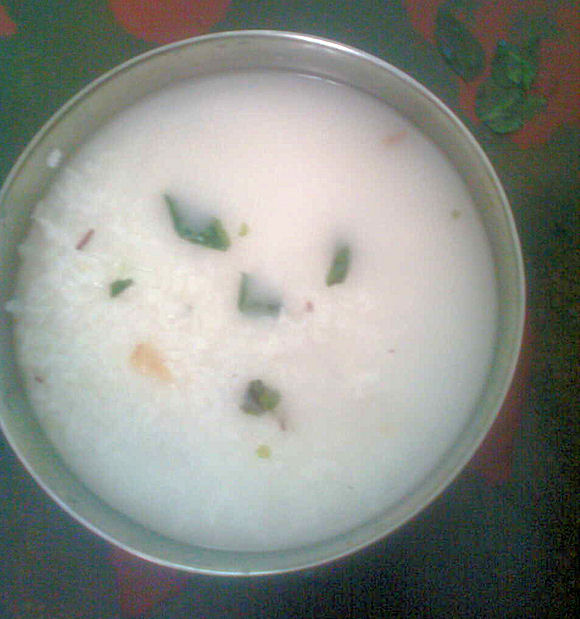
Abb.: Pakhala (ପଖାଳ - पखाळ) = Panta bhat (পান্তা
ভাত), ein Gericht auf der Grundlage von leicht
fermentiertem (saurem) Reis
[Bildquelle: Nayansatya / Wikipedia. -- GNU FDLicense]
1 काञ्जिक - kañjika n.: saurer Schleim
सन्धितं धान्यमण्डादि काञ्जिकं कथ्यते जनैः ।१ क। "Scum of gruel of cereals and other grains, kept undisturbed for some days and allowed to ferment (become sour) is known as kāñjika."
[Bhāvaprakāśa I, S. 479]
2 आरनालक - āranālaka n.: Āranālaka
कुल्माषधान्यमण्डादिसहितं काञ्जिकं विदुः ।७९ क। "Cooked pulses along with scum of grains (or thin gruel) mixed together is called kāñjika."
[Bhāvaprakāśa I, S. 518]
3 सौवीर - sauvīra n.: saurer Gerstenschleim
यवैस्तु निस्तुषैः पक्वैः सौवीरं साधितं भवेत् ॥७७ ख॥ "If yava (barley) is dehusked an cooked and the water fermented it becomes sauvīra."
[Bhāvaprakāśa I, S. 518]
4 कुल्माष - kulmāṣa n.: Kulmāṣa
अर्धस्विन्नास्तु गोधुमा अन्ये ऽपि चणकादयः ॥१८० ख॥
कुल्माषा इति कथ्यते शब्दशास्त्रेषु पण्डितैः ।१८१ क।"Godhuma (wheat), caṇaka etc. half cooked in steam is known as Kulmāṣa by scholars in literature."
[Bhāvaprakāśa I, 440]
5 अभिषुत - abhiṣuta n.: ausgepresst, "saure Grütze" (PW)
???
6 अवन्तिसोम - avantisoma n.: Avanti-Soma, "saure Grütze" (PW)
???
7 धान्याम्ल - dhānyāmla n.: "Getreide-Saures"
धान्याम्लं शालिचूर्णं च कोद्रवादिकृतं भवेत् ।११ क। "dhānyāmla is prepared by fermenting the powder (flour) of rice or kodrava etc."
[Bhāvaprakāśa I, S. 480]
8 कुञ्जल - kuñjala n.: "saurer Reisschleim" (PW)
???
Apiaceae - Doldenblütler
| 40a./b. sahasravedhi jatukaṃ bāhlikaṃ hiṅgu rāmaṭham सहस्रवेधि जतुकं बाह्लिकं हिङ्गु रामठम् ।४० क। [Bezeichnungen für Asafoetida (Harz von Ferula assa-foetida L. 1753):]
|
Colebrooke (1807): "Assa foetida."
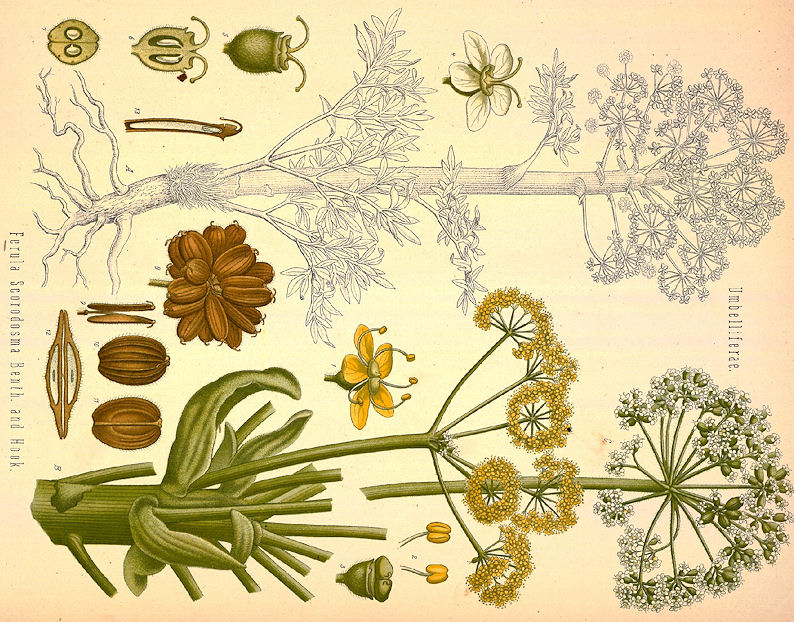
Abb.: Ferula assa-foetida L. 1753
[Bildquelle: Köhler, 1883-1914]
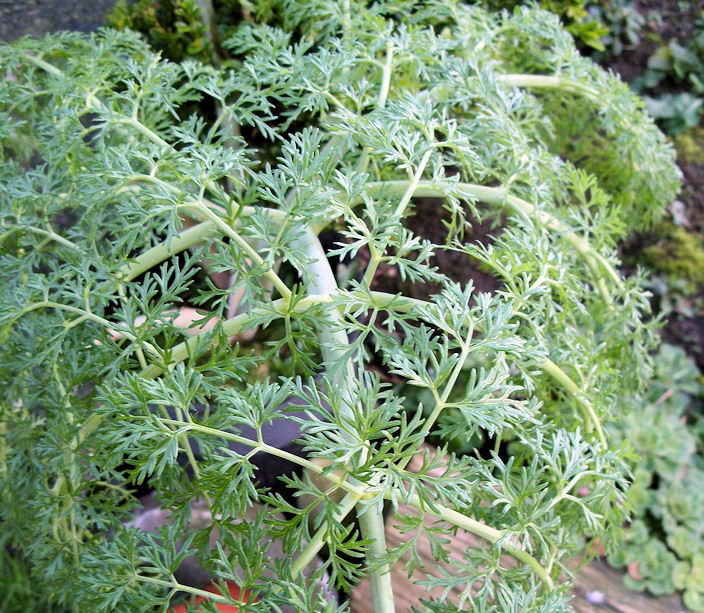
Abb.: Ferula assa-foetida L. 1753, UK
[Bildquelle: joysaphine. --
http://www.flickr.com/photos/joysaphine/3200592445/. -- Zugriff am
2011-07-12. --
Creative Commons Lizenz (Namensnennung, keine kommerzielle Nutzung)]
सहस्रवेधिन् - sahasravedhin n.: "tausendfach durchbohrend, tausendfach durchbohrt", Asafoetida
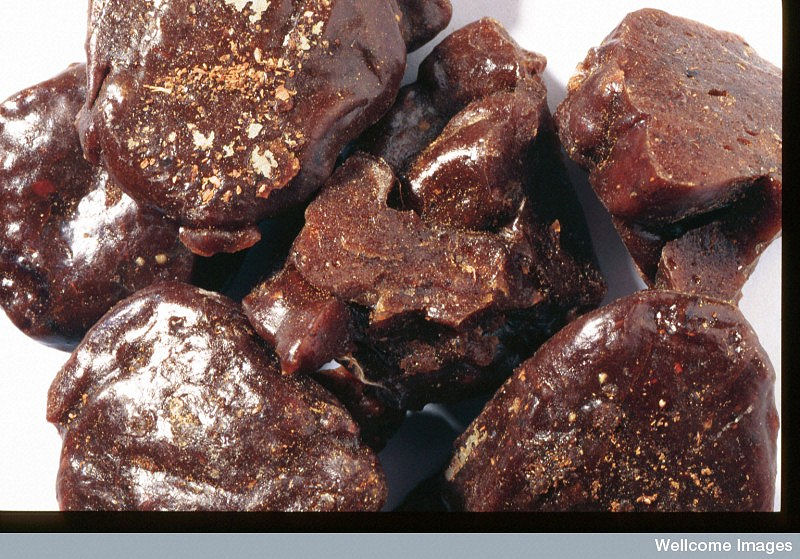
Abb.: सहस्रवेधि । Asafoetida
[Bildquelle: Efraim Lev and Zohar Amar / Wellcome Images. --
Creative Commons
Lizenz (Namensnennung, keine kommerzielle Nutzung, keine Bearbeitung)]
जतुक - jatuka n.: Lack, Gummi, Asafoetida
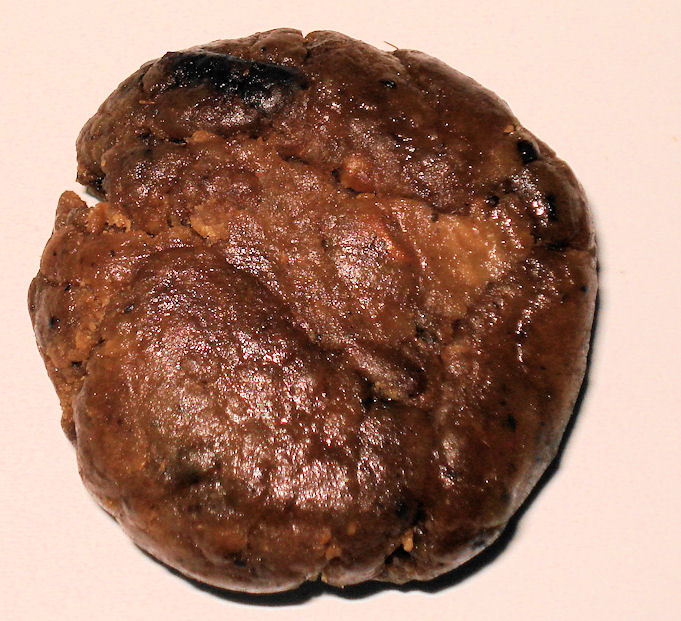
Abb.: जतुकम् । Asafoetida
[Bildquelle: Miansari66 / Wikimedia. -- Public domain]
बाह्लिक - bāhlika n.: aus Balkh (
بلخ, Nordafghanistan) stammend, Asafoetida

Abb.: Lage von Balkh (Bactra) an der Seidenstraße
[Bildquelle: Shizhao / Wikipedia. - GNU FDLicense]
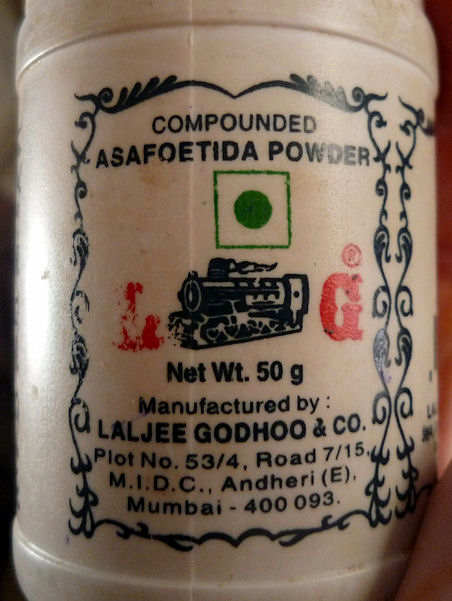
Abb.: बाह्लिकम् । Asafoetida
[Bildquelle: alon salant. --
http://www.flickr.com/photos/alon/3230734240/. -- Zugriff am 2011-07-12.
-- Creative
Commons Lizenz (Namensnennung, keine kommerzielle Nutzung, keine
Bearbeitung)]
हिङ्गु - hiṅgu n.: Teufelsdreck, Asafoetida
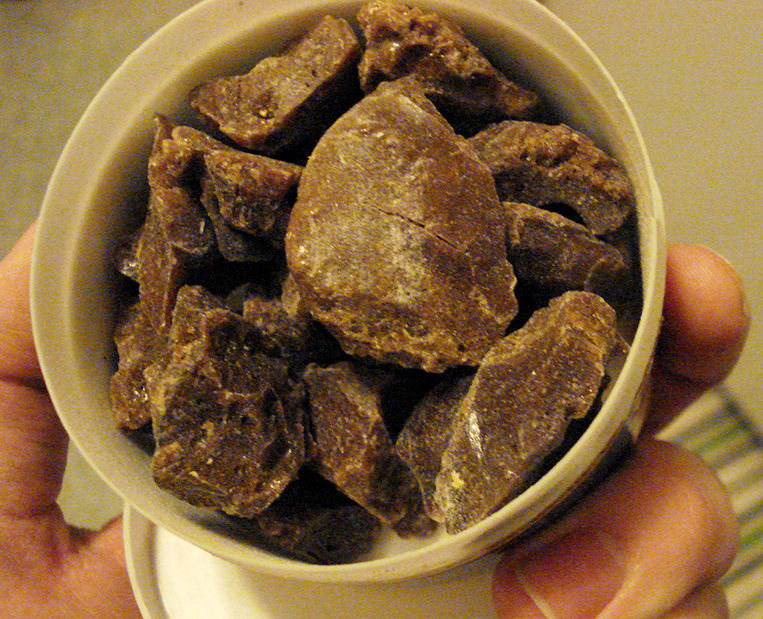
Abb.: हिङ्गु । Asafoetida
[Bildquelle: stumptownpanda. --
http://www.flickr.com/photos/stumptownpanda/2191729502/. -- Zugriff am
2011-07-12. --
Creative
Commons Lizenz (Namensnennung, keine kommerzielle Nutzung, share alike)]
रामठ - rāmaṭha n.: aus Rāmaṭha, Asafoetida
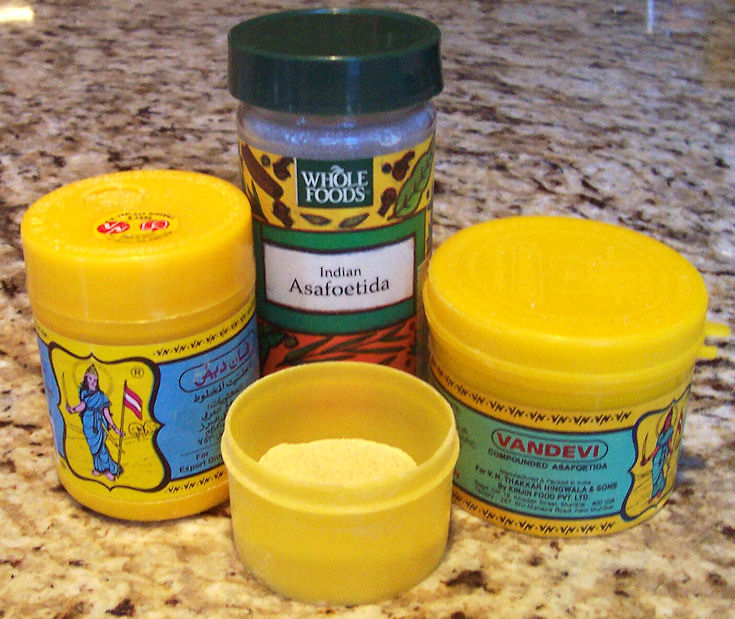
Abb.: रामठम् । Asafoetida-Pulver
[Bildquelle: Iustinus / Wikipedia. -- GNU FDLicense]
"Hiṅgu, commonly known as asafoetida, is the resin obtained by scratching the roots of the plant Ferula narthex Boiss., which is found in abundance in Afghanistan, Beluchisthan, Arabis, Iran, etc. In India it is seen in some parts of upper Kashmir. Resin is dried in sun and marketed. Market sample contains extraneous impurities like sticks, stones, fibres etc. Nowadays synthetic (artificially prepared) asafoetida is being used for culinary purposes to enhance the flavour of foods. It is used both in raw state as well as fried (oil or ghee)." [Quelle: Bhāvaprakāśa I, S. 174]
"FERULA FOETIDA, Regel. Fig.—Bentl. and Trim., e. 127 ; Trans. Linn. Soc. 2d. Ser. Botany, Vol. Pt. i., pl 12, 13, 14.
Hab.—Persia, Afghanistan. The gum-resin.
[...9
History, Uses, &c.--Commercial Asafoetida is collected from this plant in Western Afghanistan and Persia; in May, the mature roots begin to send up a flowering stem, which is cut off and the juice collected in the manner described by Kaempfer, who witnessed its collection in the province of Laristan in Persia. It was long supposed that commercial Asafoetida was the produce of F. Narthex, Boiss., a Tibetan plant which was discovered by Falconer in Astor, but there is no evidence of the drug ever having been collected from it. In May, 1884, Dr. Peters, of the Bombay Medical Service, when stationed at Quetta, observed the flowering stem of an Asafoetida plant which was being offered for sale in the bazar as a vegetable by the Kakar Pathans. Specimens which he kindly forwarded to one of us were identified by Mr. E. M. Holmes as F. foetida,, Kegel. Dr. Peters also found the dried root of the same plant in the drug shops, and learned that it was the plant from which Asafoetida was collected in Western Afghanistan. These facts were confirmed by Aitchison in May 1885, both as regards the source of commercial Asafoetida, and the use of the flower stalk as a vegetable. In his report upon the Botany of the Afghan Delimitation Commission, he remarks:—"In all stages of its growth, every part of the plant exudes upon abrasion a milky juice, which is collected and constitutes the drug of commerce. The stem in a young state is eaten raw or cooked." Aitchison says that a red clay called Tawah is mixed with the gum-resin at Herat, a statement which is only applicable to the kind of Asafoetida known in commerce as Kandahari Ring, to be presently noticed. Concerning the Laristan plant we are still without exact information, but we think it will prove to be F. foetida. The remarks made respecting the use of Asafoetida by the natives of India under F. alliacea are more or less applicable to the present article, which is often imposed upon the poorer classes as a substitute for the more expensive Hing. In modern European medicine, Asafoetida is used as a stimulant and antispasmodic in chronic bronchitis, hysteria and tympanitis ; it is often administered in the form of onema, as it is apt to give rise to a sense of weight and heat in the stomach when given by the mouth. Dr. Paolo Negri has reported the successful treatment of two cases of abortion with Asafoatida administered to the extent of one gram daily. In the first case the woman had aborted twice and in the second four times; both patients were free from syphilitic taint, and no cause for the abortion could be detected."
[Quelle: Pharmacographia indica : a history of the principal drugs of vegetable origin met with in British India / by William Dymock [1834-1892], C. J. H. Warden and David Hooper [1858-1947]. -- Bd. 2. -- London, 1891. -- S. 147ff.]
"FERULA ALLIACEA, Boiss. [= Ferula gabriella Rech. f. 1987] Hab.—Persia. The gum-resin.
[...9
History, Uses, &c.—The old Greek and Latin writers on Materia Medica mention two kinds of Silphium—one good or sweet, and the other fetid. Theophrastus in his History of Plants (vi., 8), speaks of two varieties, of the stem and of the root. [...] Dioscorides mentions two kinds, one coming from Cyrene and the other from Asia. Some consider the silphium of Cyrene to have been entirely different from our Asafoetida, but from a passage in Strabo this does not appear to have been the case. [...] Pliny's account of silphium or laserpitium is very confused, but he has collected some information which we now know to be correct. N. Myrepsicos appears to be the first writer who mentions the name
ασαφιτιδα, which he says is an Italian name for the σκονδολασαρον of the Greeks of his day. In the Ρudens of Plautus (B. C. 220) the scene of which is near Cyrano, frequent allusion is made to the growth of Laserpitiam there, and the preparation and export of the gum-resin, as forming the staple article of trade. The Greek and Latin authors agree in saying that the silphium or laser of Oyrene was the best, but from the works of Pliny and Scribonius Largus we learn that it was almost if not quite unobtainable in their time. Pliny relates that a single plant was presented to the Emperor Nero as a curiosity. The gum resin of F. alliacea is the Hing of the natives of India, the other kind being seldom used by them. In Sanskrit it is called Hingu, and is said to be so called from its killing or overpowering all other odours. In the Nighantas it bears various synonyms, amongst which may be mentioned Balhika, "coming from Balkh"; Ramatha, Bhūta-nasana, "destroying demons"; and Sula-nasana, "removing pain in the stomach"; it is described as hot, digestive, appetizing, pungent; a remedy for phlegm, rheumatism, griping, flatulence, diseases of the belly, satiety and worms. It increases the secretion of bile.Hindu medical writers direct it to be fried before being used. It is in great repute as a condiment among vegetarians, also as an antispasmodic in nervous affections; taken daily it is thought to ward off attacks of malarial fever.
Asafoetida must have been used in India from a very remote period, as the earliest Sanskrit writers mention it.
The plant is called Jatuka or Jātuka, a word derived from Jatu, "gum or lac it is described as a fragrant plant. Of the Mahometan writers on Materia Medica, Ibn Sina mentions two kinds of Asafoetida—tyib (good) and muntin (fetid), but gives no description of them. Ali Istakhri, who also lived in the 10th century, states that the drug is produced abundantly in the desert between Sistan and Makran, and is much used by the people as a condiment. The geographer Edrisi, who wrote about the middle of the 12th century, asserts that Asafoetida, called in Arabic Hiltit, is collected largely in Western Afghanistan. Haji Zein the druggist, in the 14th century, tells us that the two kinds of Asafootida are produced by two different plants, the black and the white Anjudān, and that the later plant produces the kind known as tyib (good). Mir Muhammad Mumin of Shiraz, who wrote in the 17th century, remarks that the Asafootida known as tyib has a reddish colour, and is produced by a plant vulgarly known as Kulah-par (cap-leaf), that known as muntin has a disagreeable odour like a leek, and is called at Ispahan Angusht-gandah, "stink finger." Aitchison, who travelled in Eastern Persia, and the neighbouring districts of Beluchistan and Afghanistan, with the Afghan Boundary Delimitation Commission (1884—85) found that the name Kema (
كما) was applied generally by the peasantry to the large umbelliferous plants in those parts, the Asa-foetida plant being distinguished as Anghuzah-kema and the Ammoniacum as Kandal-kema. The primary meaning of this word in Persian is a sleeve, and there can be no doubt that the similarity between the large sheathing petioles of these plants, and the loose Persian sleeve has suggested the comparison. It would appear then that the kind of Asafoetida called tyib by the Arabs and their followers is the drug of European commerce, the produce of Ferula foetida, Regel, and not that of F. alliacea, Boiss., which produces the Hing of India. In describing the medicinal properties of the drug, the Mahometan physicians closely follow Dioscorides.The flowering stems of the Asafoetida plants are eaten as a vegetable, as stated by Pliny. Aitchison notices their use for this purpose, and Dr. Peters forwarded to one of us the flowering stem of F. foetida, Regel, which he bad purchased in the bazar at Quetta.
Guibourt (1850) was the first European writer to point out the difference between the Asafoetida of India known as Hing and that of the European Pharmacopoeias which is called in India Hingra. Vigier, Gommes-résines des Ombelliféres (1869) calls Hing Asafoetida nauséeuse. We are indebted to Mr. Ardeshir Mehrban, a merchant of Yezd, for most of the following particulars regarding the source of this drug, Mr. Ardeshir, having himself visited the hills where the plant grows, was able to speak from personal observation. The plant which produces the Asafoetida used in India (Darakht-i-Anghuzeh-i-khalis) grows wild on the hills of Khorasan in very stony ground. The hill-men collect the gum-resin, taking an advance from the merchants. The time for collecting it is in the spring. The plant is not nearly so large as that which produces the Asafoetida of European commerce (Darakht-i-Anghuzeh-i-Lari), the diameter at the crown of the root being seldom more than two inches. The collectors protect each plant by building a small cairn of stones round it; they also remove the soil from the upper portion of the root, making a kind of circular basin. When the stem begins to grow it is cut off, and the upper part of the root being wounded, a small quantity of very choice gum is collected, which seldom finds its way into the market. Afterwards a slice of the root, about ¼ inch thick, is removed every two or three days with the exudation adhering to it, until the root is exhausted. The collected mass, consisting of alternate layers of root and gum-resin, when packed in skins (in quantities of about 100 lbs.) forms the Hing of Indian commerce; it is imported into Bombay in large quantities (about 2,500 cwts. annually), and is valued at the Custom House for assessment at Rs. 55 per cwt., commercial Asafoetida (Hingra) being only valued at Rs. 20. Early in 1874, the late Mr. Hanbury was kind enough to forward to one of us the proof-sheets of the article upon Asafoetida in the Pharmacographia, with a request for further information upon the subject. Unfortunately this could not be obtained in time for publication in the first edition of that work, as it involved sending to Persia for specimens of the plant and drug. In August, 1874, through the kindness of Mr. Ardeshir Mehrban, the first box of specimens was obtained, collected in the neighbourhood of Yezd. It contained— 1 st, the fresh root, with gum-resin adhering to the broken portions, and from which, upon section, a further exudation took place, at first opaque and milky, but drying in the course of a day or two into a light brown translucent substance. 2nd, the flower stem with flowers and very immature fruit; 3rd, the leaves. The plant arrived in a broken state, and was forwarded to Mr. Hanbury. Upon its receipt, he wrote:— "This morning I have devoted to the Asafoetida plant, and to a comparison of it with the figures and descriptions published by Borszczow, Balfour, and Hooker; but to decide on its botanical name is at present a difficult, if not impossible, task. I suppose it to be either the Narthex of the Edinburgh garden, or the Scorodosma of Borszczow, admitting for the moment that these are two good species; but the specimen does not fumish all the characters requisite for a strict comparison. I cannot tell whether the plant has the great sheathing petioles that form so striking a feature of the Narthex, nor is it possible to say whether the flower stem bore umbels arranged in a tall regular obelisk as Narthex, or crowded towards the summit as in Scorodosma. The foliage might do for either plant, though in having shorter segments it better agrees with the latter. The inflorescence which I have soaked and dissected consists of fertile female, and abortive flowers, none staminiferous. They are remarkably glabrous, not pubescent, as in Borszczow's plant; but this is of small moment."
Early in 1875, another box of specimens, with ripe fruit and a large supply of leaves, was obtained. In acknowledging it, Mr. Hanbury wrote:—"The box containing the Asafoetida plant arrived on the 29th January in excellent order, and its contents have given me great pleasure. The large plant though it had been rudely broken up and stuffed into a narrow space, proved, to be fairly perfect; and by soaking in cold water I was able to restore it to shape, and then to fix it together so as to make a really beautiful specimen, measuring three feet six inches in height. The leaves, also, by soaking them and taking some pains, form very decent herbarium specimens, and there are enough of them to supply several collections. But the chief point with me has been to determine the plant. From the foliage, the pink colour of the stem, and the size of the fruit, I judged it might be the Ferula alliacea of Boissier; but there being no specimen of this at Kew, I had to transmit a portion to M. Boissier, in Switzerland. His reply was definite. The plant from Yezd agrees in foliage exactly with F. alliacea, in stature, size of fruit, and other respects; but the fruit has a broader margin than in M. Boissier's specimens. However, If. Boissier thinks it may be set down as that species, a conclusion in which I entirely agree. Ferula alliacea was previously known to me only by description. You will observe that we have named it in the Pharmacographia as a possible source of Asafoetida. I have thought it right to make a wide distribution of the fine supply of seeds with which you have favoured me, and I have therefore sent packets to the Botanical Gardens of Kew, Edinburgh, Oxford, Paris, St. Petersburg, Bern, Strassburg, Florence, Pisa, Naples, Palermo, Athens, and to botanical friends on the Mediterranean Coast, in South Africa, and a few other places. As the seeds seemed fresh and good, I am in hopes that many plants may be raised.""
[Quelle: Pharmacographia indica : a history of the principal drugs of vegetable origin met with in British India / by William Dymock [1834-1892], C. J. H. Warden and David Hooper [1858-1947]. -- Bd. 2. -- London, 1891. -- S. 141 - 146.]
| 40c./d. tatpatrī kāravī pṛthvī vāṣpikā kabarī pṛthuḥ तत्पत्री कारवी पृथ्वी वाष्पिका कबरी पृथुः ।४० ख। Bezeichnungen für hiṅgupatrī f.:
|
Colebrooke (1807): "Hingupatri."
Zingiberaceae - Ingwergewächse
| 41a./b. niśāhvā kāñcanī pītā haridrā varavarṇinī निशाह्वा काञ्चनी पीता हरिद्रा वरवर्णिनी ।४१ क। Bezeichnungen für Curcuma longa L. 1753 - Gelbwurzel - Turmeric:
|
Colebrooke (1807): "Turmerick."
निशा - niśā f.: niśā (Nacht) und andere Bezeichnungen für Nacht
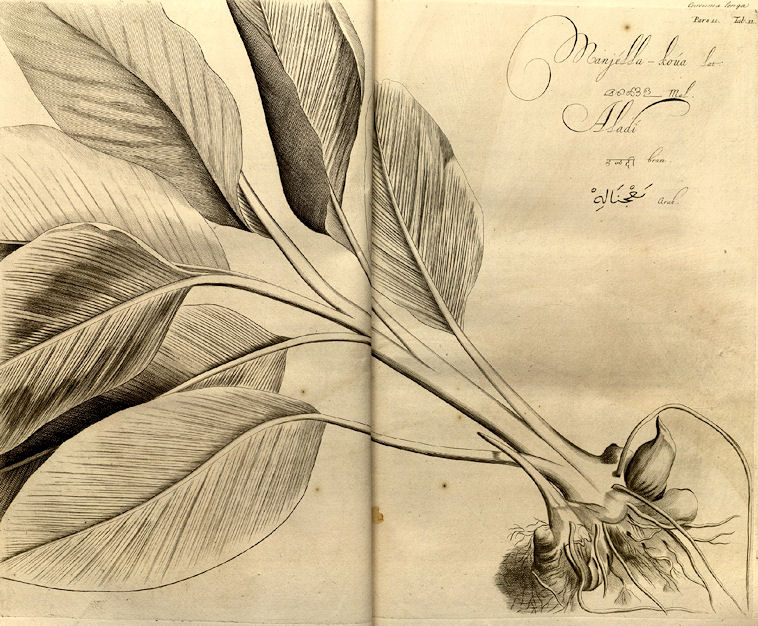
Abb.: निशा । Curcuma longa L. 1753 - Gelbwurzel - Turmeric
[Bildquelle: Hortus malabaricus XI. Fig. 11,
1692]
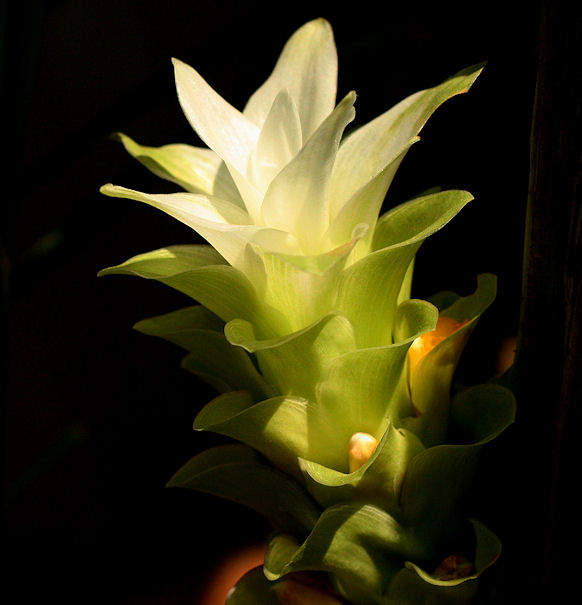
Abb.: निशा । Blüte von Curcuma longa L. 1753 - Gelbwurzel - Turmeric,
Maharashtra
[Bildquelle: Sankarshansen / Wikipedia. --
Creative
Commons Lizenz (Public domain)]
काञ्चनी - kāñcanī f.: Goldene
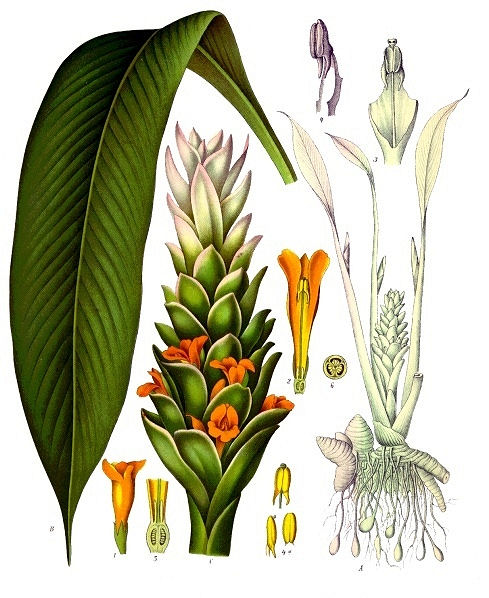
Abb.: काञ्चनी । Curcuma longa L. 1753 - Gelbwurzel - Turmeric
[Bildquelle: Köhler, 1883-1914]
पीता - pītā f.: Gelbe
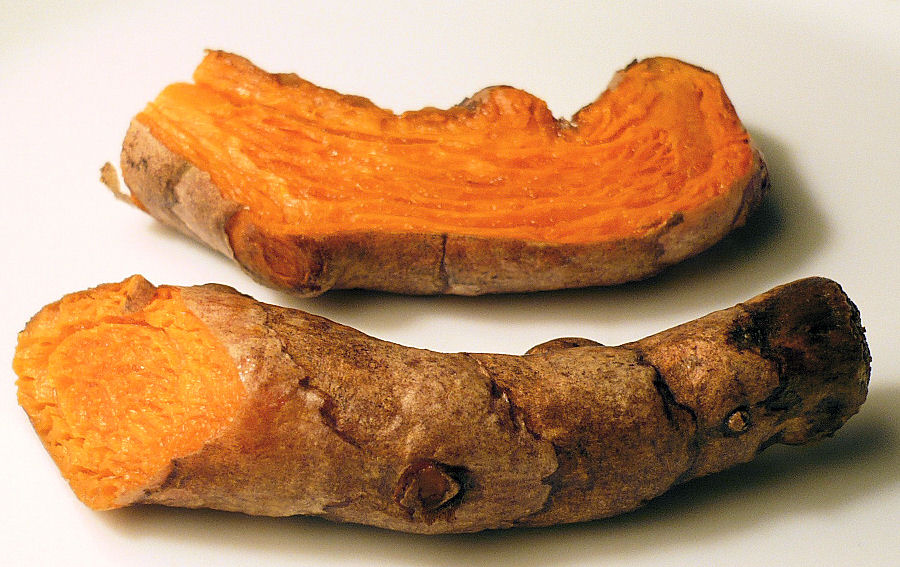
Abb.: पीता । Wurzel von Curcuma longa L. 1753 - Gelbwurzel - Turmeric
[Bildquelle: Badagnani / Wikipedia. -- GNU FDLicense]
हरिद्रा - haridrā f.: Gelbe, Gelbwurz
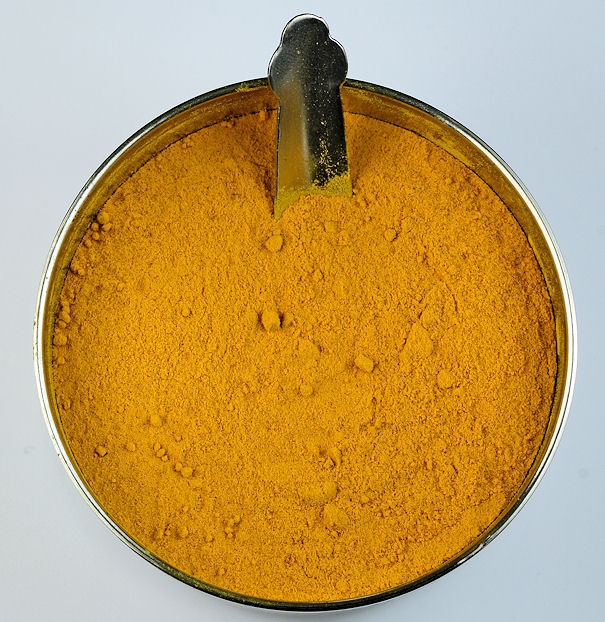
Abb.: हरिद्रा । Curcuma longa L. 1753 - Gelbwurzel - Turmeric
[Bildquelle: Sanjay Acharya / Wikipedia. -- GNU FDLicense]
वरवर्णिनी - varavarṇinī f.: von der besten Farbe (näml. der des Golds)
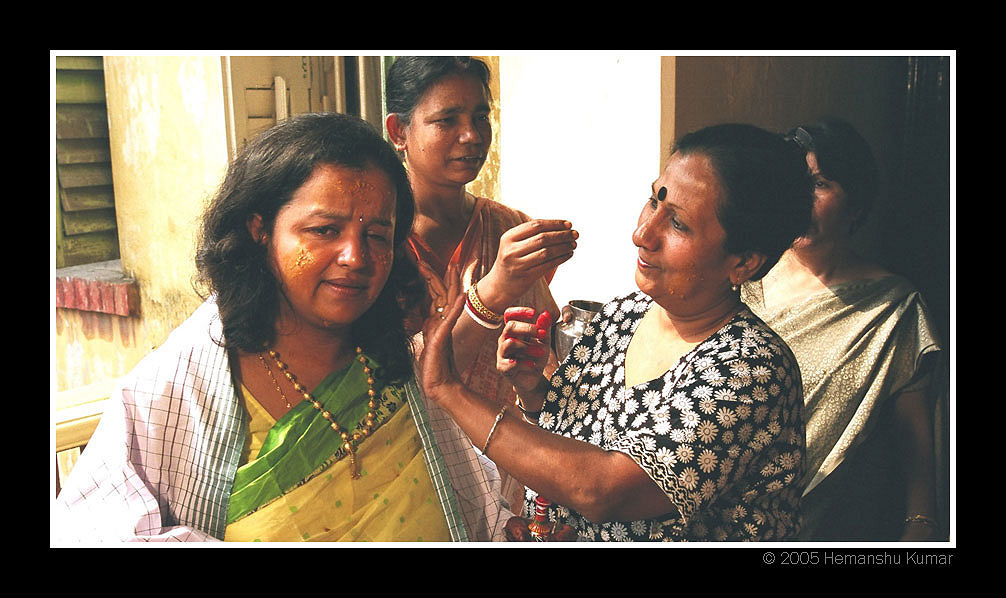
Abb.: वरवर्णिनी । Anbringen von Gelbwurz, West Bengal
[Bildquelle: Hemanshu Kumar. --
http://www.flickr.com/photos/hemanshu/4106648/. -- Zugriff am
2011-07-12. --
Creative Commons Lizenz (Namensnennung, keine kommerzielle Nutzung,
keine Bearbeitung)]
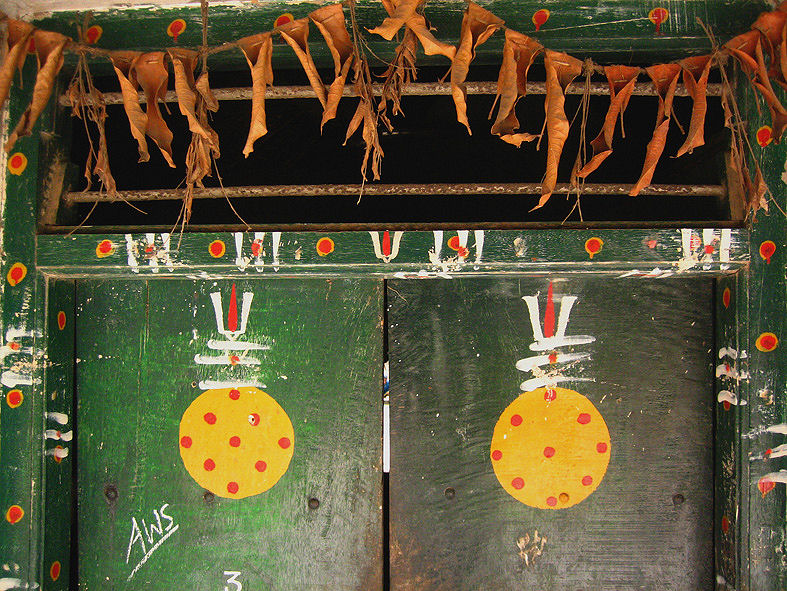
Abb.: वरवर्णिनी । Glückszeichen aus Gelbwurz, Puducherry - புதுச்சேரி
[Bildquelle: Meena Kadri. --
http://www.flickr.com/photos/meanestindian/308613975/. -- Zugriff am
2011-07-12. --
Creative Commons Lizenz (Namensnennung)]
"Curcuma longa (Roxb.) Long-rooted Turmeric
[...9
Description. — [...] flowers large, whitish, with a faint tinge of yellow, the tuft greenish white.
Fl. July—Sept.—Roxb. Fl. Ind. ed. Car. i. 32.—Rheede, xi. t. 11.
Medical Uses.—Cultivated in most parts of India. According to Rumphius, the Javanese make an ointment with the pounded roots and rub it over their bodies as a preservation against cutaneous diseases. The root is considered a cordial and stomachic, and is prescribed by native doctors in diarrhoea. It is also an ingredient in curries. There is a wild sort which grows in Mysore. The natives consider Turmeric in powder an excellent application for cleaning foul ulcers. The root in its fresh state has rather an unpleasant smell, which goes off when it becomes dried; the colour is that of saffron, and the taste bitter. Mixed with juice of the Nelli-kai (Emblica officinalis), it is given in diabetes and jaundice. The juice of the fresh root is anthelmintic, and the burnt root mixed with margosa oil applied to soreness in the nasal organs. The root is applied by the Hindoos to recent wounds, bruises, and leech-bites. Roxburgh states that it is frequently planted, in the neighbourhood of Calcutta, on land where sugar-cane grew the preceding year, the soil being well ploughed and cleaned from weeds. It is raised in April and May. The cuttings or sets—viz., small portions of the fresh root—are planted on the tops of ridges prepared for the purpose, about 18 inches or 2 feet apart. One acre thus sown will yield about 2000 lb. weight of the fresh roots.—(Ainslie. Roxb.) Lindley says that the juice is a test for free alkalies. Turmeric is regarded in the East Indies as an important bitter, aromatic stimulant and tonic, and is employed in debilitated states of the stomach, intermittent fevers, and dropsy. The starch of the young tubers forms one of the East Indian arrowroots.—(Royle.) It is to be observed that the same tubers which yield starch when young yield Turmeric when old, the colour and aroma which gives its character to the latter appearing to be deposited in the cells at a later period of growth.—(Lindley.) Turmeric paper is unsized paper steeped in tincture of Turmeric and dried by exposure to the air. It is employed as a test for alkalies, which render it reddish or brownish."
[Quelle: Drury, Heber <1819 - 1872>: The useful plants of India : with notices of their chief value in commerce, medicine, and the arts. -- 2d ed. with additions and corrections. London : Allen, 1873. -- xvi, 512 p. ; 22 cm. -- s.v.]
"CURCUMA LONGA, Linn. Fig—Bentl. and Trim. t. 269 ; Rheede, Hort. Mal, xi., t. 11.
Turmeric
Hab.— Parasnathin Behar. Cultivated elsewhere. The tubers.
[...]
History, Uses, &c.—Turmeric appears to have come into use in India as a substitute for saffron and other yellow dyes, which were used by the ancient Arians before they invaded the country. The Arians were, as we know, great worshippers of the solar system, hence they held in special estimation those plants which yield a golden-yellow dye resembling sunlight, and attributed to them protective and auspicious properties.
Turmeric, best known as Haridra in Sanskrit, has forty-six synonyms, such as Pita "yellow," Gauri "brilliant," Varnavat "having colour," Kamala "lustful," Nisa, Rajani, and all other words which signify "night." The use of the latter synonyms is variously explained. A distinguished professor of Sanskrit, whom we consulted, referred us lo one of the best commentators on the Amarakosa, who states that turmeric being a substance used for dyeing came to be called rajani, which etymologically means the material by which a thing is dyed, because the word rajani had already come to be used in the language to denote "night." A well-known Bombay Vaid, to whom we put the question, replied, "We have tradition that it is called 'night,' because in former times married women used daily to apply turmeric in the evening." On further enquiry we learned that this practice is not extinct, as he supposed, but still prevails in Goan villages, about Asnora, and probably elsewhere. Married women in the evening, when the house-work is completed, dip their hands in turmeric water and pass them lightly over their cheeks: the mistress of the house also performs the same office for any married friend who may happen to drop in at this time, and on some pretence detains her until the lamps are lighted. The reason they give for doing this is that the goddess Lakshmi may visit the house at this time. This goddess is regarded as the wife of Surya, and the practice is probably a survival of sun-worship. In Hindu ceremonial turmeric is almost always necessary. Amongst the most important occasions on which it is used we may mention the following as prevailing in most parts of India :—
A few days before the marriage ceremonies commence, five married women, or five virgins, anoint the bride with turmeric and oil upon the forehead) head, breast, back, and feet, and the bride puts on a robe dyed with turmeric, which she wears until the day of the marriage. Turmeric and oil is sent from the house of the bride to the bridegroom, who is anointed in a similar manner, and sends back a similar present to the bride.
The marriage contract is stained or spotted with turmeric. During the ceremonies the sisters of the bridegroom perform arta before him with a dish of turmeric water, and, dipping their fingers in it, touch his forehead.
A portion of the wall is daubed with turmeric and dashes of kunku after the arrival of the bride in the bridegroom's house, and before it are placed the kul and all the clothes and ornaments constituting the marriage presents; the bridegroom, and after him the bride, prostrate themselves before this spot.
The bridegroom ties a thread round the bride's wrist, to which is attached a piece of turmeric and a betelnut.
Towards the end of the ceremonies the bridal party play with turmeric water, dashing it over one another.
A woman who performs sati and married women when they die are taken to the funeral pile clothed in a robe dyed with turmeric.
At all times when puja, or worship of the gods, is made, turmeric is necessary.
When a new sari (robe) has been purchased, two threads are drawn out, one of which is offered to Surya, and the other to the goddess Tulasi, and turmeric is applied to the corner of the cloth.
Turmeric powder and kunku (a pigment made with turmeric and lime) is presented to women who have husbands living, and to temple dancing girls, in the month of Chaitra, or upon the occasion of the Nauratra.
The Akshata rice used in various ceremonies is coloured with turmeric and lime.
In the Ramayan turmeric is mentioned as one of the eight ingredients of the Arghya, a respectful oblation made to gods and venerable men. The following are the lines as given in the Hindi version of that poem :—
Dahi, dūrba, rochan, phal, mula,
Nav tulsi dal, mangal-mula.Curdled milk, Darva grass,
Yellow gall stones of the cow, Fruit,
Roots, Lotus and Tulsi leaves, Turmeric.Medicinally turmeric is described in the Nighantas as hot, bitter, pungent, astringent and drying; it corroborates the humors, prevents skin diseases, is a useful application to swellings, boils, &c., and is given in jaundice. As a domestic remedy it is in daily use ; rubbed down with oil it is applied to any roughness of the skin, with lime to bruises, sprains, and all kinds of wounds; a decoction forms a cooling eyewash, boiled with milk and sugar it is the popular remedy for a cold, the fumes are inhaled by those suffering from severe coryza, cloth dyed with turmeric is used as an eye-shade, and ghi mixed with powdered turmeric is given to relieve cough. As a spice the powder is an ingredient in curries and sweetmeats, and is used by every native of India. The leaves are also used as a condiment, especially with fish, which is wrapped in them and fried.
It is doubtful whether turmeric was known to the Greeks. Dioscorides mentions an Indian root as a kind of
κυπρειος resembling ginger, but having, when chewed, a yellow colour and bitter taste. The Mahometans use turmeric medicinally in the same manner as the Hindus; they also prescribe it in affections of the liver and jaundice on account of its yellow colour. There are many Arabic names ; the best known are Urūk-es-sufr "gold root," and Uruk-es-sabāghīn " yers' root." The modern Persian name is Zard-chubah [زردچوبه] "stick saffron." The editor of the Pharniacopoeia of India speaks favourably of the use of a decoction of turmeric in purulent conjunctivitis; he says it is very effectual in relieving the pain. In coryza he states that the fumes of burning turmeric directed into the nostrils cause a copious mucous discharge, and relieve the congestion. (Op. cit. p. 231.)Cultivation.—Turmeric requires a loamy soil and abundance of manure and water; the ground must be well worked and raised into ridges, 9 or 10 inches high and 18 to 20 broad, with intervening trenches 9 to 10 inches broad. The sets, which consist of small portions of the root, are planted on the tops of the ridges, at about 18 inches to 2 feet apart. One acre requires about 900 such sets, and yields about 2,000 lbs. of the fresh root. (Roxb.) Other authorities state the yield at from 1,000 to 2,000 lbs. Dalzell and Gibson give very much higher figures for the best garden soil in Guzerat, viz., 5,000 to 20,000 lbs. per acre. They state that the return to the cultivator is equal to that obtained from sugar-cane, viz., Es. 300 per acre. The time for planting is usually about the end of May, but it depends greatly upon the setting in of the rainy season. The crop may be raised in the following March or April; if left in the ground new shoots appear upon setting in of the following rains and the crop is lifted about 20 to 21 months after planting. In some parts of India it is not considered good practice to lift the plants the first year. When lifted, the roots have to be scalded in boiling water or by steaming them in their own juice, and to be dried in the sun or in an oven. Turmeric being much cultivated along with other crops it is impossible to obtain any reliable acreage returns."
[Quelle: Pharmacographia indica : a history of the principal drugs of vegetable origin met with in British India / by William Dymock [1834-1892], C. J. H. Warden and David Hooper [1858-1947]. -- Bd. 3. -- London, 1893. -- S. 407 - 411.]
| 41c./d. sāmudraṃ yat tu lavaṇam akṣīvaṃ vasiraṃ ca tat सामुद्रं यत् तु लवणम् अक्षीवं वसिरं च तत् ।४१ ख। Meersalz (sāmudraṃ lavaṇam n.) heißt
|
Colebrooke (1807): "Sea salt."
अक्षीव - akṣīva n.: nüchtern, Meersalz
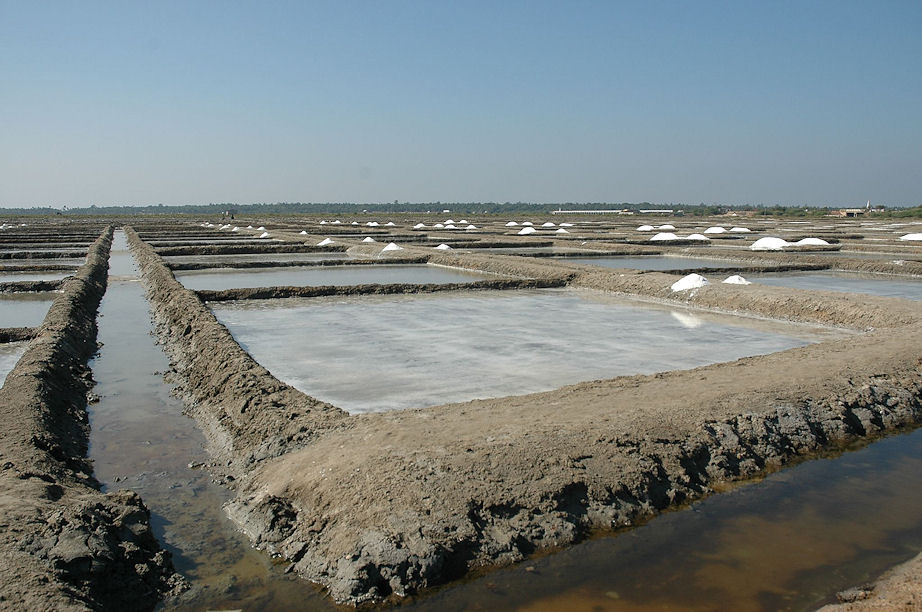
Abb.: अक्षीवम् । Meersalzgewinnung, südlich von Chennai -
சென்னை, Tamil Nadu
[Bildquelle: Ashley Bristowe. --
http://www.flickr.com/photos/95976276@N00/103998440/. -- Zugriff am
2011-07-12. --
Creative Commons Lizenz (Namensnennung, keine kommerzielle Nutzung,
keine Bearbeitung)]
वसिर - vasira n.: Meersalz
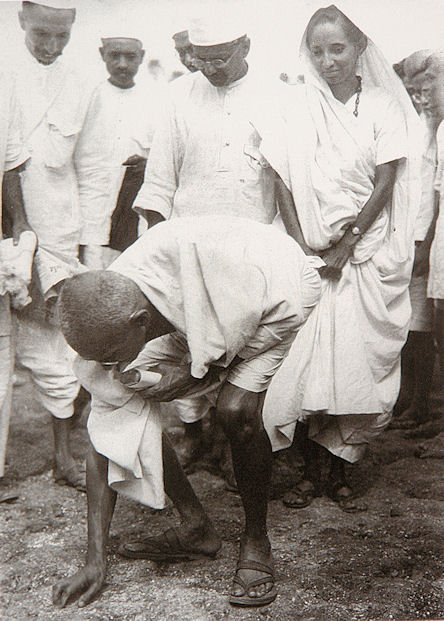
Abb.: वसिरम् । Gandhi hebt am Ende des Salzmarschs am Strand Salz auf, Dandi
- દાંડિ, Gujarat, 1930-04-05
[Bildquelle: Wikipedia. -- Public domain]
"SALT, COMMON.
[...]
Besides the common method of procuring culinary salt by evaporating1 sea water, which is that adopted in the Sunderbunds, where a quantity is made equal to the consumption of all the Bengal provinces, the native Indians prepare it by percolation, and crystallizing, from certain red soils which contain it; such as that found near Malaya Banaru, in Mysore, in Ayudh, and in the district of Benares.2 They also prepare it in inland situations, from salt springs or lakes3, similar in their nature to those of Luneburg, and the salt lake mentioned by Russel (see his Account of Aleppo) ; a lake of the same kind we find noticed by Macdonald Kinneir, in his excellent Geographical Memoir of Persia (p. 60.), at Bagtegan, about ten miles from Shiraz, in the province of Fars. Kirkpatrick, in his Account of Nepaul, tells us (p. 207), that salt is an import into that country from Thibet ; it is a valuable export from Java4 to the West coast of Sumatra. In India, that of the finest quality is manufactured in Cuttack, bringing, I understand, an annual revenue of not less than sixteen lacs of rupees; it is there got by evaporating sea water; that which is subsequently purified by boiling is called pangah.
1 In Java salt is procured by a similar process. See Crawford's History of the Indian Archipelago, vol. 1. p. 199.
2 See Remarks on the Husbandry of Bengal, p. 181.
3 There is a singular salt lake, called lake of Loonar, in Berar, in lat. 19°10' and long. 75°3' E. The salt of this lake is of a greyish colour, crystallized in cubes; it is used for seasoning food by the Mahometans, and in cleaning the shawls of cashmere. See Edin. Philosophical Journal, pp. 310, 311.
Hindoos, of all descriptions, set a very high value on salt; using the phrase "I eat his salt" to express a sense of gratitude, as much as to say "I am bound to serve him faithfully" They ascribe many ailments to the want of good salt, which, indeed, they often experience at places remote from the sea, where they get an impure, bitter sort, obtained in the preparation of salt-petre, from certain earths which contain it. The Vytians consider salt as we do, to be tonic, anthelmintic, and, externally, stimulant ; but do not appear to be aware, that in large doses it has been found to check vomiting of blood; nor that it has a considerable aperient quality when largely taken. The Brahmins, who eat nothing but vegetable food, believe, that without salt they would die. For an admirable account of the different methods of manufacturing salt, the reader may consult Aikin's Dictionary, art. Muriate oqf Soda. Analysed by Betzelius, salt was found to consist of 46.55 of muriatic acid, and 53.44 of soda.
4 See Sketches Civil and Military of Java, p. 41."
[Quelle: Ainslie, Whitelaw <1767-1837>: Materia Indica : or, Some account of those articles which are employed by the Hindoos, and other eastern nations in their medicine, arts, and agriculture : comprising also formulae with practical observations, names of diseases ... / London : Longmans, 1826. -- 2 Bde. - Vol. I, S. 370f.]
| 42a./b. saindhavo 'strī śitaśivaṃ māṇimanthaṃ ca sindhuje सैन्धवो ऽस्त्री शितशिवं माणिमन्थं च सिन्धुजे ।४२ क। Bezeichnungen für Salz, das aus dem Indusland (sindhu) kommt (= Steinsalz):
|
Colebrooke (1807): "Rock salt."
सैन्धव - saindhava m., n.: aus dem Indusland (sindhu) kommend
Die am längsten ausgebeutete und bedeutendste Steinsalzstätte im Indusland sind die Khewra Salt Mines (کھیوڑہ نمک کان) im Pakistanischen Punjab (پنجاب)

Abb.: सैन्धवम् । Lage der Khewra Salt Mines - کھیوڑہ نمک کان, Pakistan
[Bildquelle: OpenStreetMap & contributors. --
Creative
Commons Lizenz (Namensnennung, share alike)]

Abb.: सैन्धवम् । Khewra Salt Mines - کھیوڑہ نمک کان, Pakistan
[Bildquelle: Farhan. --
http://www.flickr.com/photos/farhan/4319691302/. -- Zugriff am
2011-07-12. --
Creative Commons Lizenz (Namensnennung)]
शितशिव - śitaśiva n.: "weiß und gnädig", Steinsalz
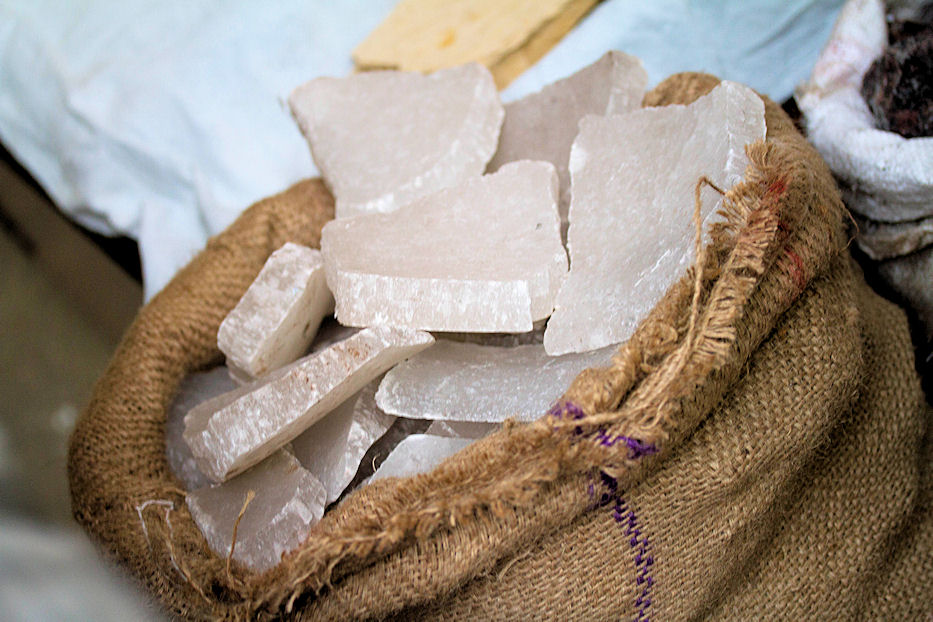
Abb.: शितशिवम् (?) ।
Steinsalz (?). Markt, Delhi
[Bildquelle: Aleks. --
http://www.flickr.com/photos/toastkid/5257048878/. -- Zugriff am
2011-07-12. --
Creative
Commons Lizenz (Namensnennung, keine kommerzielle Nutzung, share alike)]
"SALT, ROCK.
[...]
Rock salt is brought into Hindoostan from Thibet, where, as well as in Bootan and in Nepaul, Turner1 tells us, it is used for all domestic purposes; it is also an export from Lahore2, in which country, according to Rennet, in a tract betwixt the Indus and lhyluin rivers, it is found of a quality hard enough to make into vessels. It is a product of Persia, in the province of Mekran; and Mr. Elphinston, in his interesting Account of Cabul3, informs us, that near Callabaugh, on the bank of the Indus, there are immense quantities of rock salt, in large blocks, like rocks, in a quarry; and thence exported to India and Khorassan. [...]
1 See Turner's Embassy to the Court of the Tishoo Lama, pp. 406, 407.
2 See Pennant's View of Hindoostan, vol.i. p. 42.
3 Sec his work, p. 40. Also found at Bulkh. See same work, p. 147."[Quelle: Ainslie, Whitelaw <1767-1837>: Materia Indica : or, Some account of those articles which are employed by the Hindoos, and other eastern nations in their medicine, arts, and agriculture : comprising also formulae with practical observations, names of diseases ... / London : Longmans, 1826. -- 2 Bde. - Vol. I, S. 472.]
| 42c./d. raumakaṃ vasukaṃ pākyaṃ
viḍaś ca kṛtake dvayam रौमकं वसुकं पाक्यं विडश् च कृतके द्वयम् ।४२ ख। Salz vom Sambhar Salt Lake (सांभर झील, Rajasthan), heißt:
|
Colebrooke (1807): "Another sort. The same with Sāmbar salt, denominated Raumaka, as some say, from a mountain of salt called Rumā ; or, as others affirm, from a river or lake of the same name."
"Commonly known as Sāmbhar lavaṇa is prepared by drying water of Saṃbhar lake [सांभर झील] present in Rajasthan." [Bhāvaprakāśa I, S. 200]
रौमक - raumaka n.: aus der Rumā-Salzquelle
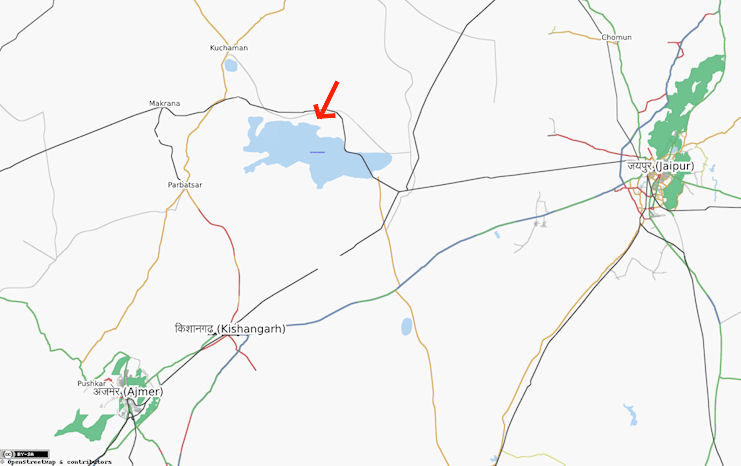
Abb.: रौमकम् । Lage des Sambhar Salt Lake - सांभर झील,
Rajasthan
[Bildquelle: OpenStreetMap & contributors. --
Creative
Commons Lizenz (Namensnennung, share alike)]

Abb.: रौमकम् । Sambhar Salt Lake - सांभर झील,
Rajasthan
[Bildquelle: ratna rathore. --
http://www.flickr.com/photos/ratnasinghrathore/5706516749/. -- Zugriff
am 2011-07-13. --
Creative Commons
Lizenz (Namensnennung, keine kommerzielle Nutzung, keine Bearbeitung)]
वसुक - vasuka n.: "gutes", Vasuka-Salz

Abb.: वसुकम् । Sambhar Salt Lake - सांभर झील,
Rajasthan
[Bildquelle: NASA / Wikipedia. -- Public domain]
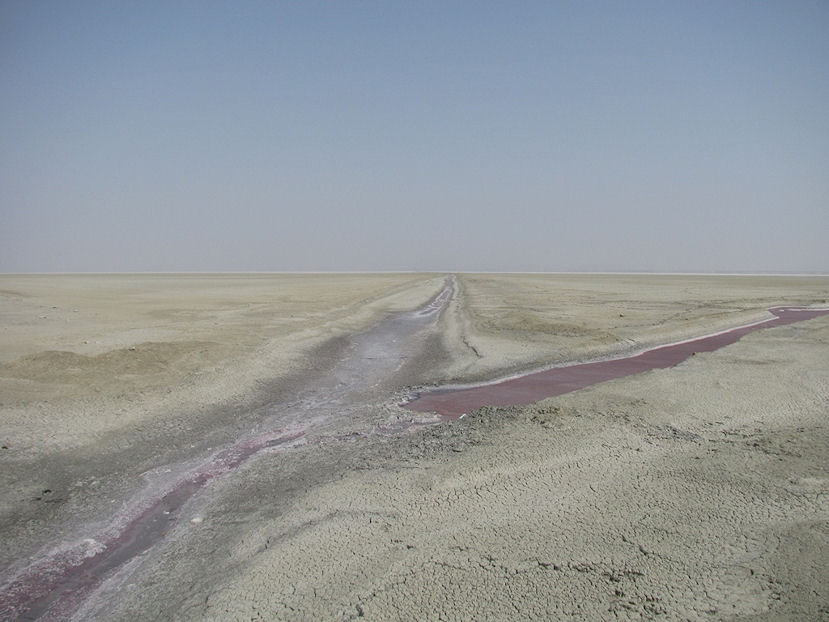
Abb.: वसुकम् । Sambhar Salt Lake - सांभर झील,
Rajasthan
[Bildquelle: ratna rathore. --
http://www.flickr.com/photos/ratnasinghrathore/5706517299/. -- Zugriff
am 2011-07-13. --
Creative Commons
Lizenz (Namensnennung, keine kommerzielle Nutzung, keine Bearbeitung)]
| 42c./d. raumakaṃ vasukaṃ pākyaṃ
viḍaś ca kṛtake dvayam रौमकं वसुकं पाक्यं विडश् च कृतके द्वयम् ।४२ ख। Bezeichnungen für künstliches (kṛtaka) Salz:
|
Colebrooke (1807): "Factitious salt. Obtained by boiling clay found on the sea shore ; or other earth impregnated with salt. Some remark, that the two first terms are names of different kind of salt which are equally factitious."
"This is known in the markets as kālā namak or black salt and is an artificial product, prepared by mixing saindhava (rock salt), harītakī [Terminalia chebula (Gaertn.) Retz.], āmalaki [Phyllanthus emblica L.], and sarjakṣāra (sodium carbonate) [Na2CO3] boiling these in water till evaporation is complete. Then the mass is broken in pieces and sold." [Bhāvaprakāśa I, S. 201]
पाक्य - pākya n.: durch Kochen gewonnen
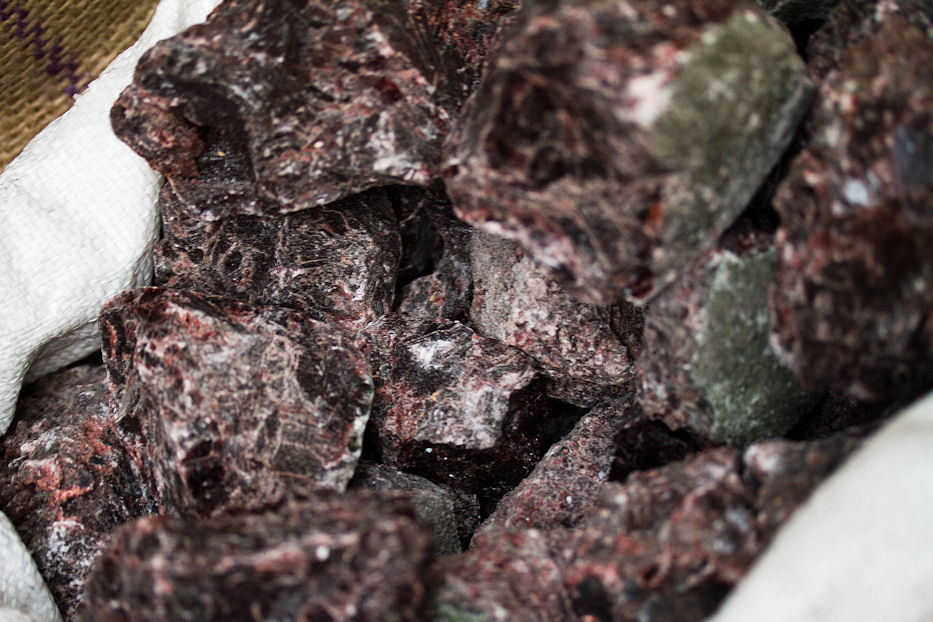
Abb.: पाक्यम् । Black salt - काला नमक, Markt, Delhi
[Bildquelle: Aleks. --
http://www.flickr.com/photos/toastkid/5257047284/. -- Zugriff am
2011-07-12. --
Creative
Commons Lizenz (Namensnennung, keine kommerzielle Nutzung, share alike)]
विड - viḍa m., n.: Viḍa-Salz
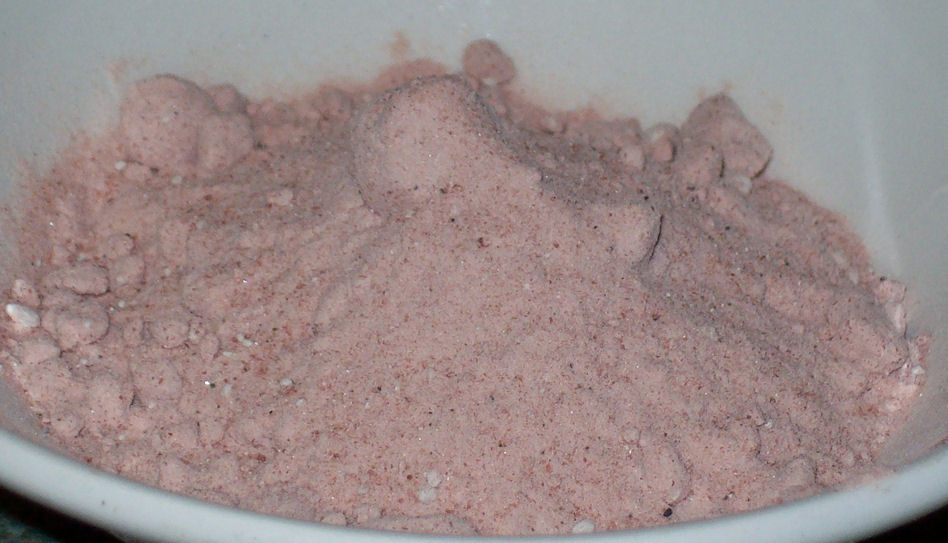
Abb.: विडम् । Black salt - काला नमक
[Bildquelle: Jellyboots / Wikipedia. -- GNU FDLicense]
| 43a./b. sauvarcale 'kṣarucake tilakaṃ tatra mecake सौवर्चले ऽक्षरुचके तिलकं तत्र मेचके ।४३ क। Bezeichnungen für सौवर्चल - sauvarcala n.: black salt, Sonch salt, "ein künstliches Salz, das durch Kochung von Soda mit den Früchten von Emblica officinalis [Phyllanthus emblica L.] (आमलक) erzeugt wird, Sochal salt" (PW)
|
Colebrooke (1807): "Socal salt, white."
"This also is an artificial product containing sodium chloride, sodium sulphide and little of sodium carbonate." [Bhāvaprakāśa I, S. 201]
"BIT-LABAN بت لابان also Sochul, also Kala-nemek (Hind.).
This medicine Dr. Fleming informs us, is of great repute amongst the Hindoos of Upper India. It is prepared by melting together for about six or seven hours, in an earthen pot, an impure muriate of soda, called samur, (from a salt lake of that name, near Mirzapore,) and emblic myrobalans (aonlas), in the proportion of fifty-six pounds of the muriate, to twenty ounces of the dried myrobalans.
Bit-laban, which is also sometimes termed bit-noben is generally used as a tonic in dyspepsia and gout, as a deobstruent in obstruction of the spleen, and my- senteric glands; and as a stimulant in chronic rheumatism and palsy: it is also considered as a vermifuge.
It would appear, that Mr. Accum, on analysing 480 grains of this medicine which had been sent to England, found, that that quantity contained black oxide of iron six grains, sulphur fourteen grains, muriate of lime twelve grains, muriate of soda four hundred and forty-four grains, loss four grains."
[Quelle: Ainslie, Whitelaw <1767-1837>: Materia Indica : or, Some account of those articles which are employed by the Hindoos, and other eastern nations in their medicine, arts, and agriculture : comprising also formulae with practical observations, names of diseases ... / London : Longmans, 1826. -- 2 Bde. - Vol. II, S. 41]
| 43a./b. sauvarcale 'kṣarucake tilakaṃ tatra mecake सौवर्चले ऽक्षरुचके तिलकं तत्र मेचके ।४३ क। Dunkles Sauvarcala-Salz heißt तिलक - tilaka n.: "Sesamkorn", schwarzes Sochal Salz |
Colebrooke (1807): "The same black. This appears to be the same with the black salt or Viṭalavana : a factitious salt containing sulphur."
| 43c./d. matsyaṇḍī phāṇitaṃ khaṇḍavikārau śarkarā sitā मत्स्यण्डी फाणितं खण्डविकारौ शर्करा सिता ।४३ ख। Zwei Arten von Zucker (खण्ड - khaṇḍa m.) sind:
|
Colebrooke (1807): "Raw sugar. The first term signifies granulated sugar ; and the second inspissated juice of sugarcane. खण्डविकारौ some, making this one of the exhibited terms, state three synonyma of syrup."
खण्ड - khaṇḍa m.: Zucker. Aus Saft von Saccharum officinarum L. 1753 - Zuckerrohr - Sugar Cane (siehe: Amarakośa II,4,5,29a./b.)
"Saccharum officinarum (Linn.) Do. Common Sugar-cane, Eng. Karimba, Mal. Karoomboo, Tam. Cherukoo bodi, Tel. Ook, Beng. Uch, Hind.
Description.—Culm 6-12 feet; panicles terminal, spreading, erect, oblong, 1-3 feet long, of a grey colour from the large quantity of long soft hairs surrounding the flowers, ramincations alternate, very ramous, expanding; flowers hermaphrodite in pairs, one sessile the other pedicelled ; calyx 2-leaved, smooth; corolla 1-valved, membranaceous, rose-coloured. Fl. July—Sept.—Roxb. Fl. Ind. i. 237.------Cultivated in most parts of India.
Economic Uses.—There is every reason to believe that sugar was manufactured from the cane in India in very early ages, and that the Greek word Sakcharon was employed for this identical product, and not for Tabasheer as formerly supposed. From the Arab Sukkur, the Persian Shukkar, and Sanscrit Sarkara, our word sugar is evidently derived. Herodotus certainly alludes to sugar in his fourth book, when he talks of "honey made by the hand of confectioners;" and he is the earliest writer who mentions it. Theophrastus talks of honey made from canes ; but Dioscorides, who flourished in the reign of Nero, was the first Greek writer who used the word Sakcharon. He says, " There is a sort of concreted honey which is called sugar found upon canes in India and Arabia Felix; it is a consistence like salt, and is brittle between the teeth like salt." Pliny also speaks of sugar brought from this country. It was certainly an article of commerce at the commencement of the Christian era, though the early Greek and Roman writers seem to have been imperfectly acquainted with its origin. Its first appearance in Europe is not exactly known, though it was introduced by the Saracens into Sicily, and was known at Venice in 990 a.d. From Sicily it soon spread to all countries of the Old World.
The sugar-cane is now cultivated over most parts of India, the estimated annual produce of sugar being about a million tons. In a report upon the sugar cultivation made by desire of the E. I. Company some years ago, it was stated that the three following kinds were cultivated:—
- 1st, The Kajooli, or purple-coloured cane. This grows on dry lands in Bengal It yields a sweet and rich juice of a darkish colour, but sparingly, and is hard to press.
- 2d, The Pooree, or light-coloured cane. This is deeper yellow when ripe. It grows on richer soil than the former, but the juice is less rich, and of a softer nature.
- 3d, The Kulloor, or white cane. This grows in moist swampy lands where the other two will not succeed. It yields a less strong sugar than the former, and has a more watery juice. It is more cultivated than the others.
According to Dr Buchanan, there are four kinds known in Mysore— namely, the Restali, the native sugar of Mysore, and the Puttaputti, from which alone the natives extract sugar, and which yields the best Jaggery. The two others are the Maracabo and Cuttaycabo.
The season of planting is soon after the commencement of the rains, in whatever districts the cane may be cultivated, the chief requisites being frequent ploughing of the soil, much manuring, careful removal of weeds; and in those varieties requiring much moisture the land must occasionally be artificially watered. Dr Roxburgh has given the following account of the cultivation of the Pooree or common yellow cane in the Rajamundry Circars :—
" The land is first well ploughed during the month of April and beginning of May. The field is then flooded from the river if there is not sufficient rain. The upper part of the cane is then cut into two lengths of one or two joints each (the lower part of the same canes are employed to make sugar from); these are placed Over the wet fields, at about fifteen or eighteen inches asunder in rows, the rows about four feet from one another, and trod under the soft wet surface with the foot. In six days after the planting the field is again flooded, if there has not been rain. In about eight days more the shoots appear ; the land is soon after slightly hoed and weeded, A month after the planting, some rotten chaff or other such manure is scattered about the young plants. Every ten or fifteen days, if there be not sufficient rain, the field is watered. Two months from the planting some stronger manure is strewed about the plants; and every fifteen 6r twenty days the field is slightly hoed, and the weeds rooted out.
"During the wet season, drains must be made to cany off the superabundant water. By August or September the cane will be from three to five feet high. In each shoot, the produce of every cutting, which may contain from three to six canes, a straight bamboo is struck into the earth, in the centre; to this the canes are tied by their leaves. In this country the leaves are never stripped from the cane, but as they wither are tied round them. This must impede the free circulation of air, which may be conceived hurtful. In January—viz., between nine and ten months from the time they were planted—the cane, when stripped of its leaves and the useless top cut off, will be about as thick as a good stout walking-cane, and from four to six feet long: they then begin to cut the cane, express the juice, and boil the sugar, which is with the natives here a very simple process,—a small mill turned by cattle squeezes the cane, and one boiler boils it."
Either a too wet or too dry season is injurious to the sugar-cane; in the former case the quantity of saccharine juice is much diminished. The crops suffer much from the depredations of wild animals, particularly elephants, wild hogs, jackals, besides caterpillars and worms. White ants are also very destructive. As a remedy against the attacks of the ants, the following recipe has been proposed :—
Assafoetida, 8 chittacks.
Mustard-seed cake, 8 seers.
Putrid fish, 4 seers.
Bruised butch-root, 2 seers ; or muddur, 2 seers.Mix the above together in a' large vessel, with water sufficient to make them into the thickness of curds; then steep each slip of cane in it for half an hour before planting; and lastly, water the lines three times previous to setting the cane, by irrigating the watercourse with water mixed up with bruised butch-root, or muddur if the former be not procurable.
A very effectual mode of destroying the white ant is by mixing a small quantity of arsenic with a few ounces of burned bread, pulverised flour, or oatmeal, moistened with molasses, and placing pieces of the dough thus made, each about the size of a turkey's egg, on a flat board, and covered over with a wooden bowl, in several parts of the plantations. The ants soon take possession of these, and the poison has continuous effect, for the ants which die are eaten by those which succeed them. They are said to be driven from a soil by frequently hoeing it They are found to prevail most upon newly broken up lands.
In Central India, the penetration of the white ants into the interior of the sets, and the consequent destruction of the latter, is prevented by dipping each end into buttermilk, assafoatida, and powdered mustard-send, mixed into a thick compound.—Simmonds. There are different processes for separating the sugar from the cane-juice in different countries. The following is the method which obtains in the East Indies: "The liquor, after being strained so as to separate the coarser feculencies, is boiled down, in a range of open boilers heated by a long flue, into a thick inspissate juice, the scum which rises during the operation being removed. When it is sufficiently evaporated, it is removed into earthern pots to cool, and in these it becomes a dark-coloured, soft, viscid mass, called goor or jaggery. Sometimes a little quicklime is added to the juice before boiling, which, by partly clarifying it, renders it capable of being formed into cakes or lumps. In general, however, if intended for subsequent clarification, the juice is merely boiled down, and sold in pots, in a granular honey-like state, to the boilers or refiners. These separate much of the molasses or uncrystallisable part of the juice, by putting the goor into a coarse cloth and subjecting it to pressure. The sugar, which in this state is called shuckar or khand, is further purified by boiling it with water, with the addition of an alkaline solution and a quantity of milk. When this has been continued until scum no longer rises upon the liquor, it is evaporated, and sometimes strained, and afterwards transferred to earthen pots or jars, wide at the top, but coming to a point at the bottom, which is perforated with a small hole, that, at the commencement of the operation, is stopped with the stem of a plantain-leaf. After it has been left for a few days to granulate, the holes in the pots are unstopped, and the molasses drain off into vessels placed to receive it" The sugar is rendered still purer and whiter by covering it with the moist leaves of some succulent aquatic plant,* the moisture from which drains slowly through the sugar and carries with it the dark-coloured molasses. After several days the leaves are removed, and the upper part of the sugar, which has been most purified, is taken away and dried in the sun. Fresh leaves are then added, by which another layer of sugar is whitened in like manner; and the operation is repeated until the whole mass is refined. The sugar thus prepared is called chenee, and is that which is commonly sent to England.
In regard to quantity and the purity of its sugar, the cane is preferred to any other plant containing saccharine juice. Six to eight lb. of the latter yield 1 lb. of raw sugar; and when properly ripe, 16 to 20 bandy-loads of canes ought to yield a hogshead of sugar. Sugar when simply sucked from the cane is highly nutritious. In the West Indies immense quantities of the cane are consumed in this way; and it has often been remarked how singularly the condition of, the negroes becomes changed during the cane harvest, when" they become far more plump and healthy than they are at other seasons. The alimentary properties of sugar are much lessened by crystallisation. The common brown sugar is more nutritious than what has been refined. To persons disposed to dyspepsia and bilious habits, sugar in excess becomes more hurtful than otherwise ; and, as Dr Prout observes, " the derangement or partial suspension of the power of converting the saccharine principle in man into the albuminous or oleaginous not only constitutes a formidable species of dyspepsia, but the unassimilated saccharine matter in passing through the kidneys gives occasion to the disease termed diabetes." Now in the blood of a person in perfect health scarcely any sugar exists, whereas during the disease above named it will be found abundantly in the system. Sugar, therefore, whether in the shape of fruit or in whatever form, should be entirely avoided by persons in that condition, and only taken in moderation by persons suffering from bilious habits.
Sugar when concentrated is highly antiseptic, and from a knowledge of its possessing this principle, it is frequently employed in the preservation of vegetable, animal, and medicinal substances. Dried fruits are often preserved a longer time by reason of the sugar contained in them. In cases of poisoning by copper, arsenic, or' corrosive sublimate, sugar has been successfully employed as an antidote ; and white sugar finely pulverised is occasionally sprinkled upon ulcers with unhealthy granulations. The Hindoos set a great value upon sugar, and in medicine it is considered by them as nutritious, pectoral, and anthelmintic.
The average annual quantity of cane-sugar imported into the markets of the civilised world at the present time may be taken at 1,500,000 tons, exclusive of what is made for consumption in the several countries where the canes grow, and this would probably amount to another million.—Simmonds. Lindley."
[Quelle: Drury, Heber <1819 - 1872>: The useful plants of India : with notices of their chief value in commerce, medicine, and the arts. -- 2d ed. with additions and corrections. London : Allen, 1873. -- xvi, 512 p. ; 22 cm. -- s.v.]
"SACCHARUM OFFICINARUM, Linn. Fig. — Woodville, t 266; Tussac, Fl. Antilles, i., tt. 23—25 ; Bentl. and Trim., t. 298.
Sugar-cane
Hab.—India. Cultivated in all warm climates.
[...]
History, Uses, &c.—If the wild form of the sugar-cane is to be anywhere now met with, it is in India, of which country it is undoubtedly a native, and where it has been cultivated from the earliest antiquity. Whether the species grown in China, S. sinense (Roxb.), is specifically the same is scarcely determined with certainty, but it is probably native in that country. (Bentl. and Trim.) The Sanskrit name of the plant is Ikshu, and it is also called Guda-trina, "the grass from which guda is made," and Guda-daru, &c.; from the juice (ikshurasa) the ancient Hindus prepared an extract by boiling, which, when soft and sticky, was called Ikshurasa-kvātha, Phānita, and Guda, but when allowed to drain and become dry was known as Guda-sarkara, Khanda or Khanda-sarkara, and Matoyandika. Twelve varieties of sugar-cane are mentioned by Sanskrit writers, but in this number are probably included other grasses belonging to the genera Saccharum, Sorghum, &c. , The root of the sugarcane is also used in Hindu medicine, and is considered to have demulcent and diuretic properties. It is an ingredient along with the roots of Saccharum sara, S. spontaneum, Eragrostis cynosuroides, and Cynodon dactylon in the compounds known as Trinapancha-mula and Kusa-valeha, which are much prescribed as adjuncts to metallic medicines in gonorrhoea and other affections of the urinary passages. A kind of rum was also obtained by the ancient Hindus from the juice of the cane or from guda and water fermented, which was known as Sidhu and Ganda.
The unrefined, dark-brown Guda or Phānita of the Hindus was known to the ancient Persians as Pāniz and Shakar; from it they manufactured the dry crystalline sugar which they call Kand or Nabāt,[...]. We have already stated (see Article on Bambusa) our reasons for believing that the σακχαρον of Dioscorides was not cane-sugar, viz., that no such article as sugar in a dry crystalline state was known in India at that time, the only kind of sugar used by the Hindus being the dark-brown mass known as guda, and which is still the kind of sugar most popular in India. This substance, as well as the guda prepared from the palm (φαινιξ), was called by the Greeks μελι (honey), and is mentioned by Herodotus, Theophrastus, Seneca, Strabo, and other early writers as "Honey of Canes" and "Honey made by human hands." The .vernacular names Misri, "Egyptian," for refined sugar, and Chini, "Chinese," for sugar-candy, point to these crystalline forms of sugar as comparatively recent introductions into India, and at the present time the sugar-candy of Indian commerce is chiefly imported from China. When we consider that the sugar-cane was known to the ancients from the time of Nearchus, it is hardly reasonable to suppose that Pliny could be so ill-informed as to speak of Saccharum, if by that name he meant cane-sugar, as only employed in medicine. Lucan, writing about the same time, was aware that the Hindus drank the juice of the cane:
"Quique bibunt tenera dulces ab arundine succos."
At the present day, the cane-presser, with his primitive press, is a familiar personage at Indian fairs, where he dispenses the luscious juice to his customers at about twopence a pint.
Sugar, under the name of Shi-mi "stone honey," is frequently mentioned in the ancient Chinese annals among the productions of India and Persia; and it is recorded that the Emperor Tai-tsung (A.D. 626—650) sent an envoy to the kingdom of Magadha in India, to learn the method of manufacturing it. (Bretschneider, Chinese Botanical Works, 1870, 46.) The Chinese acknowledge that the Indians between A.D. 766 and 780 were their first teachers in the art of making sugar. An Arabian writer, Abu Zaid-el-Hasan, states that about A.D. 850 the sugar-cane was growing on the north-eastern shore of the Persian Gulf; and in the following century, the traveller Ali Istakhri found sugar abundantly produced in the Persian Province of Kuzistan. About the same time (950) Moses Chorenensis stated that the manufacture of sugar was flourishing near the celebrated school of medicine at Jondisabur in the same province, and remains of this industry in the shape of millstones, &c., still exist near Ahwas.
Persian and Arabian physicians of the 10th and 11th centuries, such as Rāzi, Ali Abbas, and Ibn Sina, introduced sugar (Sukkar ) into medicine. The Arabs cultivated the cane in many of their Mediterranean settlements, as Cyprus, Sicily, Italy, Northern Africa, and Spain. The Calendar of Cordova shows that as early as A. D. 961 the cultivation was well understood in Spain, which is now the only country in Europe where sugar-mills still exist.
The importance of the sugar manufacture in the East was witnessed by Marco Polo, Barbosa, and other European travellers ; and the trading nations of Europe rapidly spread the cultivation of the cane over all the countries of which the climate was suitable. The ancient cultivation in Egypt, probably never quite extinct, was revised on an extensive scale by the Khedive Ismail Pasha. (Pharmacographia.)
Sugar is of comparatively little value for its independent effects, but few substances are more useful as an associate of other medicines, whether to preserve them from oxidation and decomposition, to conceal or improve their taste, or to give them special pharmaceutical forms.
[...]
Cultivation.—The sugar-cane season comprises nearly a twelvemonth. The land chosen is usually a good loam or light clay manured. The leafy ends of the preceding season's canes are cut off, or the whole cane is chopped into pieces so as in any case to include two nodes or joints, and these, to the number of about 20,000 per acre, are planted in furrows in January and February. The land is irrigated occasionally from this time to the commencement of the rains. The harvest begins in the beginning of December, and the cutting and crushing of the canes and boiling of the juice is carried on till January and February. Excepting the few mills under European management, the crushing and boiling is performed by primitive, and, therefore, rude processes. The average outturn per cent, of cane in the North-West Provinces is stated by Messrs. Duthie and Fuller to be as follows: 100 of canes=15 of juice=18 of guda (unrefined sugar) or 17.5 of shakar (dry, unrefined sugar), or 19.5 of rāb (syrupy sugar). The natives generally manufacture the juice into the two kinds of guda, called in the vernaculars gūra or gūla."
[Quelle: Pharmacographia indica : a history of the principal drugs of vegetable origin met with in British India / by William Dymock [1834-1892], C. J. H. Warden and David Hooper [1858-1947]. -- Bd. 3. -- London, 1893. -- S. 592ff.]
मत्स्यण्डी - matsyaṇḍī f.: stark eingedickter, schon fester Zuckerrohrsaft (Zucker mit Melasse, Jaggery -
गुड़)
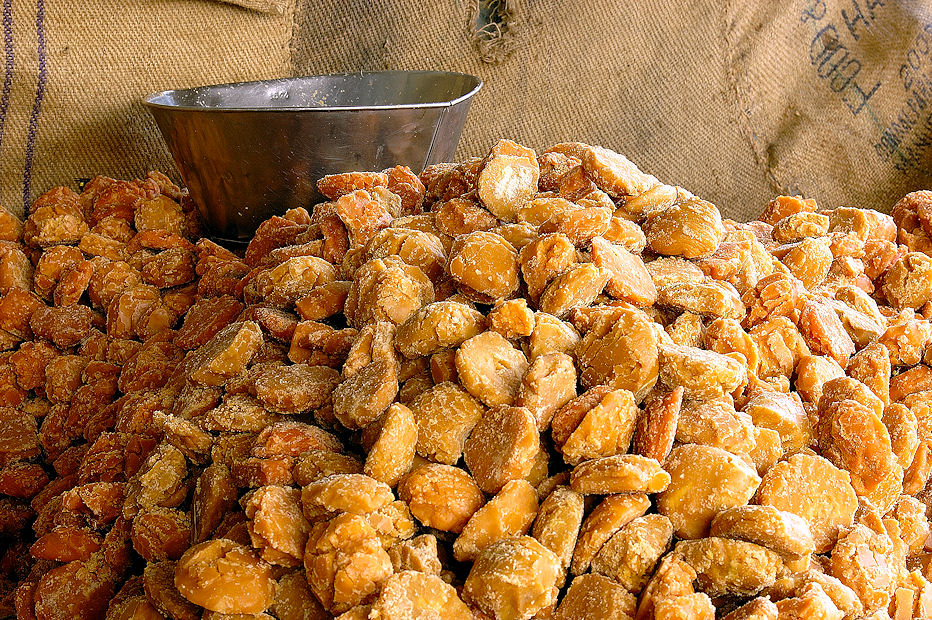
Abb.: मत्स्यण्डी
। Jaggery -
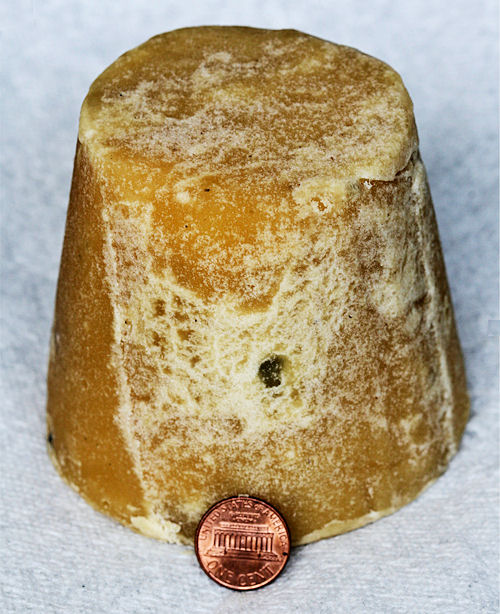
Abb.: मत्स्यण्डी
। Jaggery -
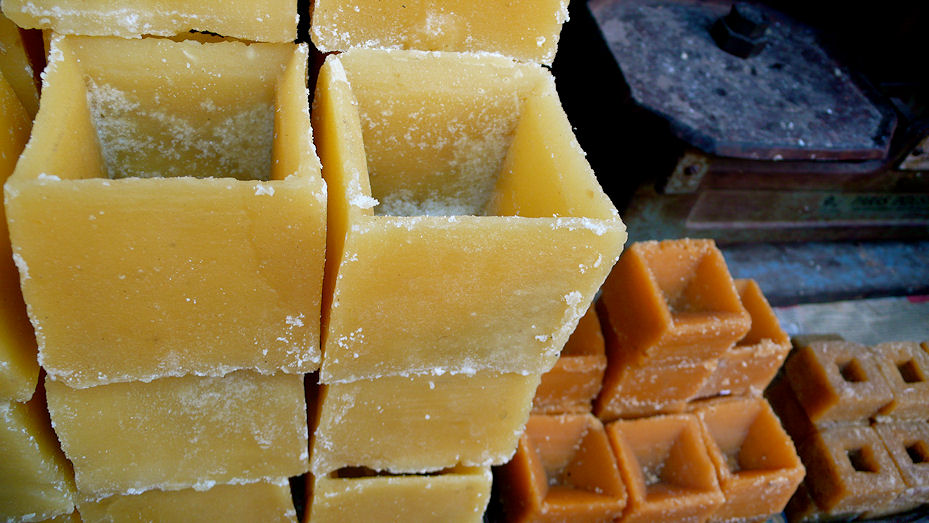
Abb.: मत्स्यण्डी
। Jaggery - ಬೆಲ್ಲ, Markt, Mysore -
ಮೈಸೂರು, Karnataka
[Bildquelle: Jennifer Turek. --
http://www.flickr.com/photos/groovegrrrrrl/3522205580/. -- Zugriff am
2011-07-13. --
Creative Commons Lizenz (Namensnennung, keine Bearbeitung)]
फाणित - phānita n.: eingedickter, noch sehr flüssiger Zuckerrohrsaft (Zuckerrohr-Sirup)
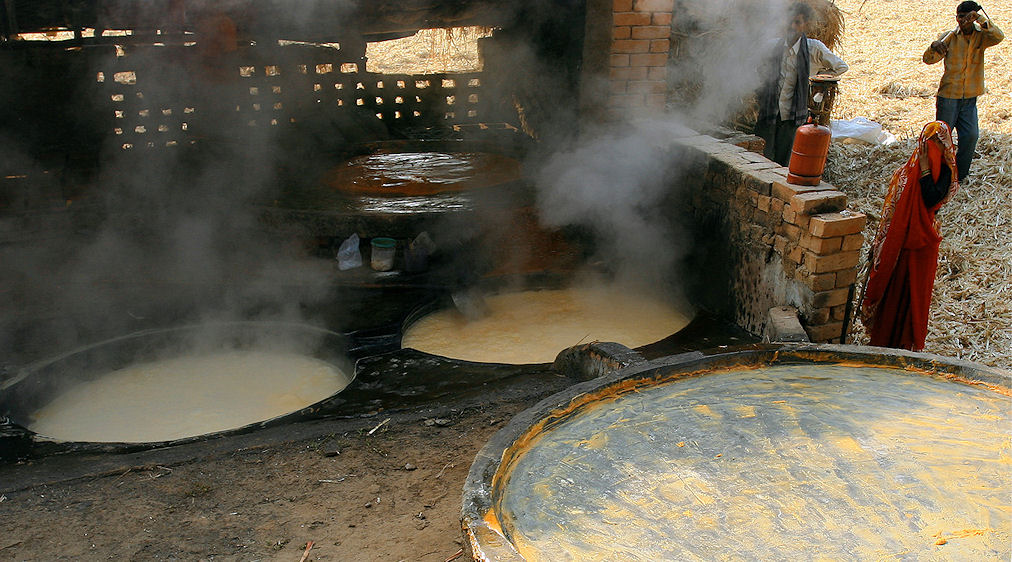
Abb.: फाणितानि । Eindicken von Zuckerrohrsaft, Patha Panihar, Madhya Pradesh
[Bildquelle: Carol Mitchell. --
http://www.flickr.com/photos/webethere/2177392313/. -- Zugriff am
2011-07-13. --
Creative Commons Lizenz (Namensnennung, keine Bearbeitung)]
| 43c./d. matsyaṇḍī phāṇitaṃ khaṇḍavikārau śarkarā sitā मत्स्यण्डी फाणितं खण्डविकारौ शर्करा सिता ।४३ ख। Weißer Zucker heißt शर्करा - śarkarā f.: weißer Kristallzucker |
Colebrooke (1807): "Refined sugar. Clayed : others say, candied."
शर्करा - śarkarā f.: weißer Kristallzucker
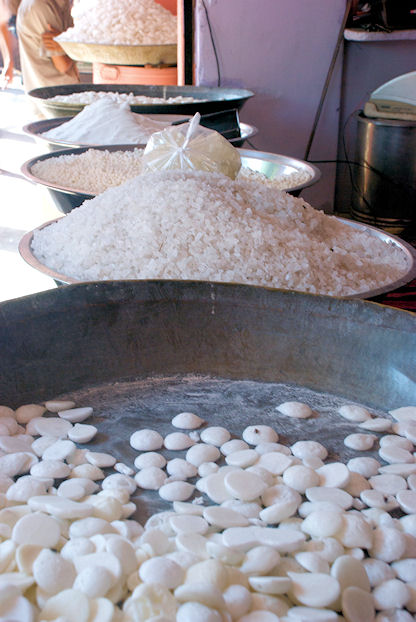
Abb.: शर्करा । Zuckerverkäufer, Jaipur - जयपुर, Rajasthan
[Bildquelle: Kevin Jones. --
http://www.flickr.com/photos/kj-an/3065017178/. -- Zugriff am
2011-07-13. --
Creative Commons Lizenz (Namensnennung)]
| 44a./b. kūrcikā kṣīravikṛtiḥ syād rasālā tu mārjitā कूर्चिका क्षीरविकृतिः स्याद् रसाला तु मार्जिता ।४४ क। Ein (bestimmtes) Milchderivat heißt कूर्चिका - kūrcikā f.: Knollenmilch (Quark, Topfen) |
Colebrooke (1807): "Inspissated milk."
कूर्चिका - kūrcikā f.: Knollenmilch (Quark, Topfen)
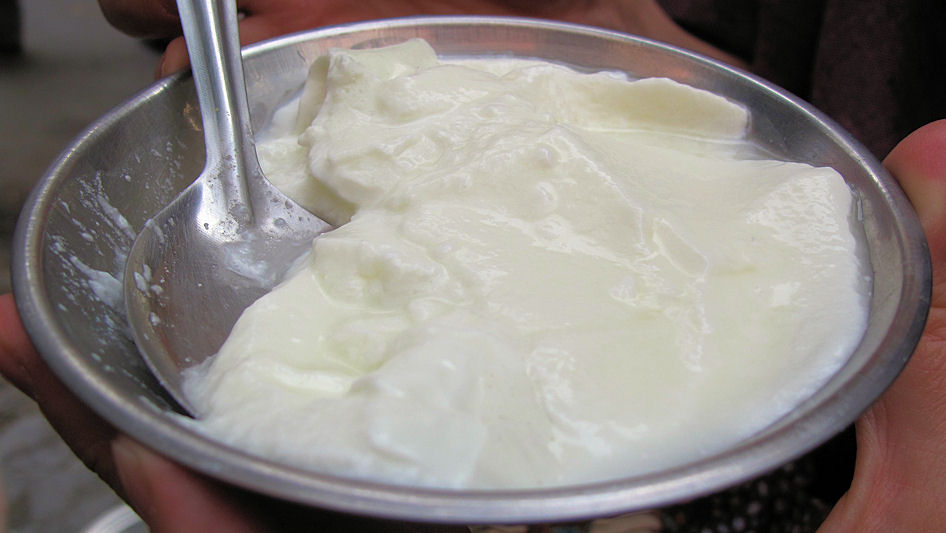
Abb.: कूर्चिका । "Curd" von Wasserbüffel-Milch, Kolkata -
কলকাতা, West Bengal
[Bildquelle: Daniel Roy. --
http://www.flickr.com/photos/backpackfoodie/4328940265/. -- Zugriff am
2011-07-13. --
Creative
Commons Lizenz (Namensnennung, keine kommerzielle Nutzung, share alike)]
"Der Quark, des -es, plur. doch nur von mehrern Arten, die -e. 1) Der dicke zusammen geronnene Teil der Milch nach den davon geschiedenen Molken, welcher an einigen Orten auch Käse, Käsequark, in Baiern Topfen und in der Schweiz Buldern genannt wird, und woraus man unter andern die Käse bereitet. Wenn man ihn nicht zu Käse verhärten lässt, sondern ihn auf Brot statt der Butter streicht, so heißt er in Obersachsen Streichkäse, in den niedrigen Sprecharten aber steifer Matz, in Niedersachsen Käsebutter." [Quelle: Adelung, Johann Christoph <1732 - 1806>: Grammatisch-kritisches Wörterbuch der Hochdeutschen Mundart. -- Leipzig, 1793 - 1801. -- s. v.]
| 44a./b. kūrcikā kṣīravikṛtiḥ syād rasālā tu mārjitā कूर्चिका क्षीरविकृतिः स्याद् रसाला तु मार्जिता ।४४ क। [Bezeichnungen für gekäste Milch (Käsebruch) mit Zucker und Gewürzen:]
|
Colebrooke (1807): "Curds with sugar and spices."
रसाला - rasālā f.: Rasālā, gekäste Milch (Käsebruch) mit Zucker und Gewürzen
"One āḍhaka of sour curds prepared from buffalos milk devoid of its water, two prastha of clean powdered sugar and half ghaṭa of cows milk are mided well, poured over a thick cloth, tied to the mouth of a fresh mud pot, stirring, slowly over the cloth and thus filtered. Powder of seeds of elā, lavaṅga, candra (karpūra) and marica are added to the fluid and used. This known as Rasālā (sikharana) by name was prepared by Bhīma who was fond of food and consumed again and again by Kṛṣṇa with great pleasure. Now-a-days it is being consumed daily except in vasanta (spring season), since it makes of great increase of vigour, vitality and strength of all sense organs. In grīṣma (summer) and śarat by all who get emaciated by the heat of the sun, who get exhausted/debilitated by too much indulgence in women (sex) who become emaciated by exertion from long distance walk; for these kinds off persons this (rasālā) provides immediate nourishment to the body.
Rasālā increases semen, strength, help taste, mitigates vāta and pitta, augments digestive fire, is nourishing, unctuous, sweet, cold in potency, laxative, cures bleeding disease, thirst, burning sensation and nasal catarrah."
[Bhāvaprakāśa I, S. 435f.]
| 44c./d. syāt temanaṃ tu niṣṭhānaṃ triliṅgā vāsitāvadheḥ स्यात् तेमनं तु निष्ठानं त्रिलिङ्गा वासितावधेः ।४४ ख। [Bezeichnungen für Brühe, Soße:]
|
Colebrooke (1807): "Sauce or condiment."
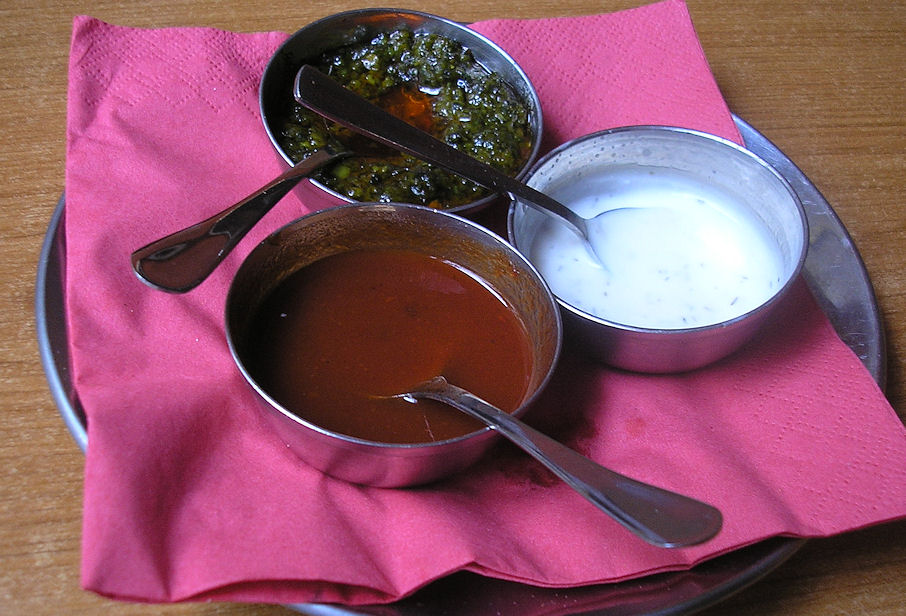
Abb.: तेमनानि । Indische Soßen
[Bildquelle: Deror avi / Wikimedia. --
Creative Commons
Lizenz (Namensnennung)]
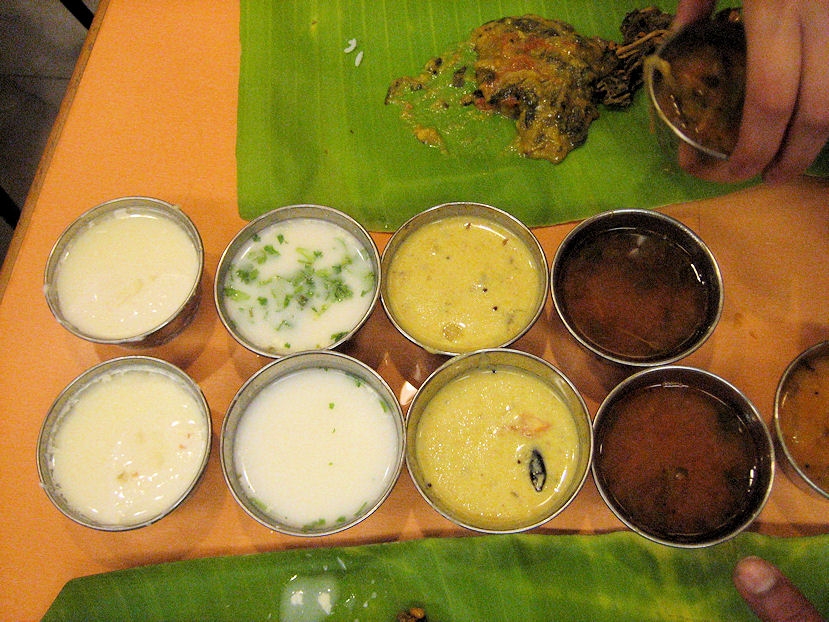
Abb.: तेमनानि । Bangalore - ಬೆಂಗಳೂರು,
Karnataka
[Bildquelle: Tricia Wang 王圣捷. --
http://www.flickr.com/photos/triciawang/2676441828/. -- Zugriff am
2011-07-13. --
Creative
Commons Lizenz (Namensnennung, keine kommerzielle Nutzung, share alike)]
निष्ठान - niṣṭhāna n.: Grundlage, Beilage; Brühe, Würze
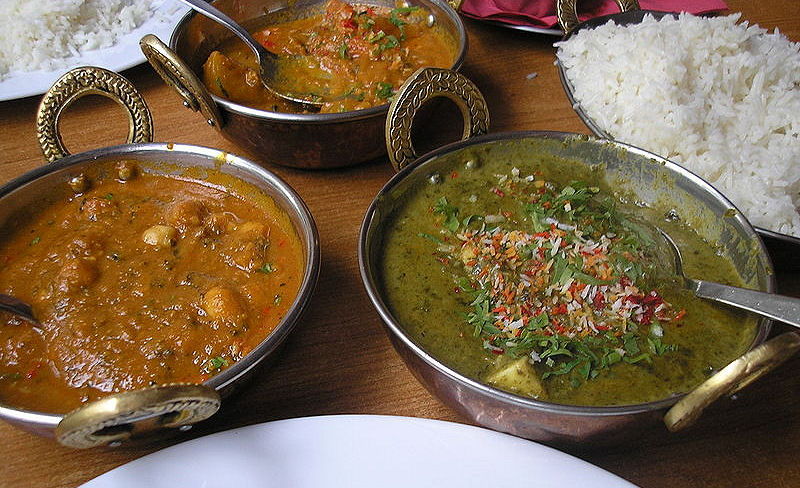
Abb.: निष्ठानानि । Indische Würz-Soßen
[Bildquelle: Deror avi / Wikimedia. --
Creative Commons
Lizenz (Namensnennung)]
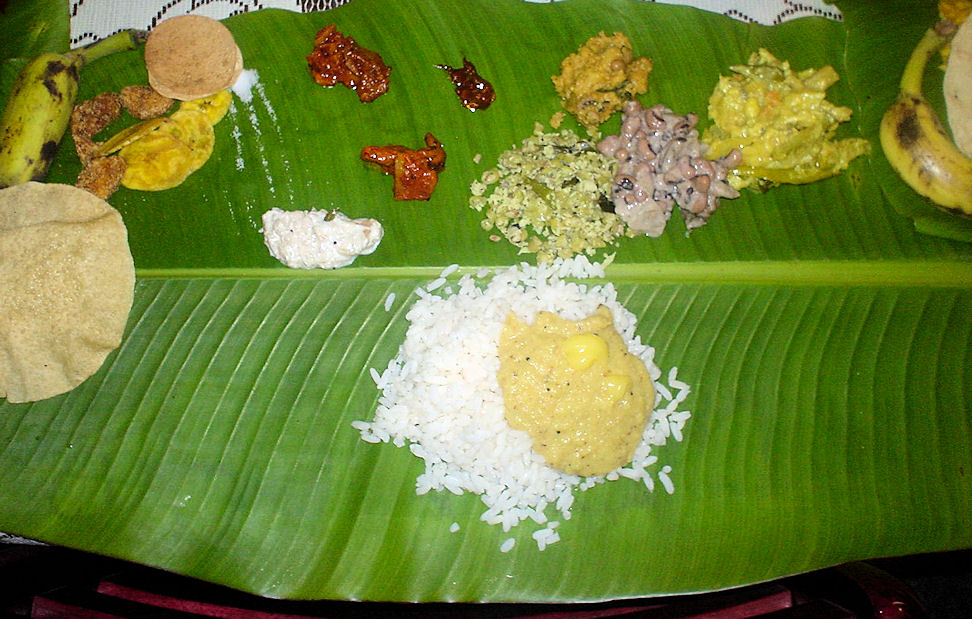
Abb.: निष्ठानानि । Onam Sadya - ഓണം
സദ്യ, Kerala
[Bildquelle: PCNWorld / Wikipedia. -- GNU FDLicense]
Zu vaiśyavargaḥ - Vers 44d - 57b (Kochen III)